
Michelle.M.Weaver@morganstanley.com
M.Wilson@morganstanley.com
Andrew.Pauker@morganstanley.com
Qian.Ding@morganstanley.com
Nick.Lentini@morganstanley.com
MORGAN STANLEY & CO. LLC
Michelle M. Weaver, CFA
EQUITY STRATEGIST
+1 212 296-5254
Michael J Wilson
EQUITY STRATEGIST
+1 212 761-2532
Andrew B Pauker
EQUITY STRATEGIST
+1 212 761-1330
Diane Ding, Ph.D.
QUANTITATIVE STRATEGIST
+1 212 761-6758
Nicholas Lentini, CFA
RESEARCH ASSOCIATE
+1 212 761-5863
Alphabet
American Express
Blackstone
Cheniere Energy
Costco Wholesale
Eaton
Eli Lilly
Estee Lauder
Exxon Mobil
Hilton Worldwide
Intuitive Surgical
JPMorgan Chase
Liberty Formula One
Linde
Lululemon Athletica
MasterCard
Microsoft
Motorola Solutions
MSCI Inc.
NextEra Energy
Nike
Northrop Grumman
Old Dominion Freight Line
Prologis
Raytheon Technologies
Thermo Fisher Scientific
T-Mobile US
UnitedHealth Group
Visa
Yum! Brands
30 for 202530 for 2025 || North America North America
Quality Stocks for a Long-Term
Holding Period
As we contemplate the end of this bear market, we refresh a
cornerstone Morgan Stanley analysis, ‘30 for 2025’: Our best
long-term picks based on the sustainability and quality of the
business model, and opportunity to widen their competitive
advantage.
Our view remains that the current bear market is not over. We expect earnings
to drop well below consensus expectations, with our base case for 2023 at $195.
We believe this will be followed by a stronger earnings picture in 2024.
That said, we have also identified potential cyclical and secular drivers of the
next bull market in equities, including more accommodative monetary policy as
inflation slows; a more stable starting point for consumer balance sheets; pent-
up demand in investment / capex and in certain parts of consumer services; a
global growth recovery led by economies that have lagged since the pandemic;
the reemergence of positive operating leverage; Artificial Intelligence and its
diffusion across sectors; and reshoring.
So, which stocks should investors focus on as we contemplate an end to this
bear market? ‘30 for 2025’ identifies our best long-term picks. Our work has
long supported the view that quality outperforms in the long run. Accordingly,
we asked each of our US analysts to identify the highest-quality companies in
their sectors, the ones likely to strengthen their sustainable competitive
advantage. This report highlights 30 companies that look especially well
positioned.
The main criterion is sustainability — of competitive advantage, business model,
pricing power, cost efficiency, and growth. From more than 50 companies
singled out by our analysts, we narrowed our focus to those that stood out on
these criteria. We paid particular attention to RNOA, management’s strategy,
capital structure, and shareholder remuneration (dividends / buybacks). We also
examined each stock's scores in our Quant Strategy team’s stock selection
models. Additionally, we integrated Environmental, Social, and Governance (ESG)
factors into our decision process, and assessed key risks and opportunities for
each company.
We sought to identify the best franchises, not the most undervalued stocks.
There was no prerequisite that they be rated Overweight, and we were largely
agnostic about their valuations. Our guiding principle was to create a list of
companies whose business models and market positions would be increasingly
differentiated into 2025.
Morgan Stanley does and seeks to do business with
companies covered in Morgan Stanley Research. As a
result, investors should be aware that the firm may have a
conflict of interest that could affect the objectivity of
Morgan Stanley Research. Investors should consider
Morgan Stanley Research as only a single factor in making
their investment decision.
For analyst certification and other important disclosures,
refer to the Disclosure Section, located at the end of this
report.
1
March 21, 2023 04:01 AM GMT

Contributors
2
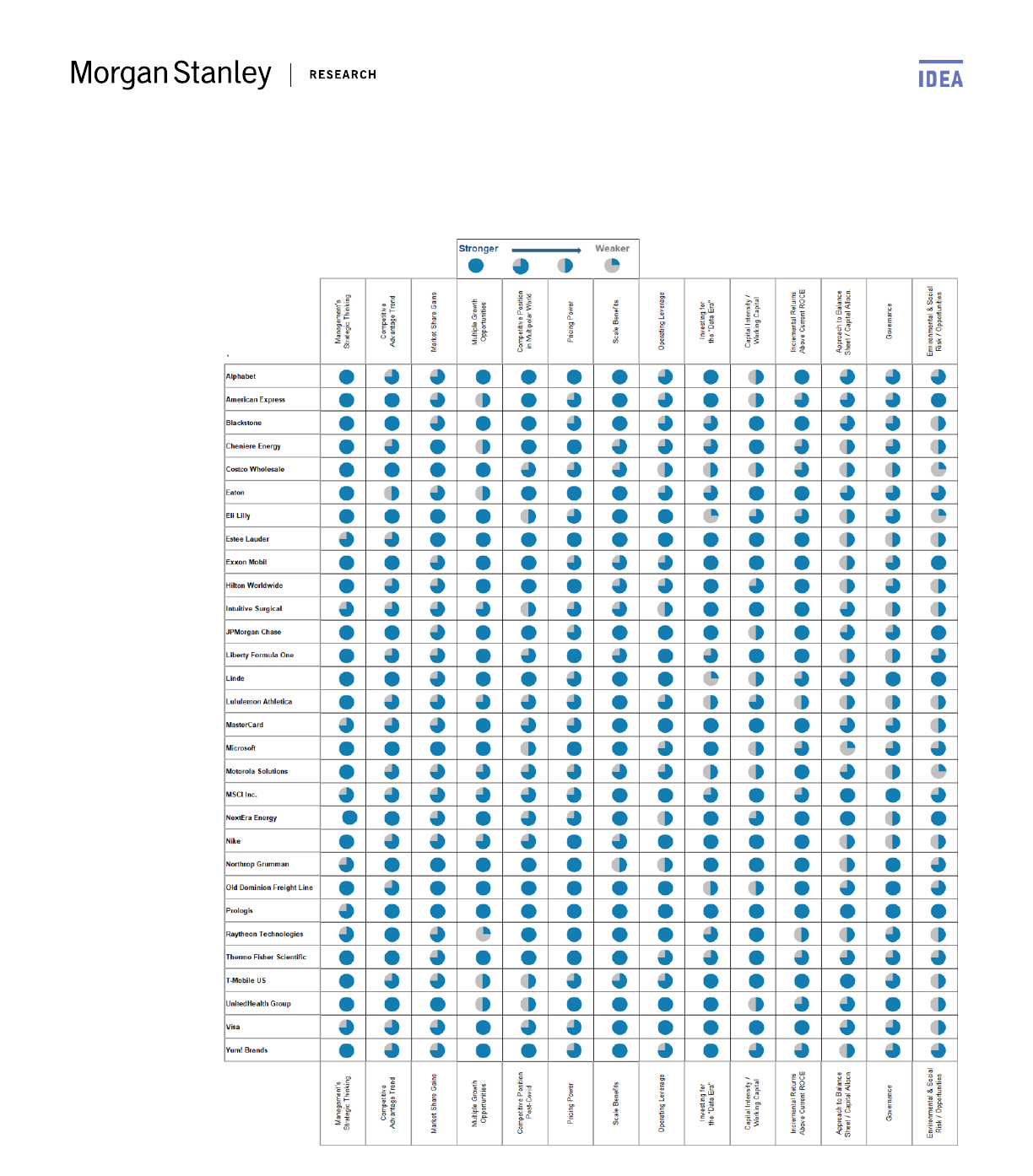
Our Analysts' Assessments
Source: Morgan Stanley Research
3
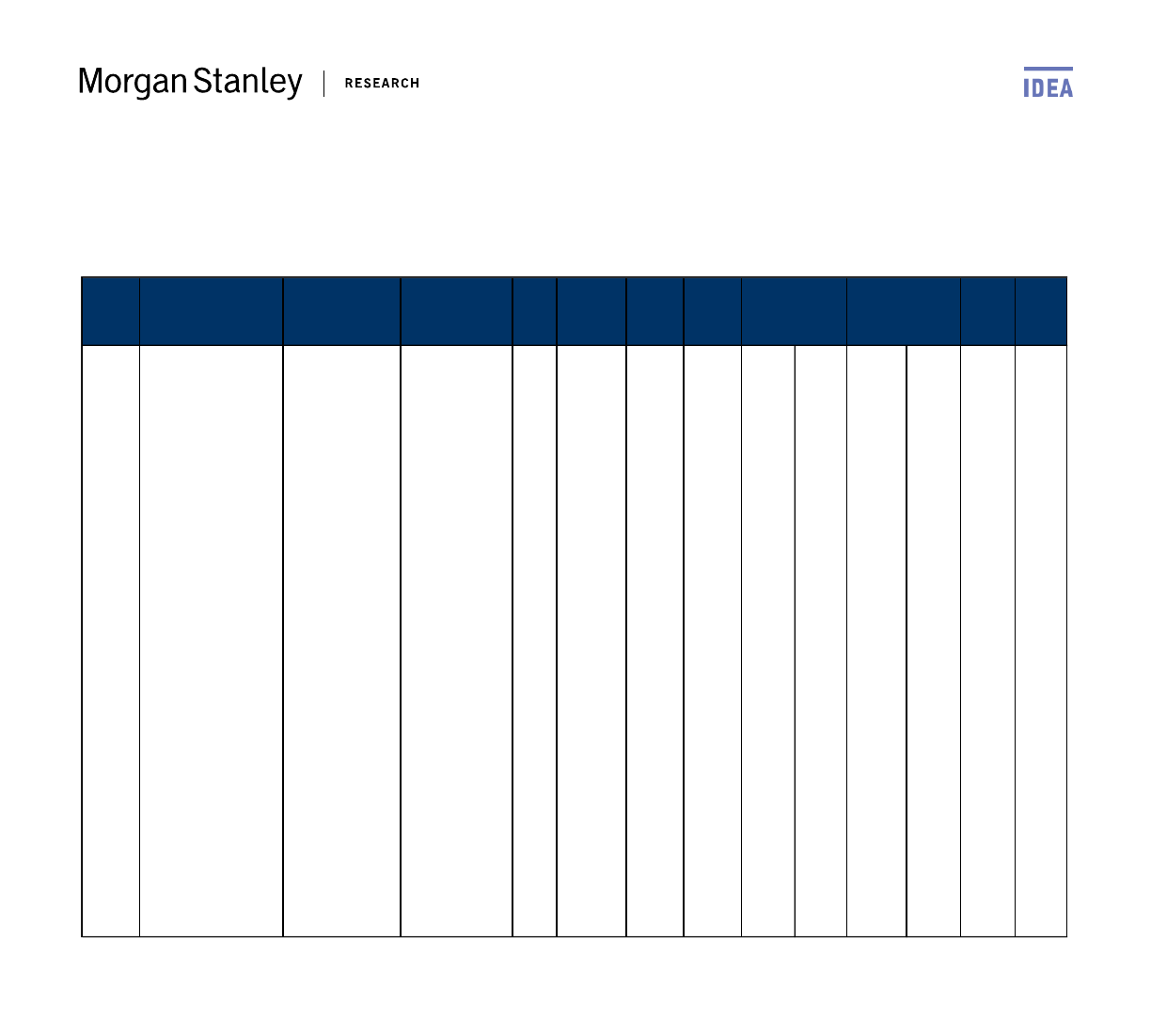
Financial Metrics
Exhibit 1: Financial Metrics
Ticker Company GICS Sector Analyst
Survey
Score
Market Cap
Revenue
5-Yr
CAGR
EPS
5-Yr
CAGR
Net Debt
/ EBITDA
Interest
Cover
('20-25e) ('20-25e) 2023e 2025e 2023e 2025e 2023e 2023e
GOOGL.O Alphabet Inc. Communication Services Nowak, Brian 49 1,306,460 17% 23% 27.4% e 28.5% e 54.3% e 61.7% e NM NM
AXP.N American Express Company Financials Graseck, Betsy 13 116,461 15% 32% NM NM 33.8% e 34.4% e NM NM
BX.N Blackstone Inc. Financials Cyprys, Michael 48 103,369 22% 22% 58.7% e 60.9% e 35.2% e 49.0% e 1.4 e 55.1x
LNG.A Cheniere Energy Inc Energy McDermott, Devin 44 35,062 19% 65% 36.9% e 28.7% e 26.5% e 22.1% e 2.2 e 5.1x
COST.O Costco Wholesale Corp Consumer Staples Gutman, Simeon 39 215,998 10% 14% 3.5% e 3.5% e 29.5% e 30.7% e NM NM
ETN.N Eaton Corporation PLC Industrials Pokrzywinski, Joshua 47 63,822 7% 16% 18.7% e 19.6% e 10.8% e 13.3% e 1.3 e 21.0x
LLY.N Eli Lilly & Co. Health Care Flynn, Terence 42 313,494 11% 15% 30.5% e 40.3% e 35.2% e 55.2% e 1.3 e 68.0x
EL.N Estee Lauder Companies Inc Consumer Staples Mohsenian, Dara 48 83,790 8% 17% 15.3% e 19.8% e 24.6% e 36.2% e 0.7 e 21.8x
XOM.N Exxon Mobil Corporation Energy McDermott, Devin 45 406,447 15% NM 15.6% e 10.5% e 23.5% e 15.8% e NM 91.2x
HLT.N Hilton Worldwide Holdings Inc Consumer Discretionary Grambling, Stephen 46 36,381 22% 141% 25.6% e 26.0% e 27.7% e 32.8% e 2.7 e 6.0x
ISRG.O Intuitive Surgical Inc. Health Care Ranieri, Drew 41 83,291 14% 15% 33.4% e 35.2% e 37.7% e 44.6% e NM NM
JPM.N JPMorgan Chase & Co Financials Graseck, Betsy 13 370,304 5% 12% NM NM 15.2% e 14.0% e NM NM
FWONK.O Liberty Formula One Communication Services Swinburne, Benjamin 47 17,388 28% NM 10.1% e 13.6% e 7.1% e 8.5% e 1.5 e 1.9x
LIN.N Linde PLC Materials Andrews, Vincent 47 162,654 6% 15% 25.3% e 27.6% e 11.9% e 13.5% e 1.3 e 42.5x
LULU.O Lululemon Athletica Inc. Consumer Discretionary Straton, Alex 39 37,609 22% 28% 23.1% e 24.0% e 65.9% e 77.5% e NM NM
MA.N MasterCard Inc Information Technology Faucette, James 47 333,311 16% 21% 58.1% e 59.1% e 78.9% e 128.4% e 0.1 e 36.0x
MSFT.O Microsoft Information Technology Weiss, Keith 46 2,080,022 14% 18% 41.5% e 43.8% e 64.7% e 65.8% e NM NM
MSI.N Motorola Solutions Inc Information Technology Marshall, Meta 39 44,194 8% 12% 27.1% e 29.4% e 40.5% e 46.4% e 1.4 e 11.5x
MSCI.N MSCI Inc. Financials Kaplan, Toni 48 43,001 13% 19% 55.1% e 57.2% e 46.0% e 63.5% e 2.4 e 8.5x
NEE.N NextEra Energy Inc Utilities Arcaro, David 48 150,394 11% 10% 32.2% e 35.0% e 6.5% e 6.7% e 5.1 e 3.2x
NKE.N Nike Inc. Consumer Discretionary Straton, Alex 45 186,672 9% 13% 13.1% e 16.3% e 38.4% e 40.6% e 0.0 e NM
NOC.N Northrop Grumman Corp. Industrials Liwag, Kristine 49 67,894 4% 5% 10.6% e 11.8% e 12.4% e 15.1% e 1.9 e 7.0x
ODFL.O Old Dominion Freight Line Inc Industrials Shanker, Ravi 50 36,480 12% 21% 29.0% e 30.0% e 38.1% e 37.1% e NM 920.5x
PLD.N Prologis, Inc. Real Estate Kamdem, Ronald 55 107,145 14% 10% 40.1% e 39.5% e 4.2% e 4.7% e 3.8 e 5.3x
RTX.N Raytheon Technologies Corp Industrials Liwag, Kristine 43 140,102 5% 17% 12.1% e 13.4% e 6.5% e 8.4% e 2.3 e 6.1x
TMO.N Thermo Fisher Scientific Inc. Health Care Savant, Tejas 50 210,961 10% 9% 23.9% e 24.9% e 13.6% e 16.0% e 1.9 e 22.5x
TMUS.O T-Mobile US, Inc. Communication Services Flannery, Simon 44 173,701 5% 35% 20.4% e 24.1% e 8.7% e 10.7% e 2.5 e 4.9x
UNH.N UnitedHealth Group Inc Health Care Wright, Erin 48 437,971 11% 14% 8.9% e 9.4% e 26.3% e 35.3% e 0.5 e 11.3x
V.N Visa Inc. Information Technology Faucette, James 47 447,433 13% 17% 67.9% e 69.2% e 37.2% e 41.6% e NM 145.0x
YUM.N Yum! Brands, Inc. Consumer Discretionary Harbour, Brian 47 35,532 8% 13% 32.8% e 34.2% e 74.4% e 88.1% e 4.9 e 4.3x
Source: Morgan Stanley Research ModelWare.
Share prices as of March 17th.
Metrics are calculated using the ''for consensus' methodology.
NA = Not Applicable; NM = Not Meaningful
For PLD.N: Numbers in EPS column represent FFO per share.
For BX.N, AXP.N, and JPM.N: Numbers in RNOA column represent ROE numbers.
RNOA (%)
EBIT Margin (%)
4
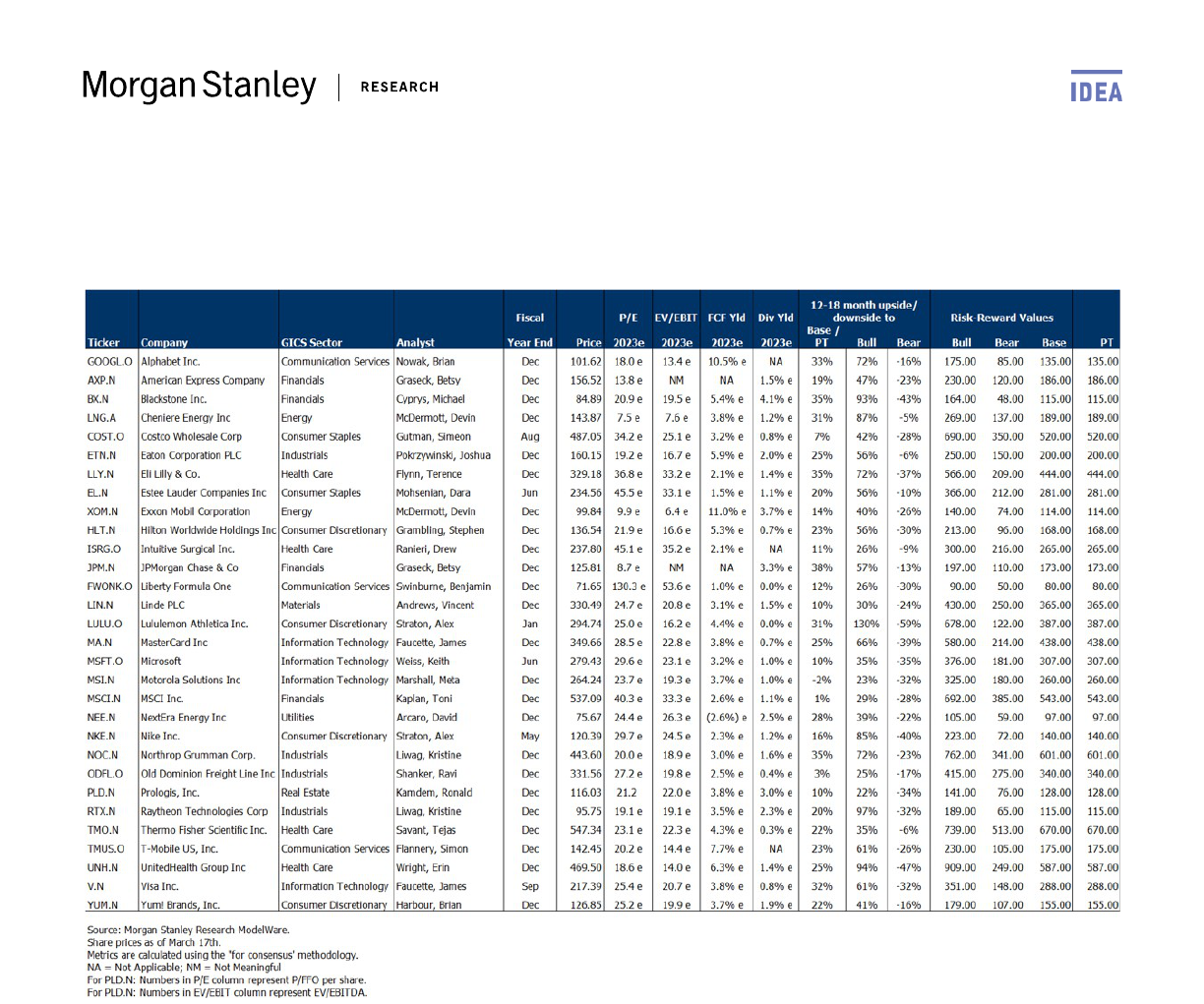
Valuation Metrics
Exhibit 2: Valuation Metrics
5
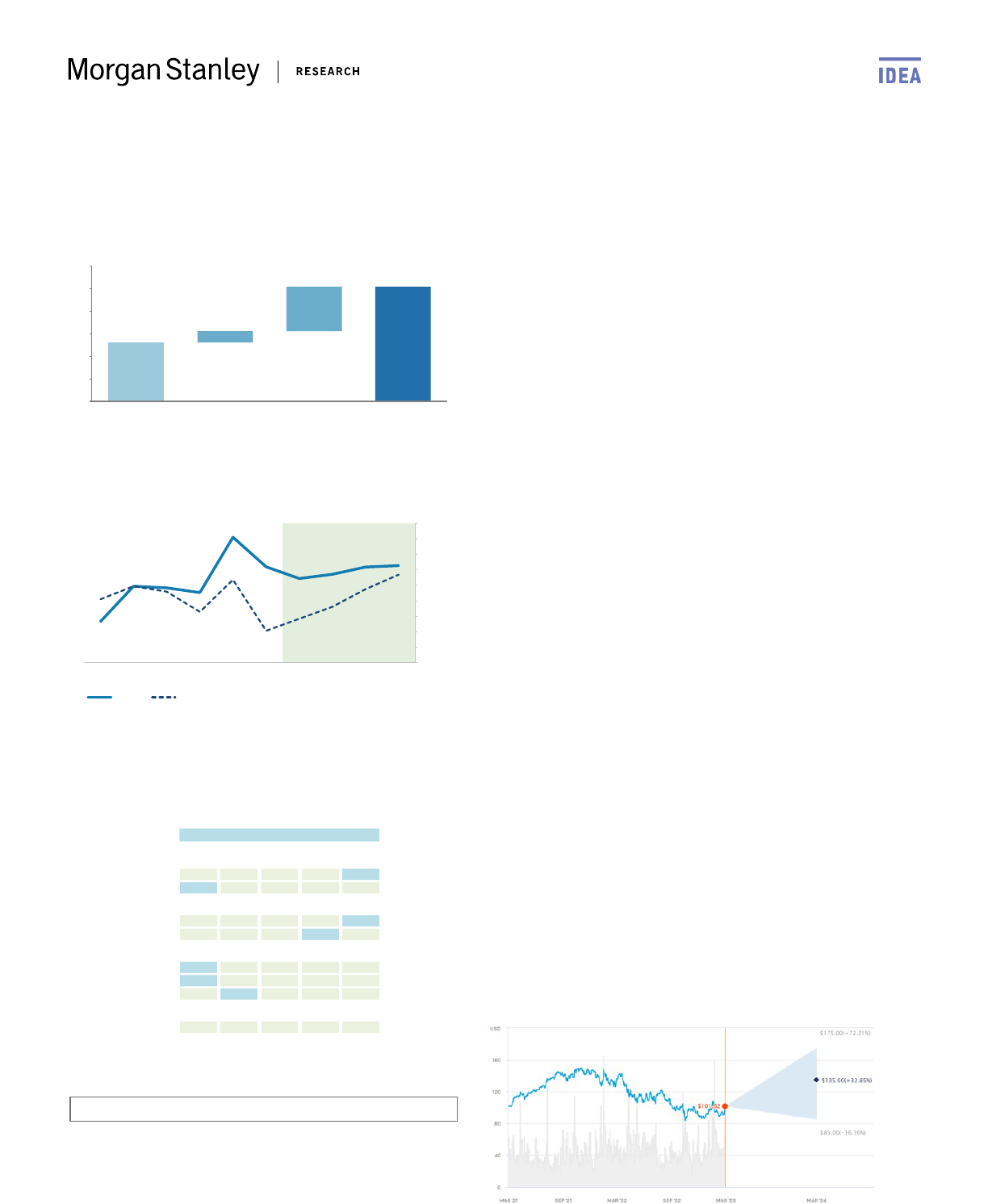
Alphabet (GOOGL)
Value of Growth Analysis
52
102
+10
+39
0
20
40
60
80
100
120
Current Earnings Growth in Explicit Forecast
Period
Long-Term Growth Current Price
Return on Net Operating Assets (RNOA) Analysis
0%
10%
20%
30%
40%
50%
60%
70%
80%
90%
2017 2018 2019 2020 2021 2022 2023 2024 2025 2026
company sector peer median
Sector Yardsticks
Sector Yardsticks
Alphabet Inc. vs. Sector Peers
Peer
percentile range (vs. sector peers) median
Growth
0 20 40 60 80 100
EPS '23-'25 CAGR
21.0%
20.3%
Sales '23-'25 CAGR
14.6%
18.2%
Returns
RNOA
54.3%
28.2%
EBIT margin
27.4%
7.8%
Valuation
P/E
18.0x
18.3x
EV/EBIT
13.4x
16.9x
P/FCF
9.7x
23.5x
Leverage
Net Debt/EBITDA
Alphabet Inc.
Note: Sector Yardstick metrics - Returns: 2023e; Valuation: 2023e; Leverage 2023e. (Net Debt/EBITDA
and P/FCF could be NM) Source: Morgan Stanley Research
Internet Industry View: In-Line
Brian Nowak
The Digital Transformation continues to accelerate, AI is
the next internet opportunity, and there is still a large
addressable market… Behavior shifts seen throughout the
pandemic impacted the way consumers live and businesses
communicate with consumers and we continue to see an
acceleration of this digital transformation in the post-Covid
era. This, combined with the AI opportunity, highlights the
importance of some of GOOGL's key products and
investment areas.
… And GOOGL's product portfolio is well positioned to
benefit from key trends. We continue to see runway from
here for GOOGL's core product offering including Search,
YouTube and Cloud and highlight the significant
incremental Search revenue and share price potential as we
see next generations of AI-driven search leading to higher
relevancy/completeness, a further collapsing of the
shopping funnel (people effectively visiting fewer sites) and
higher user conversion. For YouTube, the platform
continues to evolve with Shorts and we see generative AI
(content creation tools) and improved algorithm matching &
advertising attribution as a potential tailwind to
engagement and revenue growth. Lastly, on Cloud, we see
next generation AI tools driving more durable multi-year
public cloud adoption.
We also remain confident GOOGL faces more manageable
incremental costs. We see management focused on durably
reengineering the cost base and see GOOGL working to
improve AI compute cost efficiency at the infrastructure,
model and application layer, which builds confidence that
margins won't compress over the long term.
Risk Reward: Overweight / Price Target $135
6
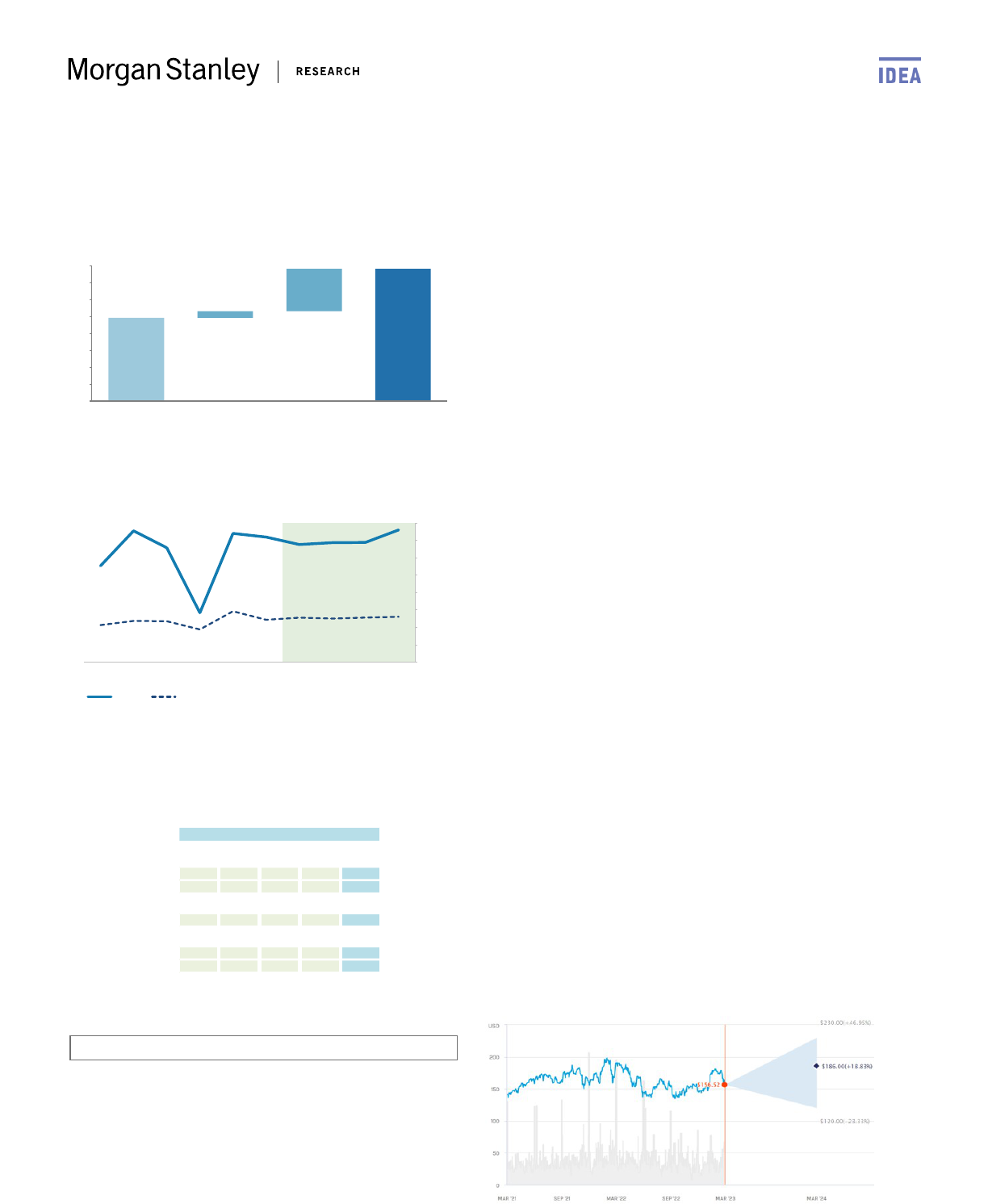
American Express (AXP)
Value of Growth Analysis
99
157
+8
+50
0
20
40
60
80
100
120
140
160
Current Earnings Growth in Explicit Forecast
Period
Long-Term Growth Current Price
Return on Equity (ROE) Analysis
0%
5%
10%
15%
20%
25%
30%
35%
40%
2017 2018 2019 2020 2021 2022 2023 2024 2025 2026
company sector peer median
Sector Yardsticks
Sector Yardsticks
American Express Company vs. Sector Peers
Peer
percentile range (vs. sector peers) median
Growth
0 20 40 60 80 100
EPS '23-'25 CAGR
15.2%
8.0%
Sales '23-'25 CAGR
9.2%
3.8%
Returns
ROE
33.8%
12.7%
Valuation
P/E
13.8x
7.6x
P/B
4.3x
0.8x
American Express Company
Note: Sector Yardstick metrics - Returns: 2023e; Valuation: 2023e. (P/B could be NM) Source: Morgan
Stanley Research
Consumer Finance Industry View: Cautious
Betsy Graseck
Higher credit-quality skew offers downside protection from
consumer credit deterioration. AXP's card book is high
quality, with subprime loans estimated to be 5-10% of loans.
We are more concerned about credit deterioration at more
heavily subprime-exposed card issuers, including
Underweight-rated COF (31%) and SYF (26%). As broader
consumer credit quality continues worsening from here
amid declining savings and high inflation, we expect AXP’s
card losses and delinquencies to only return to pre-Covid
levels by YE24, while card peers are expected to overshoot.
Post-Covid recovery tailwinds provide opportunity for
sustainable topline growth... AXP is well positioned to
benefit from ongoing recovery in corporate T&E spend - still
running 34% below 2019 levels. On the consumer end, we
think AXP's higher-income cardholders will have an easier
time managing this high-inflationary period. We see this card
spend resiliency translating to a ~16% 2022-2025 CAGR in
AXP's card fee income, and strong loan growth from its
customer base. We expect this to drive a ~11% 2022-2025
CAGR in total revenues.
...creating a path for positive operating leverage. Bears
typically point to Amex’s lack of operating leverage,
weighed down by high variable expenses (i.e. card member
rewards). Our forecast for slowing growth in marketing and
cardmember acquisition expenses should help drive ~430bp
operating leverage growth in 2023, its highest in over a
decade and a standout among card peers. We expect
positive operating leverage growth can continue into 2024
as well, even as top-line growth cools.
Risk Reward: Overweight / Price Target $186
7
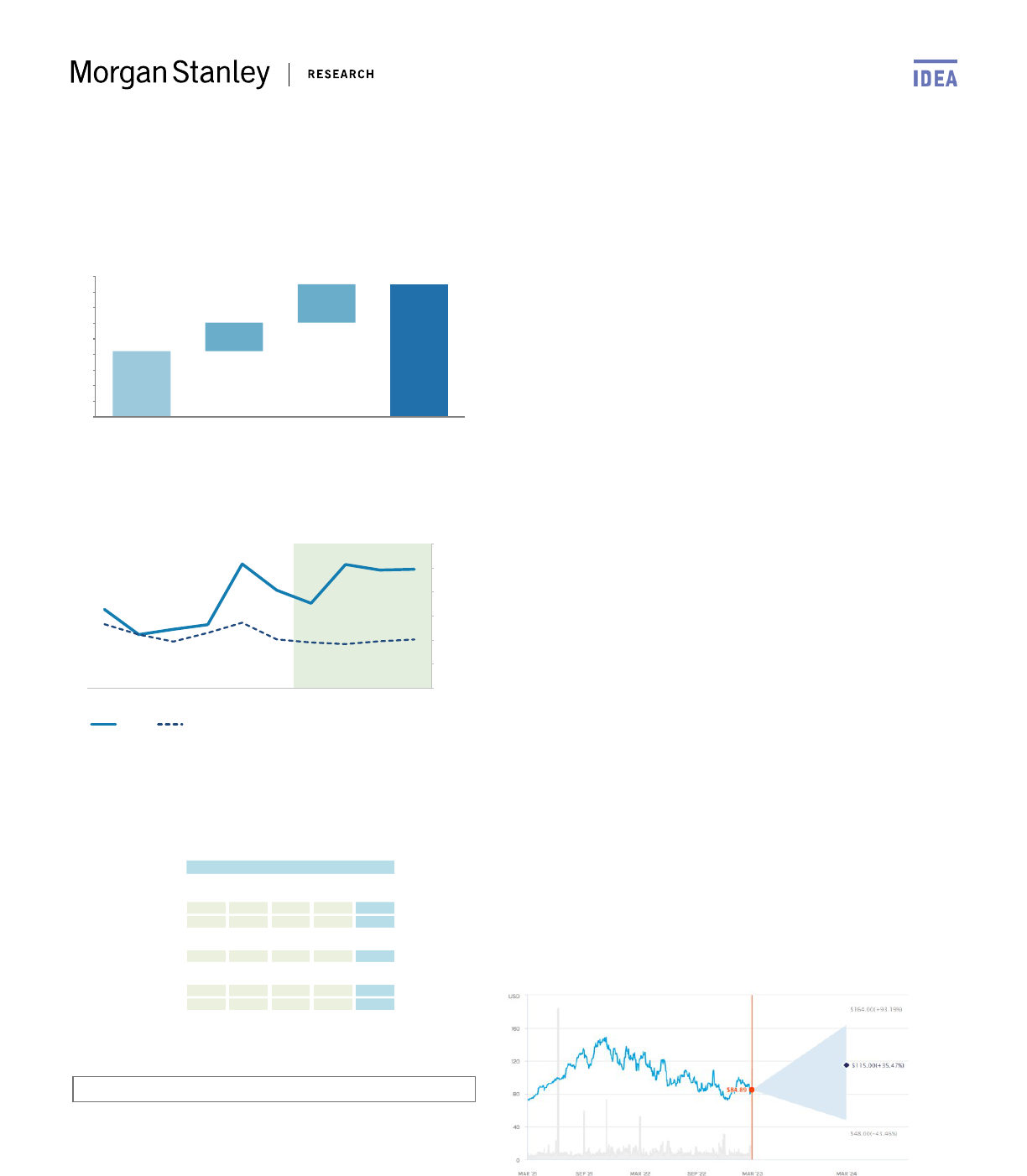
Blackstone (BX)
Value of Growth Analysis
42
85
+18
+24
0
10
20
30
40
50
60
70
80
90
Current Earnings Growth in Explicit Forecast
Period
Long-Term Growth Current Price
Return on Equity (ROE) Analysis
0%
10%
20%
30%
40%
50%
60%
2017 2018 2019 2020 2021 2022 2023 2024 2025 2026
company sector peer median
Sector Yardsticks
Sector Yardsticks
Blackstone Inc. vs. Sector Peers
Peer
percentile range (vs. sector peers) median
Growth
0 20 40 60 80 100
EPS '23-'25 CAGR
31.5%
14.0%
Sales '23-'25 CAGR
30.3%
9.1%
Returns
ROE
35.2%
18.9%
Valuation
P/E
20.9x
16.1x
P/B
11.4x
2.6x
Blackstone Inc.
Note: Sector Yardstick metrics - Returns: 2023e; Valuation: 2023e. (P/B could be NM) Source: Morgan
Stanley Research
Brokers, Asset Managers & Exchanges Ind. View: In-Line
Michael Cyprys
Blackstone is a leading private markets franchise with a
best-in-class brand, unrivalled product capabilities, and
distribution breadth, in our view. BX is increasingly focused
on expanding its TAM, extending into new verticals, and
boosting margins. This should drive sustainable growth
higher than the market appreciates and support a premium
valuation.
Compelling secular grower at an attractive price. We see
powerful secular tailwinds driving increased allocations to
private markets including a ~$70tr retail TAM that's still in
early days of penetration, a large opportunity set of
investable assets, new growth engines, and private markets'
strong track record versus public markets through cycles.
Against this backdrop, we view BX as best positioned to
capture outsized share of a growing pie, particularly as
asset-owner clients and retail platforms target a narrower
set of managers with a breadth of offerings. In retail, BX is
furthest along with a first-mover advantage and industry-
leading distribution capabilities.
Focus on firepower and staying power. BX's long-duration
locked-up capital, ramping permanent capital initiatives, and
over $187b of dry powder should enable the company to
patiently wait for opportunities to time exits and
deployment. We believe this yields significant firepower and
staying power, which, combined with an enviable brand,
should enable BX to navigate through cycles and support
the next wave of growth.
Risk Reward: Overweight / Price Target $115
8
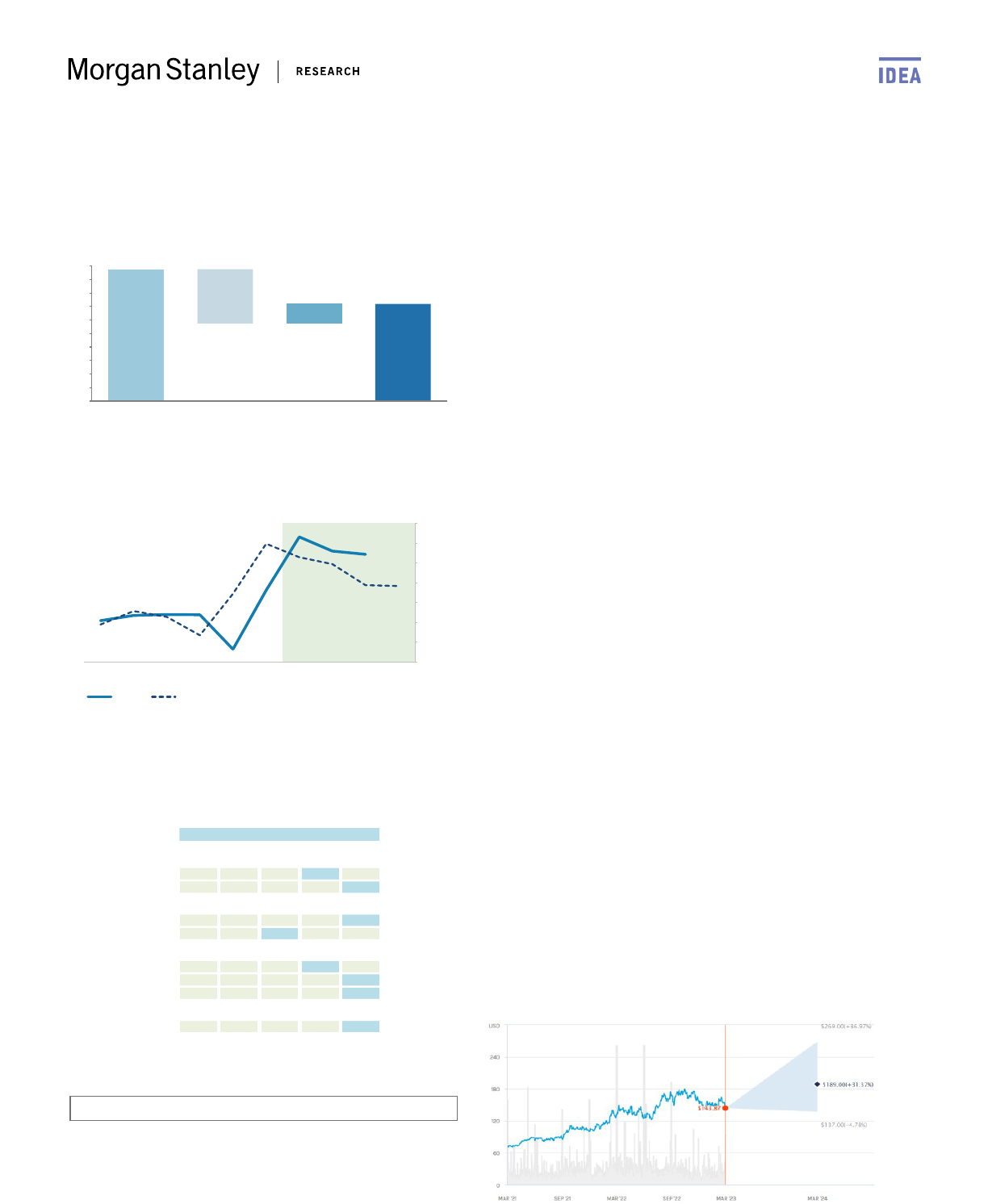
Cheniere Energy (LNG)
Value of Growth Analysis
195
144
-81
+29
0
20
40
60
80
100
120
140
160
180
200
Current Earnings Growth in Explicit Forecast
Period
Long-Term Growth Current Price
Return on Net Operating Assets (RNOA) Analysis
-5%
0%
5%
10%
15%
20%
25%
30%
2017 2018 2019 2020 2021 2022 2023 2024 2025 2026
company sector peer median
Sector Yardsticks
Sector Yardsticks
Cheniere Energy Inc vs. Sector Peers
Peer
percentile range (vs. sector peers) median
Growth
0 20 40 60 80 100
EPS '23-'25 CAGR
-9.3%
-15.2%
Sales '23-'25 CAGR
7.6%
-6.0%
Returns
RNOA
26.5%
21.4%
EBIT margin
36.9%
32.8%
Valuation
P/E
7.5x
6.6x
EV/EBIT
7.6x
5.3x
P/FCF
26.3x
6.8x
Leverage
Net Debt/EBITDA
2.2x
0.5x
Cheniere Energy Inc
Note: Sector Yardstick metrics - Returns: 2023e; Valuation: 2023e; Leverage 2023e. (Net Debt/EBITDA
and P/FCF could be NM) Source: Morgan Stanley Research
Diversified Natural Gas Industry View: In-Line
Devin McDermott
LNG market leader. Cheniere remains the dominant LNG
player in the US and in our view is structurally advantaged
compared to smaller, independent US peers given its scale,
low-cost expansion opportunities, and existing platform of
resilient cash flows backed by long-term contracts. ~95% of
the company’s liquefaction capacity is sold under fixed-price
sales agreements through 2030, supporting stable cash
flow regardless of where LNG prices go (weighted average
contract life of 17 years).
Pathways for growth. Cheniere is currently progressing its
brownfield expansion project at Corpus Christi Stage 3, set
to come online in late 2025. Longer term, the company
plans to formally file with FERC for Corpus Christi Midscale
Trains 8 & 9 by the end of 1Q and recently pre-filed for a
large 20+ mtpa expansion at Sabine Pass. Together with
additional growth projects, Cheniere sees the potential for
~90 mtpa of total liquefaction capacity (from 45 mtpa
today).
Attractive macro supports strong FCF and shareholder
returns. Cheniere is well-positioned to benefit from the
ongoing tightness in global gas markets through strong
marketing margins and additional growth opportunities. At
$10 JKM (Asia LNG), $3.25 Henry Hub, and conservative
$3.50 marketing margins, we forecast run-rate distributable
cash flow of ~$24/sh, a 16% yield on the current stock price.
Over the next several years, resilient FCF should support
declining leverage, growing dividends, and share
repurchases. Cheniere’s attractive shareholder returns
strategy includes 10% annual dividend growth and MSe $2B
of share buybacks in 2023.
Risk Reward: Overweight / Price Target $189
9
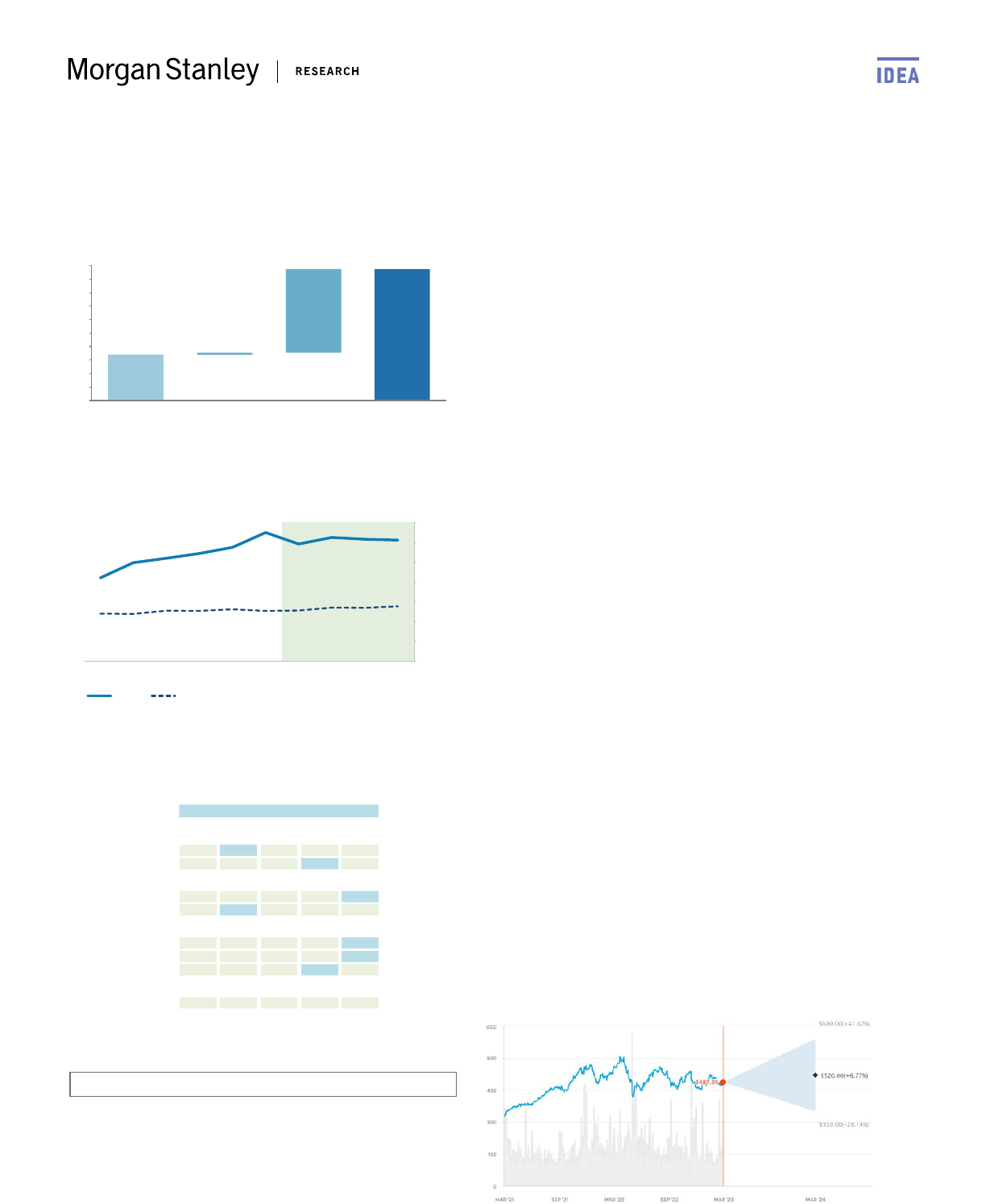
Costco Wholesale (COST)
Value of Growth Analysis
169
487
+8
+310
0
50
100
150
200
250
300
350
400
450
500
Current Earnings Growth in Explicit Forecast
Period
Long-Term Growth Current Price
Return on Net Operating Assets (RNOA) Analysis
0%
5%
10%
15%
20%
25%
30%
35%
2017 2018 2019 2020 2021 2022 2023 2024 2025 2026
company sector peer median
Sector Yardsticks
Sector Yardsticks
Costco Wholesale Corp vs. Sector Peers
Peer
percentile range (vs. sector peers) median
Growth
0 20 40 60 80 100
EPS '23-'25 CAGR
7.8%
9.3%
Sales '23-'25 CAGR
6.2%
4.1%
Returns
RNOA
29.5%
12.7%
EBIT margin
3.5%
4.0%
Valuation
P/E
34.2x
19.3x
EV/EBIT
25.1x
16.9x
P/FCF
31.7x
19.5x
Leverage
Net Debt/EBITDA 1.7x
Costco Wholesale Corp
Note: Sector Yardstick metrics - Returns: 2023e; Valuation: 2023e; Leverage 2023e. (Net Debt/EBITDA
and P/FCF could be NM) Source: Morgan Stanley Research
Hardline/Broadline/Food Retail Industry View: In-Line
Simeon Gutman
One of the best companies in all of Retail, in our view.
COST's differentiated value proposition and the stability of
the club model set it apart. In contrast to most retailers,
customers pay COST for the right to shop in their stores.
That this model continues to work is borne out by strong
membership renewal rates (average of ~89% over the past 5
years, and a record ~90.5% in the most recent quarter). We
believe Covid, inflationary pressures on the consumer, and
gas price volatility have strengthened COST's value
proposition , with likely higher membership stickiness and
spending consolidation at COST relative to past years.
Private label offers differentiation. We estimate COST's
private label brand, Kirkland Signature, has grown to >$75b
in revenue (~35% of total net sales in F22). This lifts COST's
margins (we estimate PL products carry a 1,000 bps gross
margin advantage over branded ones) and protects its
position as a retailer with products found nowhere else.
3 long-term drivers for the stock: (1) We model a a ~2.5%
CAGR in the club base through F25; we see room for at
least 100 more US warehouses (~10 years of domestic
growth), plus >50 potential international warehouses over
the long term. (2) SSS should continue to grow at a mid-
single digit rate, driven by merchandising, consumables, and
eComm. (3) Membership & fee income growth should
continue at ~3%/~8% respectively (their 5-yr averages) as
consumers look to access COST's unique value proposition;
we see potential upside as we believe a membership fee
increase likely in the next 12 months. Alongside
stable/steady EBIT margins, this algo drives our LT outlook
for mid- to- high-single-digit sales, EBIT, and EPS growth.
Risk Reward: Overweight / Price Target $520
10
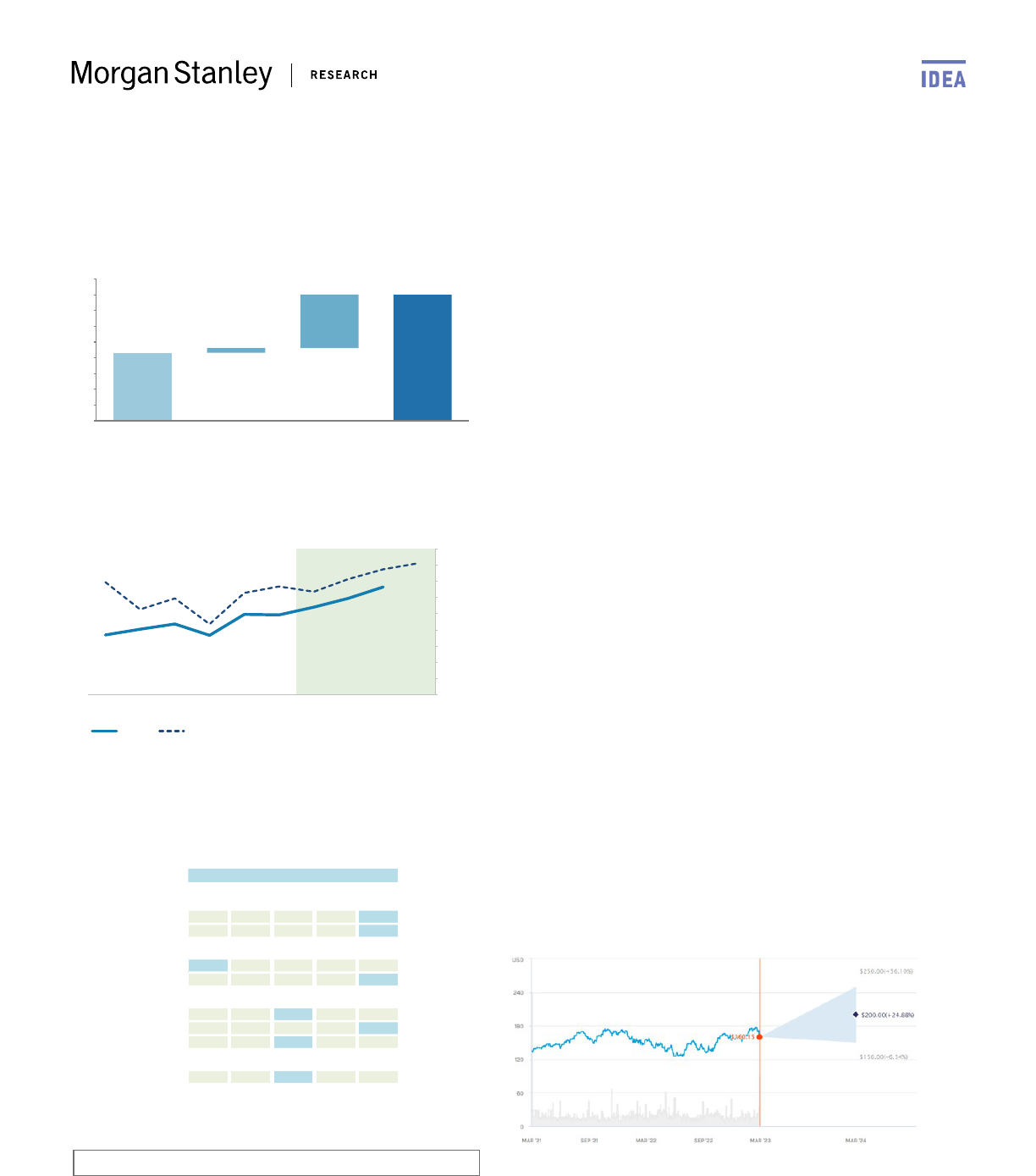
Eaton (ETN)
Value of Growth Analysis
86
160
+6
+68
0
20
40
60
80
100
120
140
160
180
Current Earnings Growth in Explicit Forecast
Period
Long-Term Growth Current Price
Return on Net Operating Assets (RNOA) Analysis
0%
2%
4%
6%
8%
10%
12%
14%
16%
18%
2017 2018 2019 2020 2021 2022 2023 2024 2025 2026
company sector peer median
Sector Yardsticks
Sector Yardsticks
Eaton Corporation PLC vs. Sector Peers
Peer
percentile range (vs. sector peers) median
Growth
0 20 40 60 80 100
EPS '23-'25 CAGR
10.4%
9.7%
Sales '23-'25 CAGR
6.2%
4.6%
Returns
RNOA
10.8%
12.7%
EBIT margin
18.7%
17.2%
Valuation
P/E
19.2x
19.4x
EV/EBIT
16.7x
14.7x
P/FCF
17.2x
19.7x
Leverage
Net Debt/EBITDA
1.3x
1.3x
Eaton Corporation PLC
Note: Sector Yardstick metrics - Returns: 2023e; Valuation: 2023e; Leverage 2023e. (Net Debt/EBITDA
and P/FCF could be NM) Source: Morgan Stanley Research
Multi-Industry Industry View: In-Line
Joshua Pokrzywinski
We believe ETN is uniquely positioned with best-in-class
near-term visibility and long-term growth.
Backlog visibility isn't just high, it's exceptional. ETN's
backlog within its electrical businesses is running 2x higher
than "normal" levels, with close to 60% NTM revenue
coverage. We estimate that orders can decline by 20%+ and
still enter 2025 with above normal visibility / backlog
coverage. With attention turning to the cycle amid a
weakening macro backdrop, we expect ETN's backlog
coverage supports better near-term visibility than most
while also having some of the best long-term growth
drivers in our coverage.
The multiple vectors of energy transition go through
electrical equipment, which are key pieces of infrastructure
to enable electrification. ETN is ~70% electrical exposed
with leading positions in the US low- and medium-voltage
electrical market (~30%+ market share). This is a
consolidated industry with strong pricing power using
proven technology required to connect and control all
manner of electric sources, uses, and storage. Electrification
is already showing up in macro data with electrical growth
accelerating to MSD+ over the past two years and should
drive continued M-HSD growth through 2030. Stimulus,
nearshoring, and backlog conversion likely drive this closer
to HSD over the next few years.
Risk Reward: Overweight / Price Target $200
11

Eli Lilly (LLY)
Value of Growth Analysis
111
329
+76
+141
0
50
100
150
200
250
300
350
Current Earnings Growth in Explicit Forecast
Period
Long-Term Growth Current Price
Return on Net Operating Assets (RNOA) Analysis
0%
10%
20%
30%
40%
50%
60%
70%
2017 2018 2019 2020 2021 2022 2023 2024 2025 2026
company sector peer median
Sector Yardsticks
Sector Yardsticks
Eli Lilly & Co. vs. Sector Peers
Peer
percentile range (vs. sector peers) median
Growth
0 20 40 60 80 100
EPS '23-'25 CAGR
33.8%
0.1%
Sales '23-'25 CAGR
16.9%
2.9%
Returns
RNOA
35.2%
30.6%
EBIT margin
30.5%
30.3%
Valuation
P/E
36.8x
11.9x
EV/EBIT
33.2x
11.9x
P/FCF
47.7x
7.0x
Leverage
Net Debt/EBITDA
1.3x
1.2x
Eli Lilly & Co.
Note: Sector Yardstick metrics - Returns: 2023e; Valuation: 2023e; Leverage 2023e. (Net Debt/EBITDA
and P/FCF could be NM) Source: Morgan Stanley Research
Major Pharmaceuticals Industry View: In-Line
Terence Flynn
Robust new product cycles and limited exposure to loss of
exclusivity (LOE) favorably position LLY within US Pharma.
The company could potentially launch five new products
across four large therapeutic areas by the end of 2023,
including obesity. Trulicity goes off patent later this decade,
but the company should be able to transition the franchise
to Mounjaro.
We expect Mounjaro uptake in type-2 diabetes (T2D) and
expected approval in obesity to drive top-line growth and
margin expansion through the decade. LLY is positioned to
grow revenue at a 10% CAGR from '23-'30 which should
expand margins from 28% in 2022 to >40% in 2025+, driving
EPS growth of 18%, on our estimates. This compares
favorably to the rest of the peer group.
LLY is well positioned to capture significant share in a new
therapeutic TAM. LLY currently splits the GLP-1 injectable
T2D market with Novo (covered by Mark Purcell). Both
companies are competitively positioned to retain a duopoly
as this category of drugs moves into obesity, which we
project as a $50bn+ opportunity. Mounjaro's efficacy profile
in both T2D and obesity will make it a share gainer in the
expanding class. LLY is also developing additional drugs for
T2D and obesity, which position the company to remain
competitive in these areas longer term.
Risk Reward: Overweight / Price Target $444
12
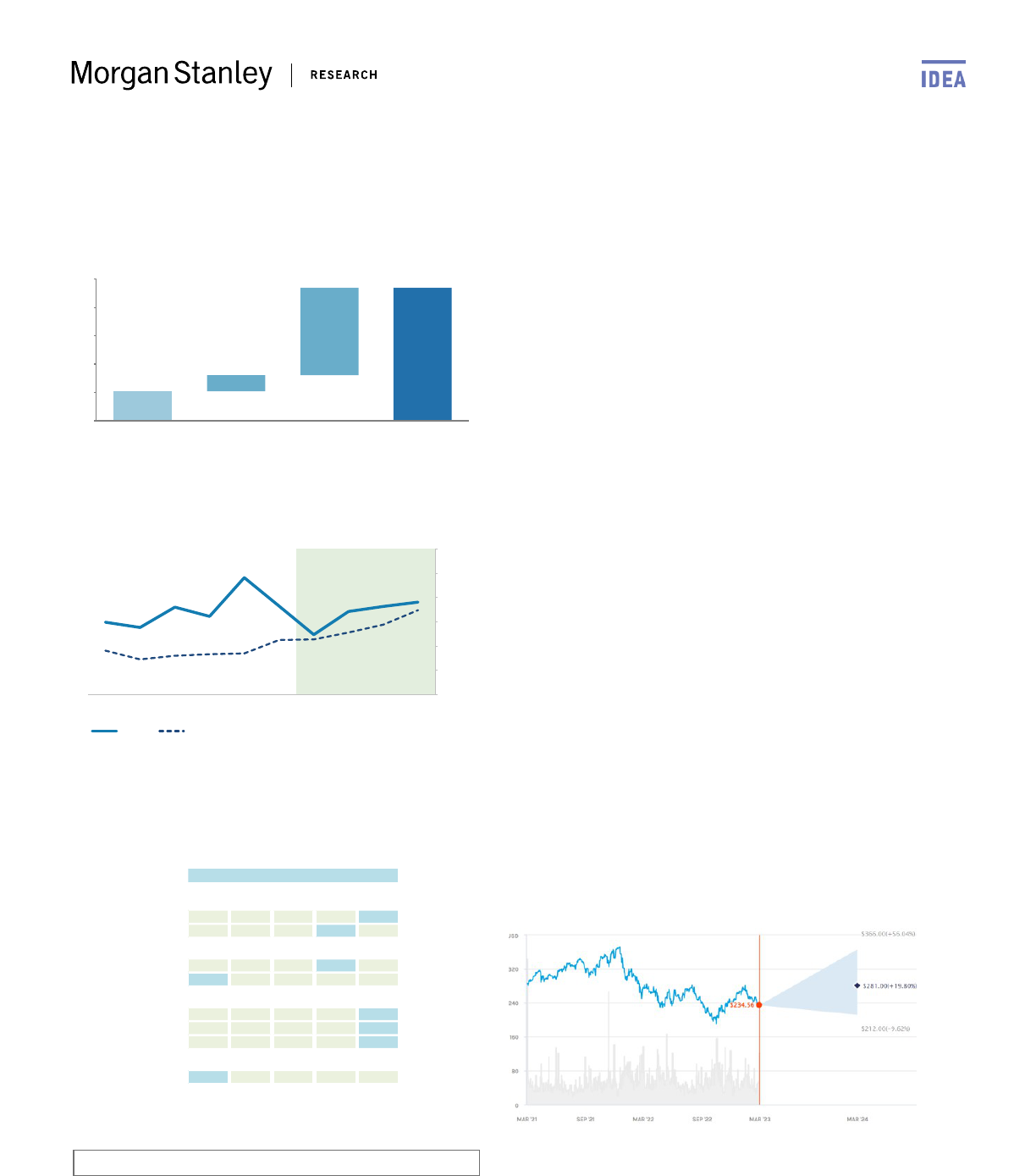
Estée Lauder (EL)
Value of Growth Analysis
52
235
+28
+154
0
50
100
150
200
250
Current Earnings Growth in Explicit Forecast
Period
Long-Term Growth Current Price
Return on Net Operating Assets (RNOA) Analysis
0%
10%
20%
30%
40%
50%
60%
2017 2018 2019 2020 2021 2022 2023 2024 2025 2026
company sector peer median
Sector Yardsticks
Sector Yardsticks
Estee Lauder Companies Inc vs. Sector Peers
Peer
percentile range (vs. sector peers) median
Growth
0 20 40 60 80 100
EPS '23-'25 CAGR
31.1%
14.3%
Sales '23-'25 CAGR
10.5%
5.2%
Returns
RNOA
24.6%
22.7%
EBIT margin
15.3%
19.2%
Valuation
P/E
45.5x
29.1x
EV/EBIT
33.1x
21.1x
P/FCF
66.8x
31.4x
Leverage
Net Debt/EBITDA
0.7x
1.5x
Estee Lauder Companies Inc
Note: Sector Yardstick metrics - Returns: 2023e; Valuation: 2023e; Leverage 2023e. (Net Debt/EBITDA
and P/FCF could be NM) Source: Morgan Stanley Research
Household & Personal Care Industry View: In-Line
Dara Mohsenian
EL is well positioned in prestige beauty with strong
category and geographic growth trends and mix shifts,
opportunities for meaningful margin expansion, and best-
in-class management, in our view.
Post-Covid Beauty Rebound. We are confident in the
sustainability of the post-Covid beauty rebound, with long-
term prestige beauty category growth in the HSD% range,
with continued premiumization, a growing middle class
emerging in emerging markets, a larger pie post-Covid for
travel retail with Hainan development, and continued e-
commerce strength with technological advancements.
Growth and Margin Expansion Opportunity. EL has
benefited from a long-term mix shift to higher growth and
higher margin areas (China, travel retail, e-commerce, and
skin care) that have been artificially depressed by Covid and
should re-emerge as a key investment thesis recovering to
its LT growth algorithm.
Consensus Assumes L-MSD% Growth. Consensus only
forecasts 3-4% revenue CAGR's vs. a pre-Covid period
looking out over the next two years, seemingly too low if
China fully recovers relative to outsized MSD-HSD LT
prestige beauty category growth (to which EL is 100%
exposed).
Risk Reward: Overweight / Price Target $281
13
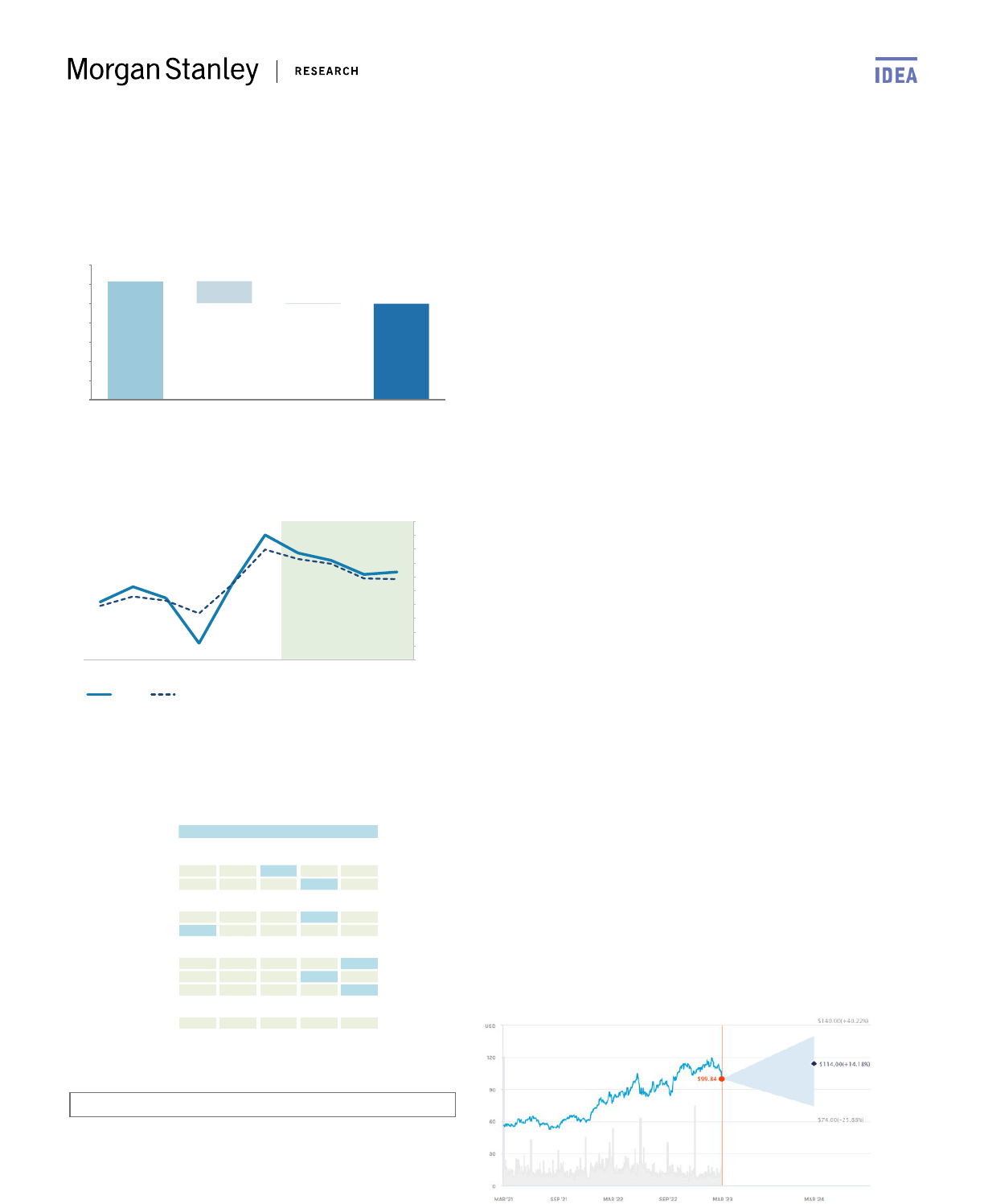
Exxon Mobil (XOM)
Value of Growth Analysis
123
100
-23
-1
0
20
40
60
80
100
120
140
Current Earnings Growth in Explicit Forecast
Period
Long-Term Growth Current Price
Return on Net Operating Assets (RNOA) Analysis
-15%
-10%
-5%
0%
5%
10%
15%
20%
25%
30%
35%
2017 2018 2019 2020 2021 2022 2023 2024 2025 2026
company sector peer median
Sector Yardsticks
Sector Yardsticks
Exxon Mobil Corporation vs. Sector Peers
Peer
percentile range (vs. sector peers) median
Growth
0 20 40 60 80 100
EPS '23-'25 CAGR
-15.6%
-15.2%
Sales '23-'25 CAGR
-3.4%
-6.0%
Returns
RNOA
23.5%
21.4%
EBIT margin
15.6%
32.8%
Valuation
P/E
9.9x
6.6x
EV/EBIT
6.4x
5.3x
P/FCF
9.3x
6.8x
Leverage
Net Debt/EBITDA 0.5x
Exxon Mobil Corporation
Note: Sector Yardstick metrics - Returns: 2023e; Valuation: 2023e; Leverage 2023e. (Net Debt/EBITDA
and P/FCF could be NM) Source: Morgan Stanley Research
Integrated Energy Industry View: Attractive
Devin McDermott
Competitive positioning. XOM’s strong FCF profile is
supported by an advantaged portfolio of high return
growth projects. These investments, coupled with ongoing
execution on >$9B of cost cuts ($6.9B to date with an
additional ~$2B through 2023), should allow the company
to double earnings capacity by 2027 (vs. 2019). Robust FCF
supports ~300% dividend cover in 2023 and ~$35B of share
repurchases across 2023-24. In total, XOM offers a ~8%
2023 shareholder return yield (~$85/bbl WTI), with the
potential for further upside.
Low-carbon opportunities. XOM is also an industry leader
in decarbonization, focusing on technologies that are
synergistic with core competencies including carbon capture
& storage (CCS), hydrogen, and renewable fuels. The
company has cumulatively captured more carbon than any
company (40% of the global total) and has a near-term
pipeline of ~20 CCS projects. Moreover, XOM is advancing a
blue hydrogen plant in the US Gulf Coast and targeting
~200 kbbl/d of lower-emission fuels production by 2030.
We forecast a 15% average return on capital will deliver
~$4B in low-carbon earnings by 2030 and ~$8B by 2035.
Sustainable long-term growth. XOM’s diversified business,
resilient FCF, and strong balance sheet support continued
investments in high return opportunities across the Energy
value chain. In addition to benefitting from what we expect
to be a multi-year period of strong oil & gas prices, XOM's
proactive (but still returns focused) decarbonization
strategy should help de-risk longer term cash flows and
mitigate terminal value uncertainty – offsetting the impact
of longer-term erosion in oil & gas demand.
Risk Reward: Overweight / Price Target $114
14

Hilton Worldwide (HLT)
Value of Growth Analysis
55
137
+11
+71
0
20
40
60
80
100
120
140
Current Earnings Growth in Explicit Forecast
Period
Long-Term Growth Current Price
Return on Net Operating Assets (RNOA) Analysis
-10%
-5%
0%
5%
10%
15%
20%
25%
30%
35%
2017 2018 2019 2020 2021 2022 2023 2024 2025 2026
company sector peer median
Sector Yardsticks
Sector Yardsticks
Hilton Worldwide Holdings Inc vs. Sector Peers
Peer
percentile range (vs. sector peers) median
Growth
0 20 40 60 80 100
EPS '23-'25 CAGR
14.3%
17.9%
Sales '23-'25 CAGR
5.8%
6.2%
Returns
RNOA
27.7%
13.1%
EBIT margin
25.6%
16.4%
Valuation
P/E
21.9x
20.9x
EV/EBIT
16.6x
16.6x
P/FCF
20.2x
16.1x
Leverage
Net Debt/EBITDA
2.7x
2.7x
Hilton Worldwide Holdings Inc
Note: Sector Yardstick metrics - Returns: 2023e; Valuation: 2023e; Leverage 2023e. (Net Debt/EBITDA
and P/FCF could be NM) Source: Morgan Stanley Research
Gaming & Lodging Industry View: In-Line
Stephen Grambling, CFA
HLT is poised to benefit from secular growth of travel and
gain share all within a capital-light model with a best in-
class management team.
Beneficiary of long-term demand trends: We expect lodging
to continue to grow above GDP: (1) rising consumer incomes
= higher share of spend on travel; and (2) shifts from
industrial to service based economies = higher corporate
travel. HLT's scale also creates more efficient distribution
and higher revenue for hotel owners, enabling share gains
from independent and sub-scale peers.
HLT's asset light model limits volatility, maximizes ROIC.
HLT generates >85% of EBITDA from fees, which are largely
tied to the top line of hotels rather than profitability. When
combined with limited G&A and capex, HLT has highly visible
fundamentals. During the pandemic, EBITDA declined less
than revenue and FCF stayed positive.
FCF Compounder: With one of the highest in-construction
pipelines (18% growth vs. current), we expect the company
to deliver 5%+ growth over the next three years (with new
"Spark" brand offering potential for 6-7%). Therefore, even if
RevPAR growth is modest, room growth should propel EPS
at 20%+ and FCF 15%+ from 2022-24. Note the company's
growth and margins are understated in our metrics table
due to reimbursed revenue. Excluding these, HLT's 2020-
2025 revenue CAGR is 24% and 2023/2025 EBIT margins are
61%/64%, pushing the company even further up the
rankings.
Risk Reward: Overweight / Price Target $168
15
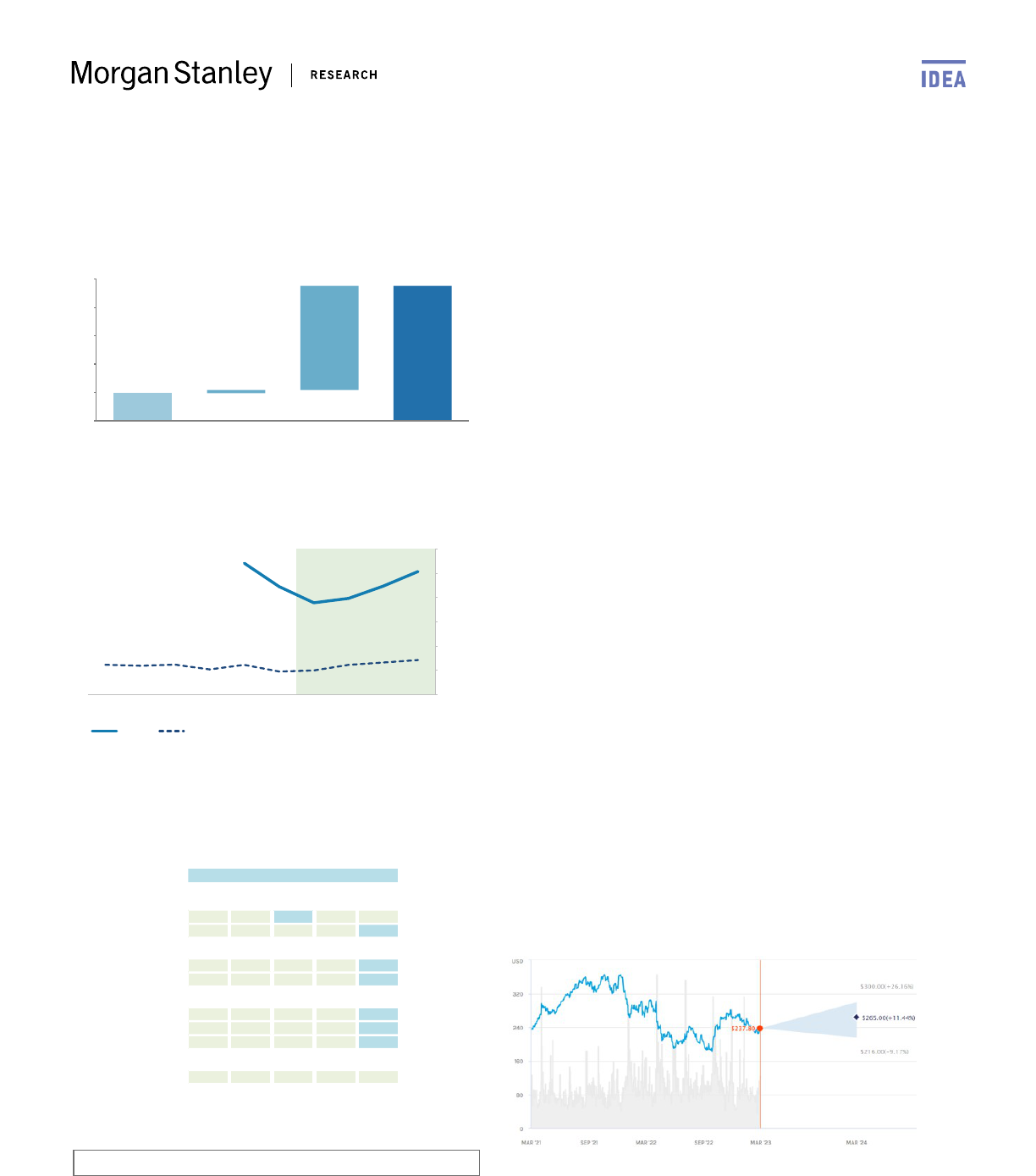
Intuitive Surgical (ISRG)
Value of Growth Analysis
49
238
+5
+184
0
50
100
150
200
250
Current Earnings Growth in Explicit Forecast
Period
Long-Term Growth Current Price
Return on Net Operating Assets (RNOA) Analysis
0%
10%
20%
30%
40%
50%
60%
2017 2018 2019 2020 2021 2022 2023 2024 2025 2026
company sector peer median
Sector Yardsticks
Sector Yardsticks
Intuitive Surgical Inc. vs. Sector Peers
Peer
percentile range (vs. sector peers) median
Growth
0 20 40 60 80 100
EPS '23-'25 CAGR
12.8%
12.8%
Sales '23-'25 CAGR
11.3%
6.2%
Returns
RNOA
37.7%
9.9%
EBIT margin
33.4%
24.2%
Valuation
P/E
45.1x
25.2x
EV/EBIT
35.2x
19.6x
P/FCF
47.9x
32.3x
Leverage
Net Debt/EBITDA 1.4x
Intuitive Surgical Inc.
Note: Sector Yardstick metrics - Returns: 2023e; Valuation: 2023e; Leverage 2023e. (Net Debt/EBITDA
and P/FCF could be NM) Source: Morgan Stanley Research
Medical Technology Industry View: In-Line
Drew Ranieri
One of the most innovative companies in Medical
Technology. We see Intuitive as a best-in-class enabler of
minimally invasive surgical innovation with a broad portfolio
of robotic surgery technology. Intuitive has the dominant
market position, though competitive systems are in early
innings. Still, we believe Intuitive's substantial global
installed base (>7,500 systems), large active (and trained)
surgeon base, and building ecosystem will entrench the
company's dominant position for years to come. We see
potentially open-ended opportunities to augment robotic
systems by developing digital capabilities and data insights,
which could further enhance Intuitive's offering and likely
provide stickier market share positioning.
A large and growing TAM that we think remains under-
penetrated. Worldwide robotics surgery penetration stands
at 5-6% after multiple decades on the market. Over 1.8mn
procedures were performed worldwide on Intuitive's da
Vinci systems in '22 ('17-'22 CAGR: 16%). Based on existing
clinical applications and geographies, the company has line
of sight to 6mn procedures, with opportunities to 4x the
market size with new technologies, indications and entry
into new geographies over time. Newer platforms (Ion and
SP) open access to additional markets and procedures.
Hospitals are increasingly establishing robotics programs,
and standardizing practices around Intuitive's technology
and building additional robotic procedure capacity.
Risk Reward: Overweight / Price Target $265
16
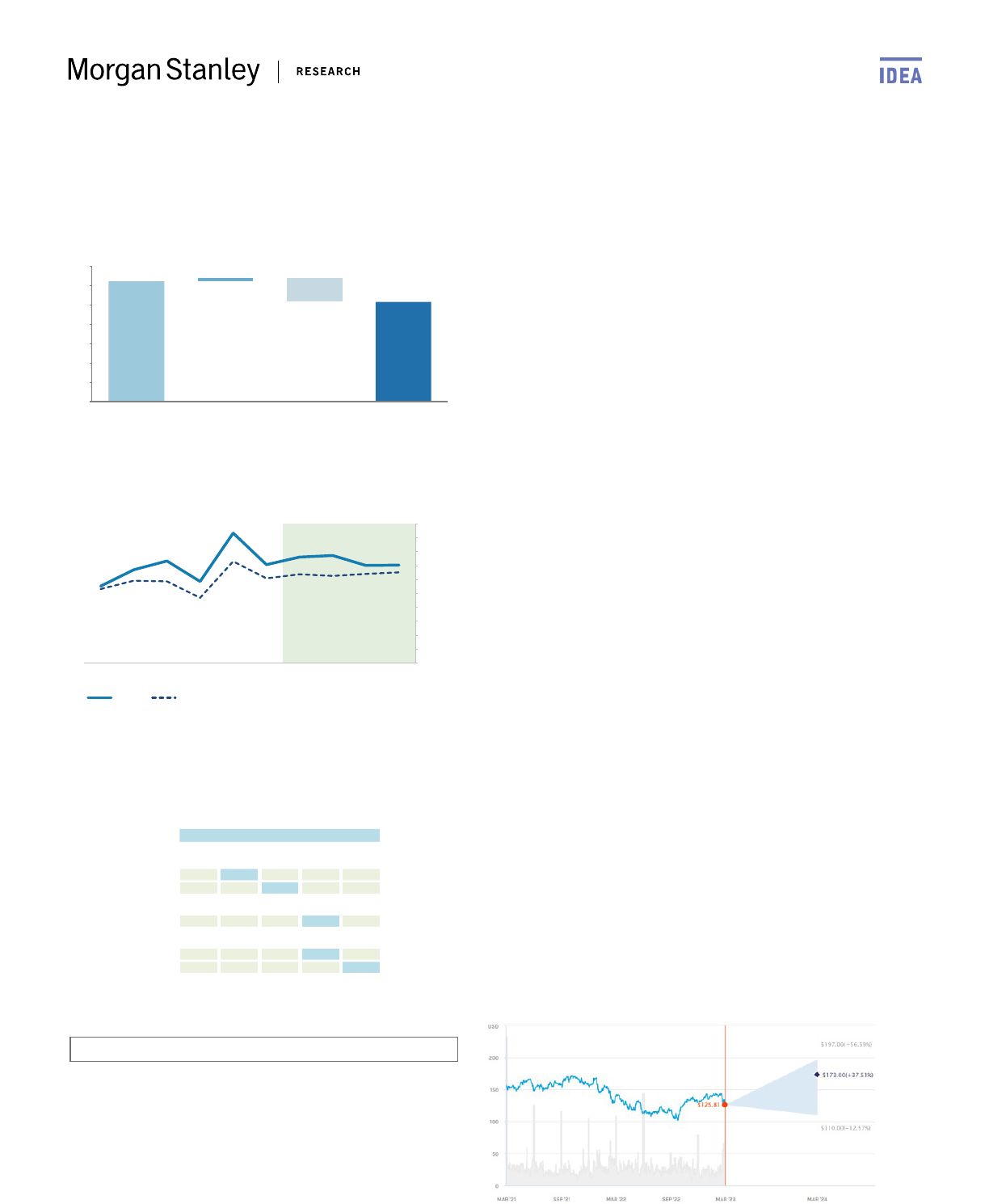
JPMorgan Chase & Co (JPM)
Value of Growth Analysis
131
126
+1
-6
100
105
110
115
120
125
130
135
Current Earnings Growth in Explicit Forecast
Period
Long-Term Growth Current Price
Return on Equity (ROE) Analysis
0%
2%
4%
6%
8%
10%
12%
14%
16%
18%
20%
2017 2018 2019 2020 2021 2022 2023 2024 2025 2026
company sector peer median
Sector Yardsticks
Sector Yardsticks
JPMorgan Chase & Co vs. Sector Peers
Peer
percentile range (vs. sector peers) median
Growth
0 20 40 60 80 100
EPS '23-'25 CAGR
5.2%
8.0%
Sales '23-'25 CAGR
3.3%
3.8%
Returns
ROE
15.2%
12.7%
Valuation
P/E
8.7x
7.6x
P/B
1.3x
0.8x
JPMorgan Chase & Co
Note: Sector Yardstick metrics - Returns: 2023e; Valuation: 2023e. (P/B could be NM) Source: Morgan
Stanley Research
Large Cap Banks Industry View: In-Line
Betsy Graseck
Positive operating leverage in 2023. We model JPM
delivering 400bps of positive operating leverage in 2023,
with revenues up 12% and expenses up 8% y/y. This is a
significant inflection from the last two years of negative
operating leverage at JPM (-510bps in 2021, -40bps in 2022).
In addition, while Jamie Dimon has made it clear that he
believes in investing through a cycle as reflected in JPM's
industry leading $14.1B tech budget, we think risks around
expenses skew positively. Areas to pull back on expenses
include low priority projects, market-related revenues in the
custody business, opportunities to flex on mortgage-related
expenses, and revenue-related comp in the Corporate &
Institutional Bank.
Consumer & Community Bank (CCB) is taking deposit
share. JPM is taking deposit share across the country with
median deposit share up 1.5% across the Top 50 US MSAs
over the last 5 years and median 3.1% across the Top 25 US
MSAs. This reflects JPM executing on 500 new branch
builds since 2017 including 300 branches in new markets
including Boston, DC, Philadelphia, Minneapolis, and
Baltimore, with the goal of becoming a scale player (we
think ~10% or greater share) in each of these markets. We
think JPM should continue to take share as 20% of its
branch network is <10 years old, significantly higher than
industry average of 12% and big bank average of mid-single
digits.
JPM de-rates less than peers in recessions. Looking at the
last four recessions (2001-02, 2008-10, 2016 recession
fears, 2020), JPM's NTM Consensus PE troughed at 7.5-9.2x,
above BAC's trough range of 6.1-9.2x and Citi's of 4.3-7.5x.
Risk Reward: Overweight / Price Target $173
17
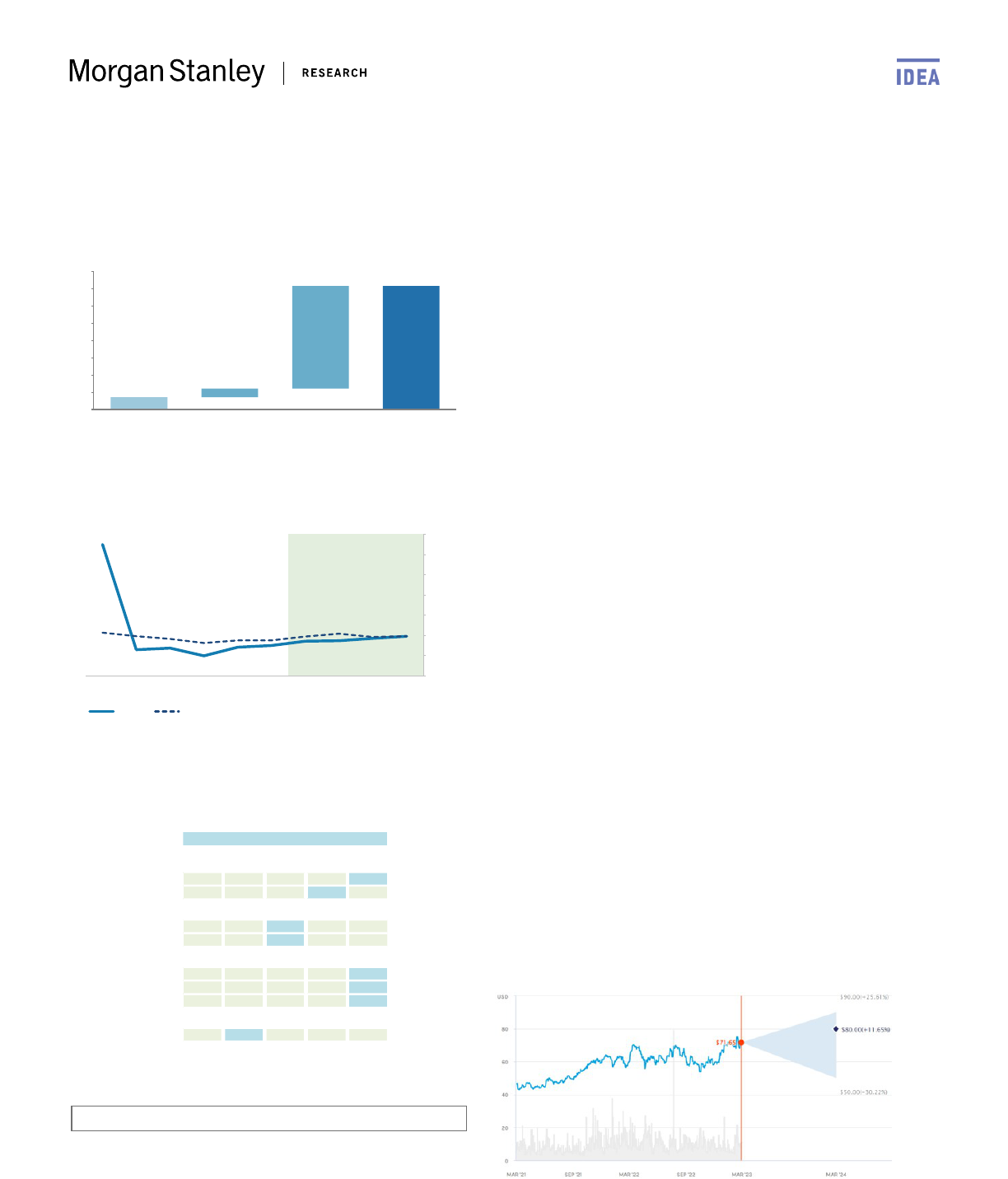
Liberty Formula One (FWONK)
Value of Growth Analysis
7
72
+5
+60
0
10
20
30
40
50
60
70
80
Current Earnings Growth in Explicit Forecast
Period
Long-Term Growth Current Price
Return on Net Operating Assets (RNOA) Analysis
-10%
0%
10%
20%
30%
40%
50%
60%
2017 2018 2019 2020 2021 2022 2023 2024 2025 2026
company sector peer median
Sector Yardsticks
Liberty Formula One vs. Sector Peers
Peer
percentile range (vs. sector peers) median
Growth
0 20 40 60 80 100
EPS '23-'25 CAGR
69.2%
13.0%
Sales '23-'25 CAGR
6.6%
5.2%
Returns
RNOA
7.1%
9.4%
EBIT margin
10.1%
10.0%
Valuation
P/E
130.3x
17.6x
EV/EBIT
53.6x
18.2x
P/FCF
98.7x
14.2x
Leverage
Net Debt/EBITDA
1.5x
3.7x
Liberty Formula One
Note: Sector Yardstick metrics - Returns: 2023e; Valuation: 2023e; Leverage 2023e. (Net Debt/EBITDA
and P/FCF could be NM) Source: Morgan Stanley Research
Media & Entertainment Industry View: In-Line
Benjamin Swinburne
Investment Outlook: Our Overweight on FWONK reflects
(1) our bullish view on sports as an asset class, (2) F1's rising
global popularity and its ability to monetize that growth,
and (3) a preference for contracted revenues (defensive
growth) given the current macroeconomic uncertainty.
F1 continued to see its popularity rise in 2022, especially in
the US: The bull case on F1, in our view, includes
exponentially increasing its earnings in the world's largest
media market - the US - over the long term. Despite cord-
cutting lowering pay-TV distribution by 15-20% since 2017,
F1 linear ratings in the US were up ~15% on a CAGR basis
during this time frame and nearly 20% in '22 vs. '21. Globally,
F1 saw a cumulative TV audience of 1.54bn or 70mm per
race on average last year.
We see premium multiple on FWONK shares persisting: F1's
growth outlook (10-15% adjusted EBITDA CAGR through
2026, on our estimates), contracted nature of its business
model (its primary F1 revenues are almost entirely built on
multi-year contracts), and its high FCF conversion (~80% of
adjusted F1 OpCo EBITDA converted to FCF in '22) support a
premium multiple.
Las Vegas Grand Prix a potential catalyst for shares: As the
promoter in Las Vegas, F1's economics are different relative
to the rest of the calendar. While we do not see Liberty
pursuing a promoter position across the entire F1 race
calendar, we see both direct and indirect benefits to F1's
earnings power from success in Vegas.
Risk Reward: Overweight / Price Target $80
18
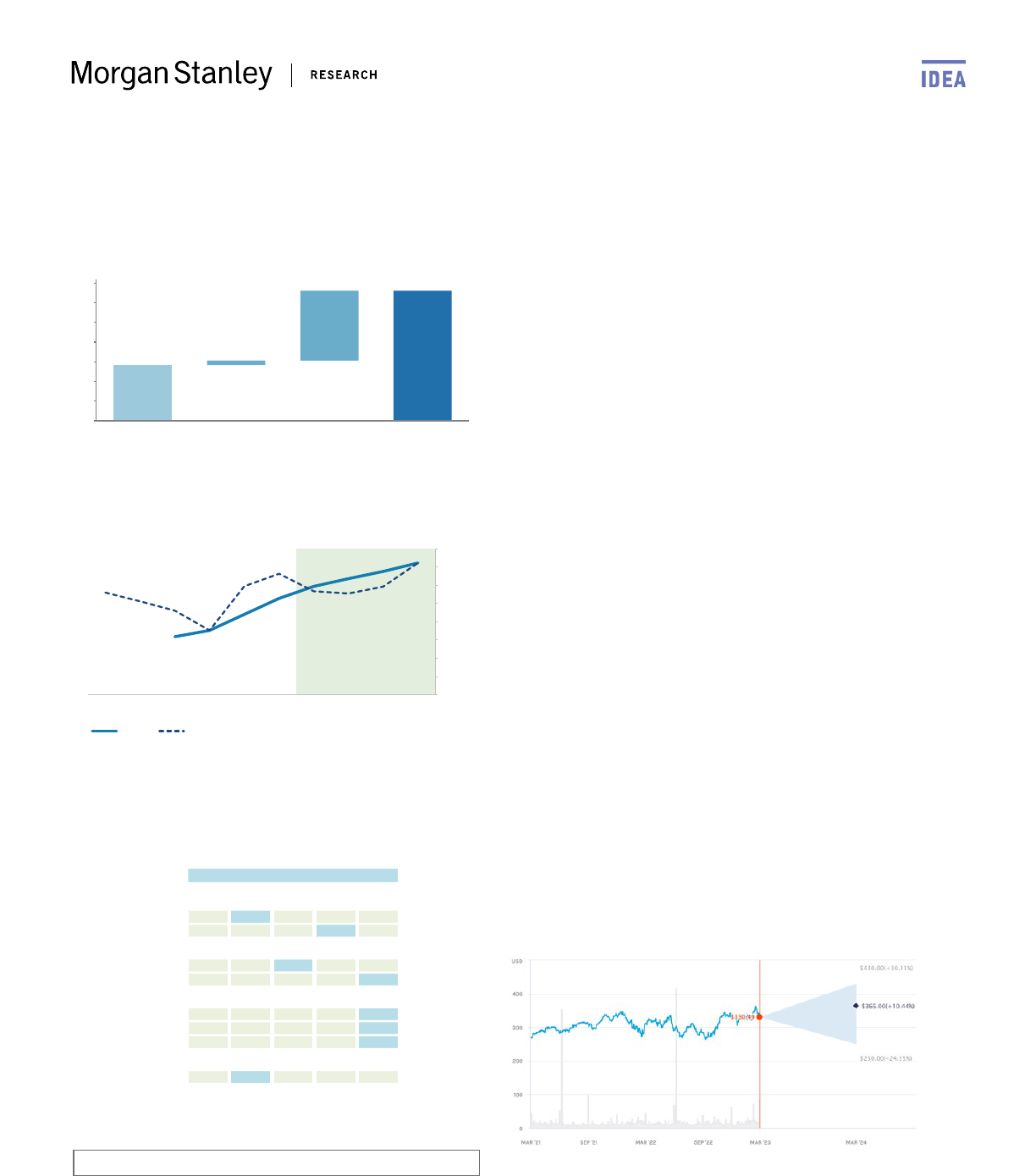
Linde (LIN)
Value of Growth Analysis
142
330
+11
+178
0
50
100
150
200
250
300
350
Current Earnings Growth in Explicit Forecast
Period
Long-Term Growth Current Price
Return on Net Operating Assets (RNOA) Analysis
0%
2%
4%
6%
8%
10%
12%
14%
16%
2017 2018 2019 2020 2021 2022 2023 2024 2025 2026
company sector peer median
Sector Yardsticks
Sector Yardsticks
Linde PLC vs. Sector Peers
Peer
percentile range (vs. sector peers) median
Growth
0 20 40 60 80 100
EPS '23-'25 CAGR
11.7%
14.1%
Sales '23-'25 CAGR
4.5%
3.3%
Returns
RNOA
11.9%
11.3%
EBIT margin
25.3%
15.8%
Valuation
P/E
24.7x
13.6x
EV/EBIT
20.8x
12.0x
P/FCF
32.2x
15.6x
Leverage
Net Debt/EBITDA
1.3x
1.7x
Linde PLC
Note: Sector Yardstick metrics - Returns: 2023e; Valuation: 2023e; Leverage 2023e. (Net Debt/EBITDA
and P/FCF could be NM) Source: Morgan Stanley Research
Chemicals Industry View: Attractive
Vincent Andrews
We view Linde as an underappreciated self-help story,
backstopped by visible EPS growth, pricing power, and
balance sheet flexibility. Linde stands to benefit from
regional margin parity, with an opportunity to close the
~200 bps margin gap between its APAC/EMEA and
Americas segments (see HERE for more details). While
parity is partially macro-dependent, Linde maintains control
over most key margin improvement initiatives, including
pricing and cost optimization. The company also continues
to see margin expansion in the Americas, thereby raising the
bar for APAC/EMEA parity. To that end, we believe self-help
is further supported by: (1) visible EPS growth tied to take-
or-pay capex; (2) through-the-cycle pricing power; and (3) an
under-levered balance sheet (2023e net debt-to-EBITDA of
1.2x) positioned for deployment into growth capex and/or
share repurchases.
Linde also screens as an attractive ESG ‘Rate of Change’
opportunity. In terms of green/blue hydrogen, Linde has
been less active to date compared to peer Air Products from
a large-scale project perspective. We believe this translates
to higher marginal utility for the next dollar of green/blue
capex announced at Linde versus Air Products. Likewise, we
expect any Linde project to come with a more traditional
industrial gas onsite structure (i.e., take or pay, automatic
cost pass through, et al.) as was the case in its $1.8B long-
term hydrogen/ASU agreement with OCI.
Risk Reward: Overweight / Price Target $365
19
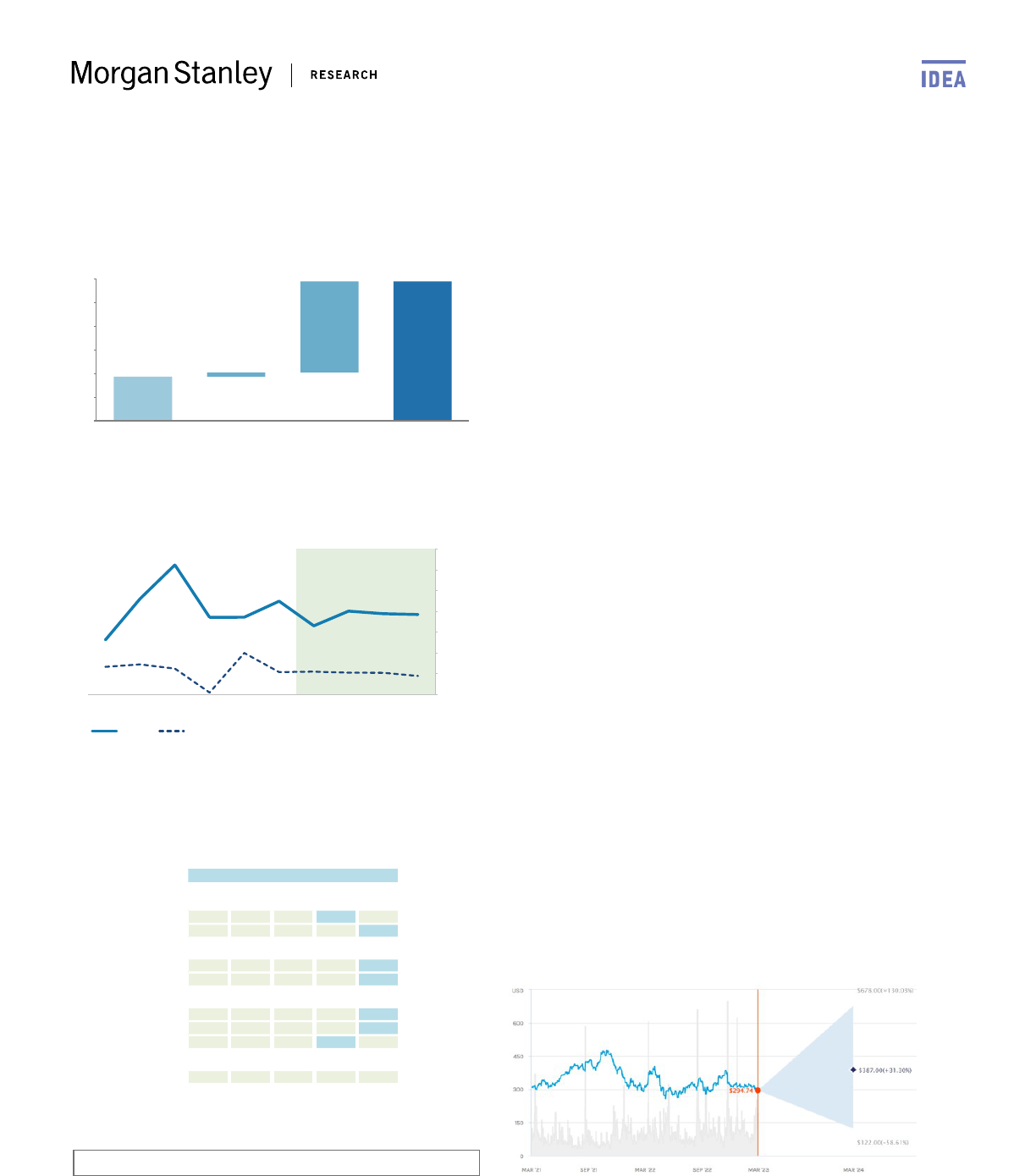
Lululemon Athletica (LULU)
Value of Growth Analysis
93
295
+9
+192
0
50
100
150
200
250
300
350
Current Earnings Growth in Explicit Forecast
Period
Long-Term Growth Current Price
93
295
+9
+192
0
50
100
150
200
250
300
Current Earnings Growth in Explicit Forecast
Period
Long-Term Growth Current Price
Return on Net Operating Assets (RNOA) Analysis
0%
20%
40%
60%
80%
100%
120%
140%
2017 2018 2019 2020 2021 2022 2023 2024 2025 2026
company sector peer median
0%
20%
40%
60%
80%
100%
120%
140%
2017 2018 2019 2020 2021 2022 2023 2024 2025 2026
company sector peer median
Sector Yardsticks
Sector Yardsticks
Lululemon Athletica Inc. vs. Sector Peers
Lululemon Athletica Inc. Peer
percentile range (vs. sector peers) median
Growth
0 20 40 60 80 100
EPS '23-'25 CAGR
16.1%
10.6%
Sales '23-'25 CAGR
13.1%
4.1%
Returns
RNOA
65.9%
21.9%
EBIT margin
23.1%
7.4%
Valuation
P/E
25.0x
12.3x
EV/EBIT
16.2x
9.0x
P/FCF
22.7x
16.2x
Leverage
Net Debt/EBITDA 1.2x
Note: Sector Yardstick metrics - Returns: 2023e; Valuation: 2023e; Leverage 2023e. (Net Debt/EBITDA
and P/FCF could be NM) Source: Morgan Stanley Research
Specialty Retail Industry View: In-Line
Alex Straton
LULU stands out for its balanced LT growth oppty, best-in-
class margin profile, higher-income customer exposure, &
thoughtful int’l strategy. 4 key attributes set LULU apart
from Softlines peers. (1) Consistent, outsized top-line &
market share growth potential fueled by global
geographical expansion, broader & deeper category
penetration, and best-in-class product innovation. (2)
Materially higher OM than peers (e.g., low-20s%+ vs. peer
avg. MSD-HSD%) due to higher prices, largely core
assortment mix, and low relative discounting activity. (3)
Greater higher-income customer skew, providing some
insulation from the turbulent macro. (4) Thoughtful
approach to int’l expansion (including localized assortments,
robust testing, & methodical store growth, among others).
Top-line growth should outpace already-strong athleisure
growth, & profitability should consistently improve over
time. The activewear market is expected to grow at a +MSD-
HSD CAGR thru ‘26e, above apparel at +LSD. Importantly,
not only is LULU likely to benefit from this industry growth,
we believe its unique & innovative product assortment &
category expansion is likely to generate ongoing market
share gains, enabling an above market-growth rate MT.
Further, we expect consistent EBIT dollar growth as LULU
scales across geographies & categories. Taken together,
LULU’s ability to take share in an attractive category,
coupled with EBIT dollar growth, likely enables consistent
EPS growth & pushes shares higher LT.
Risk Reward: Overweight / Price Target $387
20
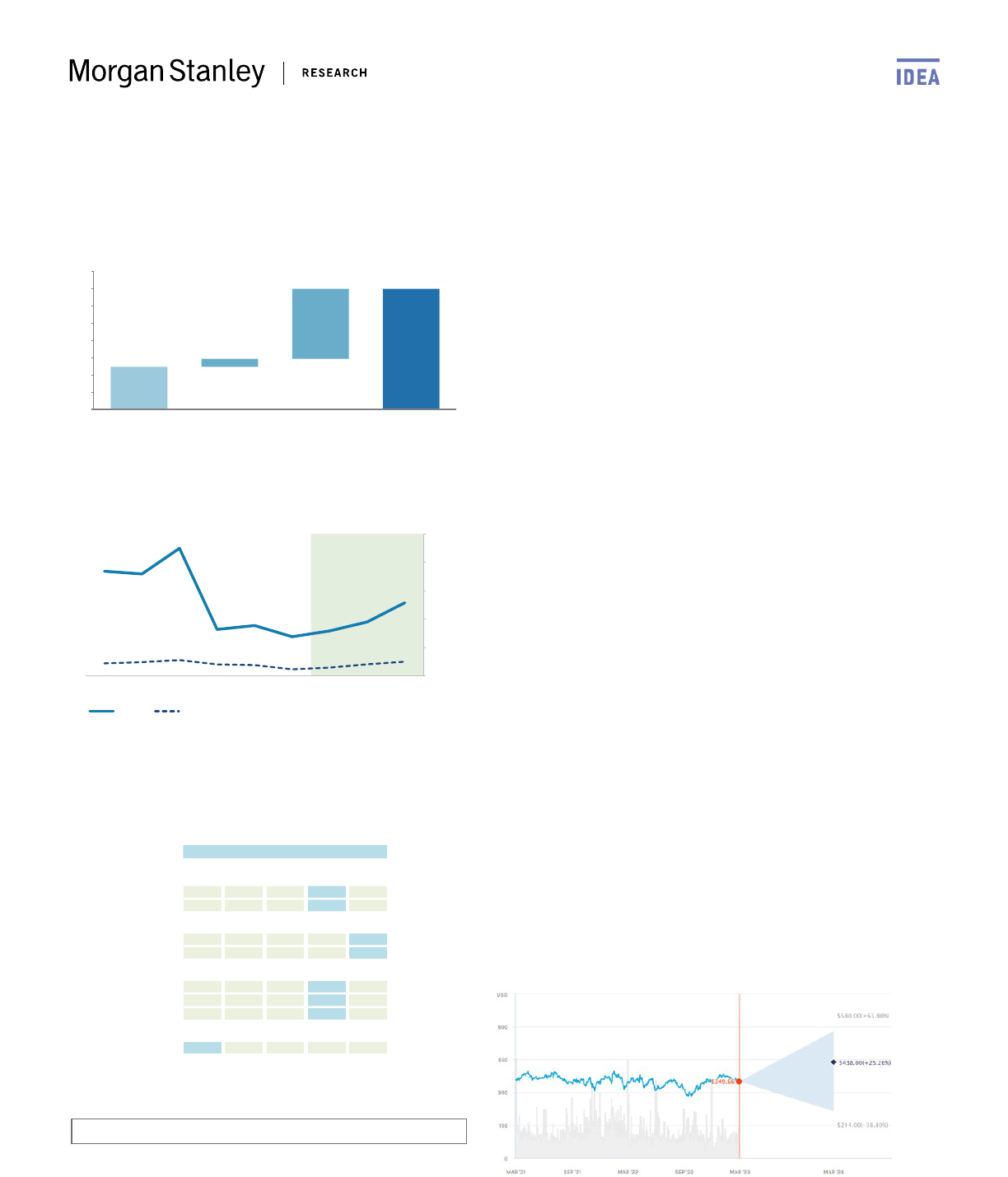
MasterCard (MA)
Value of Growth Analysis
123
350
+23
+203
0
50
100
150
200
250
300
350
400
Current Earnings Growth in Explicit Forecast
Period
Long-Term Growth Current Price
Return on Net Operating Assets (RNOA) Analysis
0%
50%
100%
150%
200%
250%
2017 2018 2019 2020 2021 2022 2023 2024 2025
company sector peer median
Sector Yardsticks
Sector Yardsticks
MasterCard Inc vs. Sector Peers
Peer
percentile range (vs. sector peers) median
Growth
0 20 40 60 80 100
EPS '23-'25 CAGR
16.6%
14.6%
Sales '23-'25 CAGR
13.3%
11.0%
Returns
RNOA
78.9%
14.1%
EBIT margin
58.1%
19.0%
Valuation
P/E
28.5x
17.0x
EV/EBIT
22.8x
15.9x
P/FCF
26.7x
16.9x
Leverage
Net Debt/EBITDA
0.1x
1.3x
MasterCard Inc
Note: Sector Yardstick metrics - Returns: 2023e; Valuation: 2023e; Leverage 2023e. (Net Debt/EBITDA
and P/FCF could be NM) Source: Morgan Stanley Research
Payments and Processing Industry View: Attractive
James Faucette
One of the best business models we've seen: As the second-
largest global card network (behind Visa), MA looks well
positioned to benefit from market share gains in particular
regions and consumer spending trends, which have been
resilient even through economic cycles. Similar to V, MA
should benefit from the return of cross-border travel, which
is still below the pre-Covid trend-line and comes with
higher-than-average yields.
New fintech players are enabling, not disrupting, Networks:
Given MA's largely fixed cost base, it sees declining cost per
transaction and steady uplift in operating margins as
volume grows. This, along with its enhanced fraud
capabilities and stickiness of consumer behavior, makes the
threat of disruption from new entrants fairly low, in our
view. Many of the new payment players tend to partner
with MasterCard and operate on its rails, given
MasterCard’s competitive cost structure and moat. These
partnerships with newcomers should continue to expand
Mastercard's TAM in the P2P and B2B payment markets.
B2B supports longer term opportunity: MasterCard is likely
to be a key player in the evolution of B2B payments over
the next 3-10 years. Its solutions position it well to capture
the ~$40T of B2B flows (e.g. corporate cards, virtual cards,
cross-border, accounts payable) as 45% of B2B payments
are still made via checks. Many of these opportunities also
can use card products and solutions that exist today, and do
not require significant incremental investment.
Risk Reward: Overweight / Price Target $438
21

Microsoft (MSFT)
Value of Growth Analysis
99
279
+15
+165
0
50
100
150
200
250
300
Current Earnings Growth in Explicit Forecast
Period
Long-Term Growth Current Price
Return on Net Operating Assets (RNOA) Analysis
0%
20%
40%
60%
80%
100%
120%
140%
160%
2017 2018 2019 2020 2021 2022 2023 2024 2025
company sector peer median
Sector Yardsticks
Microsoft vs. Sector Peers
Peer
percentile range (vs. sector peers) median
Growth
0 20 40 60 80 100
EPS '23-'25 CAGR
18.4%
23.8%
Sales '23-'25 CAGR
14.6%
14.6%
Returns
RNOA
64.7%
59.0%
EBIT margin
41.5%
27.0%
Valuation
P/E
29.6x
30.1x
EV/EBIT
23.1x
23.1x
P/FCF
31.4x
29.7x
Leverage
Net Debt/EBITDA 1.5x
Microsoft
Note: Sector Yardstick metrics - Returns: 2023e; Valuation: 2023e; Leverage 2023e. (Net Debt/EBITDA
and P/FCF could be NM) Source: Morgan Stanley Research
Software Industry View: Attractive
Keith Weiss
Exceptional secular growth exposure… Durability of
Growth, Margin Expansion, and Capital Return. With over
70% of revenue derived from Commercial businesses and
over 95% of Commercial revenue being recurring in nature
(mostly ratable subscription revenue or term-based licenses
associated with multi-year Enterprise License Agreements),
growth is driven by strong commercial demand pools,
powered by strong secular tailwinds and accompanied by
attractive unit economics. According to our CIO Survey, CIOs
expect Microsoft to be the leading budget share gainer as
workloads shift to the cloud over the next 3 years. Strong
survey results are a reflection of Microsoft’s strong
positioning as a beneficiary of key secular trends and CIO
priorities across AI/ML, Cloud, Security, Analytics and Digital
Transformation. The accelerating pace of innovation around
adding AI-powered capabilities into the portfolio with
announcements including Microsoft 365 Copilot, Github
Copilot, New Bing, and more, support momentum across the
business and buttress durable growth.
…at an exceptional price. With a medium-term view,
double-digit top-line growth (supported by secular
tailwinds, easing compares, price increases, & waning FX
headwinds) outpaces COGS growth to deliver mid-teens
gross profit dollar growth. Prudent opex spend and focus
on efficiency at scale drives mid-to-high teens operating
income growth. Share repurchases and a dividend yield push
the total return profile to high-teens. With Microsoft on a
path to deliver 5 quarters of accelerating EPS growth from
the Q2 trough, we see an opportunity to accumulate MSFT
shares, which are significantly undervalued at current levels,
in our view.
Risk Reward: Overweight / Price Target $307
22
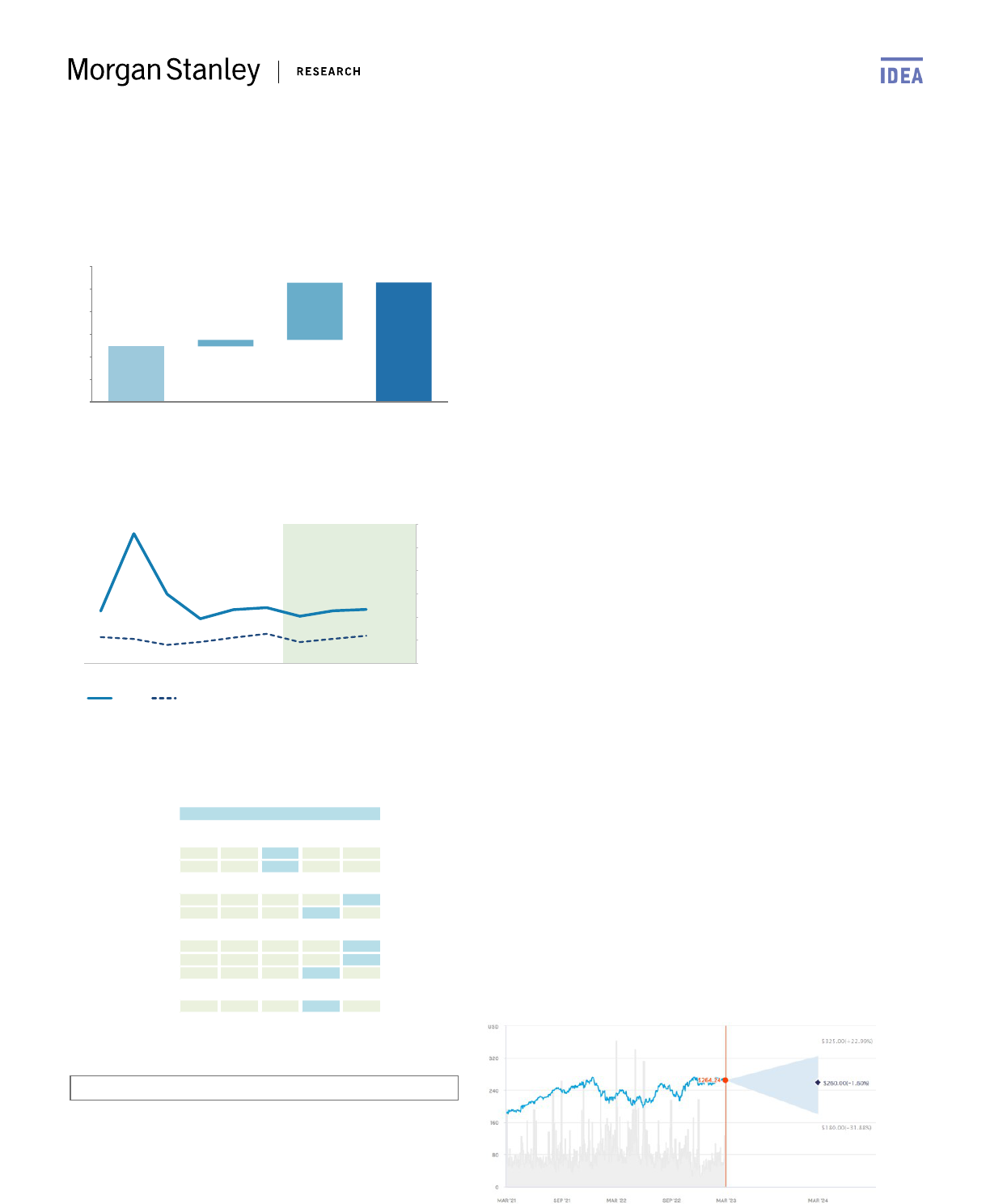
Motorola Solutions (MSI)
Value of Growth Analysis
123
264
+14
+127
0
50
100
150
200
250
300
Current Earnings Growth in Explicit Forecast
Period
Long-Term Growth Current Price
Return on Net Operating Assets (RNOA) Analysis
0%
20%
40%
60%
80%
100%
120%
2017 2018 2019 2020 2021 2022 2023 2024 2025 2026
company sector peer median
Sector Yardsticks
Sector Yardsticks
Motorola Solutions Inc vs. Sector Peers
Peer
percentile range (vs. sector peers) median
Growth
0 20 40 60 80 100
EPS '23-'25 CAGR
11.4%
11.6%
Sales '23-'25 CAGR
5.5%
5.3%
Returns
RNOA
40.5%
18.2%
EBIT margin
27.1%
17.8%
Valuation
P/E
23.7x
16.2x
EV/EBIT
19.3x
12.6x
P/FCF
27.7x
21.8x
Leverage
Net Debt/EBITDA
1.4x
1.3x
Motorola Solutions Inc
Note: Sector Yardstick metrics - Returns: 2023e; Valuation: 2023e; Leverage 2023e. (Net Debt/EBITDA
and P/FCF could be NM) Source: Morgan Stanley Research
Telecom & Networking Equip. Industry View: Cautious
Meta Marshall
Dominant radio market position. MSI has a dominant
market share in radios, a defensive exposure given the
segment's ties to government spending. Land mobile radio
(LMR) accounts for the vast majority of revenue (~77% in
2022) and MSI maintains ~40%+ share of this ~$11bn+
mission-critical TAM. With the LMR / push-to-talk market
expected to grow for several years and high barriers to
entry given LMR's mission-critical nature, we believe MSI has
an attractive competitive position in its core market. We also
favor MSI's ability to optimize around this market position
(i.e., consistently expanding operating margins Y/Y) and
generate cash to fund share repurchases / dividends.
TAM expansion opportunities bolster competitive
positioning. We see a path toward long-term re-rating via
MSI leveraging cash flow generation and its footprint in
LMR/command center into winning in next-generation public
safety tech, including video security. We estimate end
markets within Video are higher-growth than LMR and
should accelerate MSI's growth as the segment becomes
larger in the overall revenue mix (with tailwinds from
displacement of offerings from China). Advancements
within LMR (APX Next portfolio) should create holistic
secular tailwinds for growth. Overall, more investment in
security by schools, public places, and workplaces broaden
investment in MSI products.
Compelling longer-term software story offers additional
upside. MSI has invested in a more robust command center
software platform to build on its leading share in 911.
Increasing use of analytics software for video surveillance
use cases should support the software portfolio.
Risk Reward: Equal-Weight / Price Target $260
23
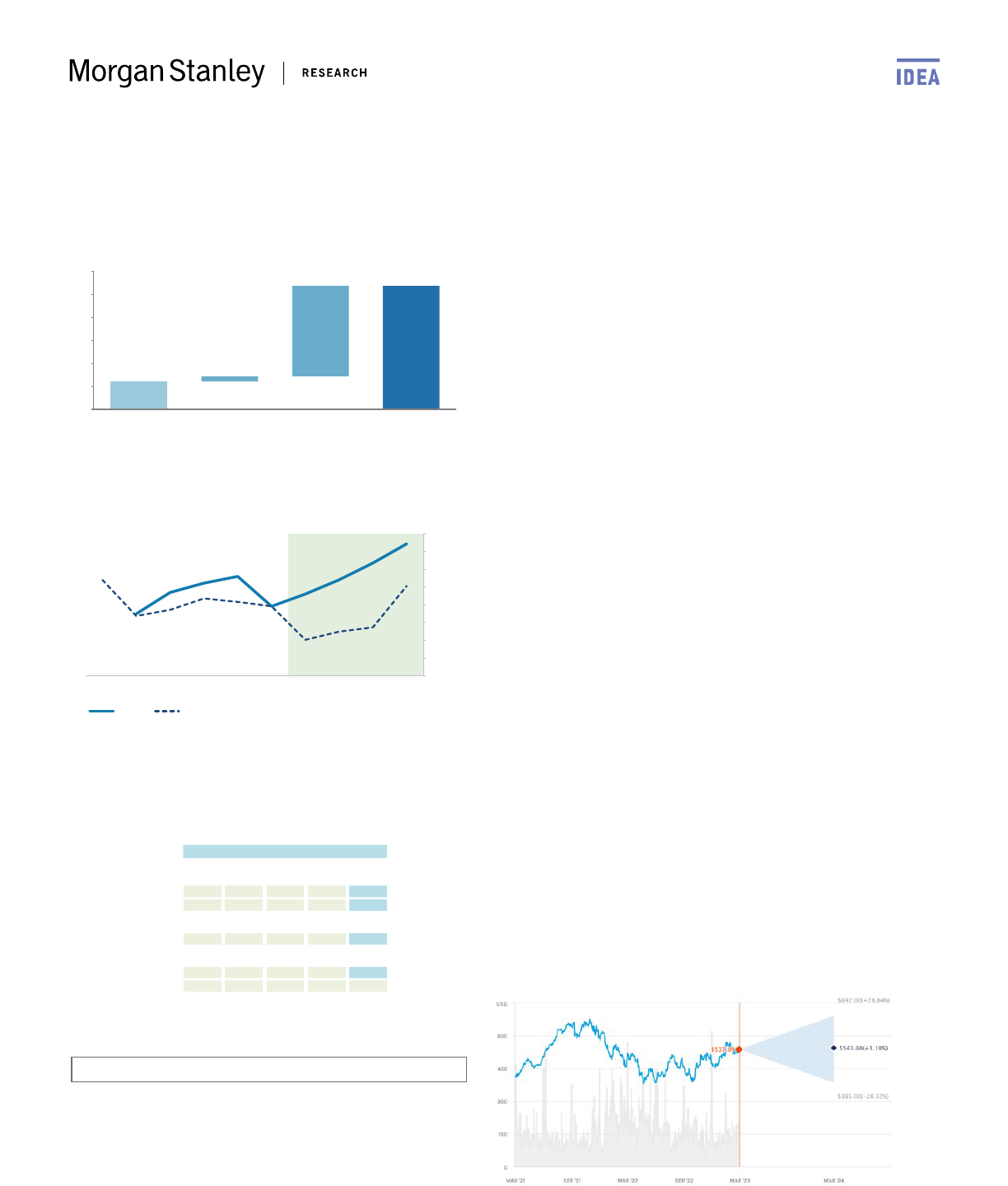
MSCI Inc. (MSCI)
Value of Growth Analysis
121
537
+22
+393
0
100
200
300
400
500
600
Current Earnings Growth in Explicit Forecast
Period
Long-Term Growth Current Price
Return on Net Operating Assets (RNOA) Analysis
0%
10%
20%
30%
40%
50%
60%
70%
80%
2017 2018 2019 2020 2021 2022 2023 2024 2025 2026
company sector peer median
Sector Yardsticks
Sector Yardsticks
MSCI Inc. vs. Sector Peers
Peer
percentile range (vs. sector peers) median
Growth
0 20 40 60 80 100
EPS '23-'25 CAGR
17.6%
13.7%
Sales '23-'25 CAGR
12.1%
7.0%
Returns
RNOA
46.0%
20.2%
Valuation
P/E
40.3x
31.7x
P/B 9.5x
MSCI Inc.
Note: Sector Yardstick metrics - Returns: 2023e; Valuation: 2023e. (P/B could be NM) Source: Morgan
Stanley Research
Business & Education Services Industry View: In-Line
Toni Kaplan
Strong competitive advantages. MSCI is a leading provider
of benchmark indices, portfolio analytics, and ESG research
for investment institutions. MSCI has an attractive business
model with a scalable infrastructure, recurring revenue, and
a strong brand name. MSCI’s business model is extremely
scalable – once an index product is developed, little further
capital investment is required. As a result, MSCI has the
highest EBITDA margins within our subscription-based
Information Services coverage (60% vs. 43% avg), and we
expect margins to expand going forward driven by
operational leverage and strong expense management.
MSCI operates in the highly attractive index industry with
"must-have" data sets, pricing power, and operational
leverage. The index industry benefits from a network effect
and high switching costs. Once a fund manager selects an
MSCI index to use as a benchmark, it is disruptive to change
it, which promotes stickiness. Strong brand recognition,
large ecosystems surrounding flagship indices, and frictions
make it difficult or costly for asset managers to switch
benchmarks. Strong tailwinds in the index industry and
execution have led to the highest expected organic growth
rate in '24 within our coverage (12% vs. 7.5%)
MSCI is the leading provider of ESG/climate content and
indices with significant market share. MSCI benefits from
having a first mover advantage and continues to invest
heavily in the space to maintain its leading position. MSCI
has 55% share of US ESG ETFs vs. 13% for the next largest
competitor due to its significant head start.
Risk Reward: Overweight / Price Target $543
24
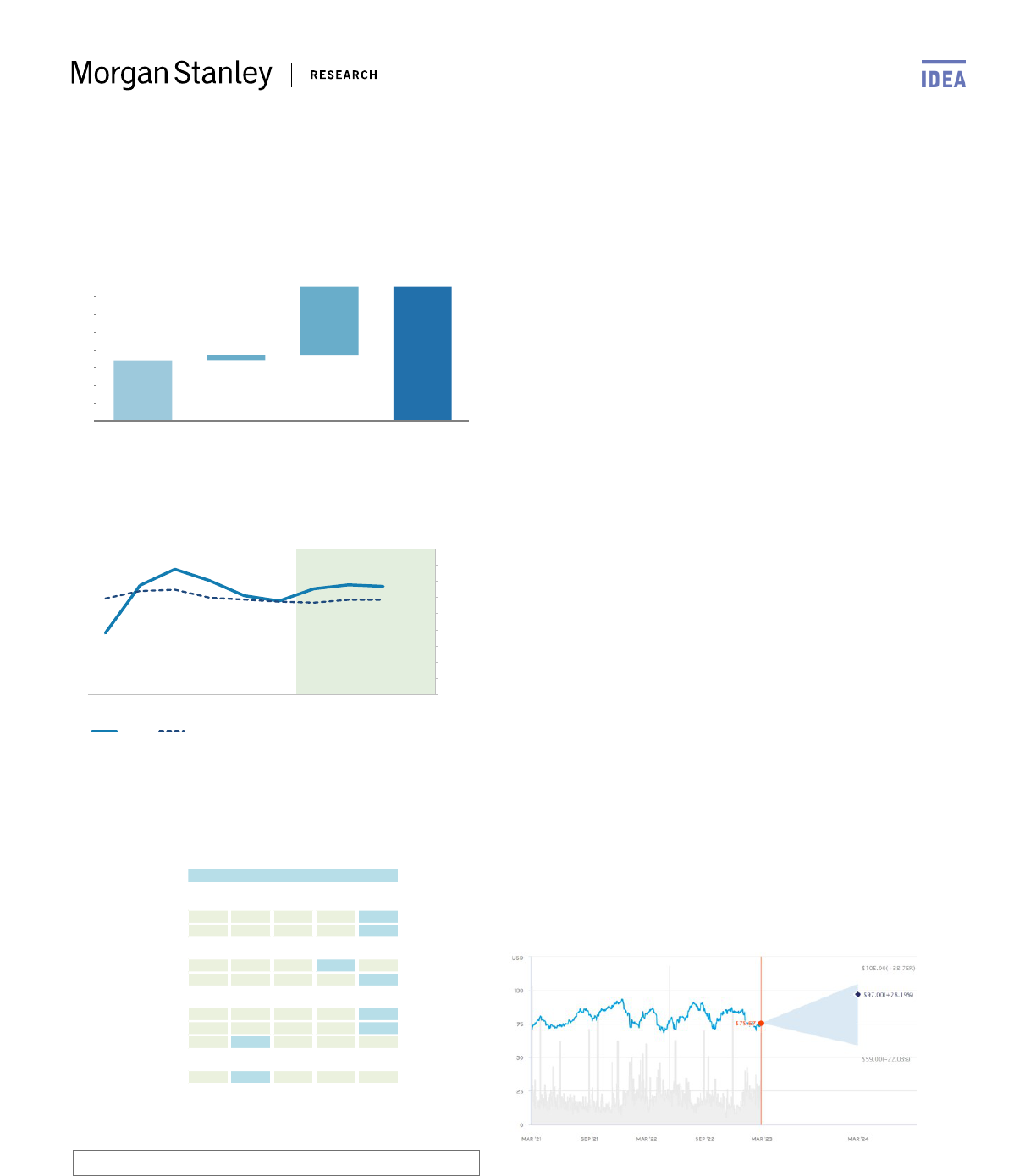
NextEra Energy (NEE)
Value of Growth Analysis
34
76
+3
+38
0
10
20
30
40
50
60
70
80
Current Earnings Growth in Explicit Forecast
Period
Long-Term Growth Current Price
Return on Net Operating Assets (RNOA) Analysis
0%
1%
2%
3%
4%
5%
6%
7%
8%
9%
2017 2018 2019 2020 2021 2022 2023 2024 2025 2026
company sector peer median
Sector Yardsticks
Sector Yardsticks
NextEra Energy Inc vs. Sector Peers
Peer
percentile range (vs. sector peers) median
Growth
0 20 40 60 80 100
EPS '23-'25 CAGR
9.2%
7.3%
Sales '23-'25 CAGR
6.7%
3.3%
Returns
RNOA
6.5%
5.7%
EBIT margin
32.2%
20.9%
Valuation
P/E
24.4x
17.4x
EV/EBIT
26.3x
19.6x
P/FCF
(38.1x)
(23.5x)
Leverage
Net Debt/EBITDA
5.1x
5.5x
NextEra Energy Inc
Note: Sector Yardstick metrics - Returns: 2023e; Valuation: 2023e; Leverage 2023e. (Net Debt/EBITDA
and P/FCF could be NM) Source: Morgan Stanley Research
Diversified Utilities / IPPs Industry View: Attractive
David Arcaro
Highly differentiated, sustainable competitive position in
the renewables market. This US developer of wind, solar,
and storage assets benefits from economies of scale that
offer the company buying power in the supply chain,
improved transmission interconnect positions, operating
cost efficiency, and robust access to debt and tax equity
capital. NEE has a very long track record in the industry,
building long-term customer relationships with repeat
buyers and a reputation for strong execution. The
company's large existing asset base offers improved market
and geographic knowledge of wind/solar resources. And the
next key area for differentiation is in software and analytics,
with internal software capabilities to integrate complex
storage assets, offer sophisticated predictive maintenance,
optimize site design and power output, and map out
customer generation portfolios and decarbonization targets
to better tailor products.
New growth opportunities with attractive returns and wide
moats stemming from the Inflation Reduction Act. Storage,
green hydrogen, and renewables repowering sre set to
benefit from new lucrative tax credits that unlock large
growth opportunities for new infrastructure. We see
prospects for NextEra to be among the leaders in building
out these new markets and capturing attractive low-risk
returns.
Risk Reward: Overweight / Price Target $97
25

Nike (NKE)
Value of Growth Analysis
31
120
+9
+80
0
20
40
60
80
100
120
140
Current Earnings Growth in Explicit Forecast
Period
Long-Term Growth Current Price
Return on Net Operating Assets (RNOA) Analysis
0%
10%
20%
30%
40%
50%
60%
2017 2018 2019 2020 2021 2022 2023 2024 2025 2026
company sector peer median
Sector Yardsticks
Sector Yardsticks
Nike Inc. vs. Sector Peers
Peer
percentile range (vs. sector peers) median
Growth
0 20 40 60 80 100
EPS '23-'25 CAGR
28.1%
10.6%
Sales '23-'25 CAGR
11.1%
4.1%
Returns
RNOA
38.4%
21.9%
EBIT margin
13.1%
7.4%
Valuation
P/E
29.7x
12.3x
EV/EBIT
24.5x
9.0x
P/FCF
44.2x
16.2x
Leverage
Net Debt/EBITDA
0.0x
1.2x
Nike Inc.
Note: Sector Yardstick metrics - Returns: 2023e; Valuation: 2023e; Leverage 2023e. (Net Debt/EBITDA
and P/FCF could be NM) Source: Morgan Stanley Research
Branded Apparel & Footwear Industry View: In-Line
Alex Straton
NKE's DTC acceleration makes it one of the best-positioned
Softlines companies in the post-Covid era, in our view.
While we believe NKE remains in the early stages of its
transition from a traditional wholesaler to a digitally-led
direct to consumer (DTC) business, it has made impressive
progress so far, increasing DTC penetration by ~10 pts since
2019 (from 30% to ~40%). This DTC-first approach
enhances NKE’s LT market share, revenue, margin, & EPS
growth opportunity, making it one of the highest-growth
consumer names as well as one of the few to benefit from
the move to digital (~23% of ‘22 revenue vs. NKE’s ~40% LT
target).
The shift to DTC should materially improve NKE's financial
profile. Given its strong commitment to a DTC-first
approach, we expect NKE to continue to allocate its best
SKUs and focus its marketing efforts on DTC, leading the
most profitable customers to the channel. Therefore, not
only do we expect the DTC strategy to drive revenue
growth as NKE recognizes the full wholesale to retail
markup for itself, but it should also improve profitability.
We estimate a ~10 point uplift to GM, which mgmt. expects
to flow through to the operating profit line as the business
scales.
Strong activewear growth & favorable secular trends
should further support NKE's LT growth. Additionally,
trends such as (1) the activewear market outgrowing general
footwear & apparel, (2) increased consumer focus on health
& wellness, & (3) the ongoing casualization of fashion,
should further bolster NKE's LT growth opportunity.
Risk Reward: Overweight / Price Target $140
26
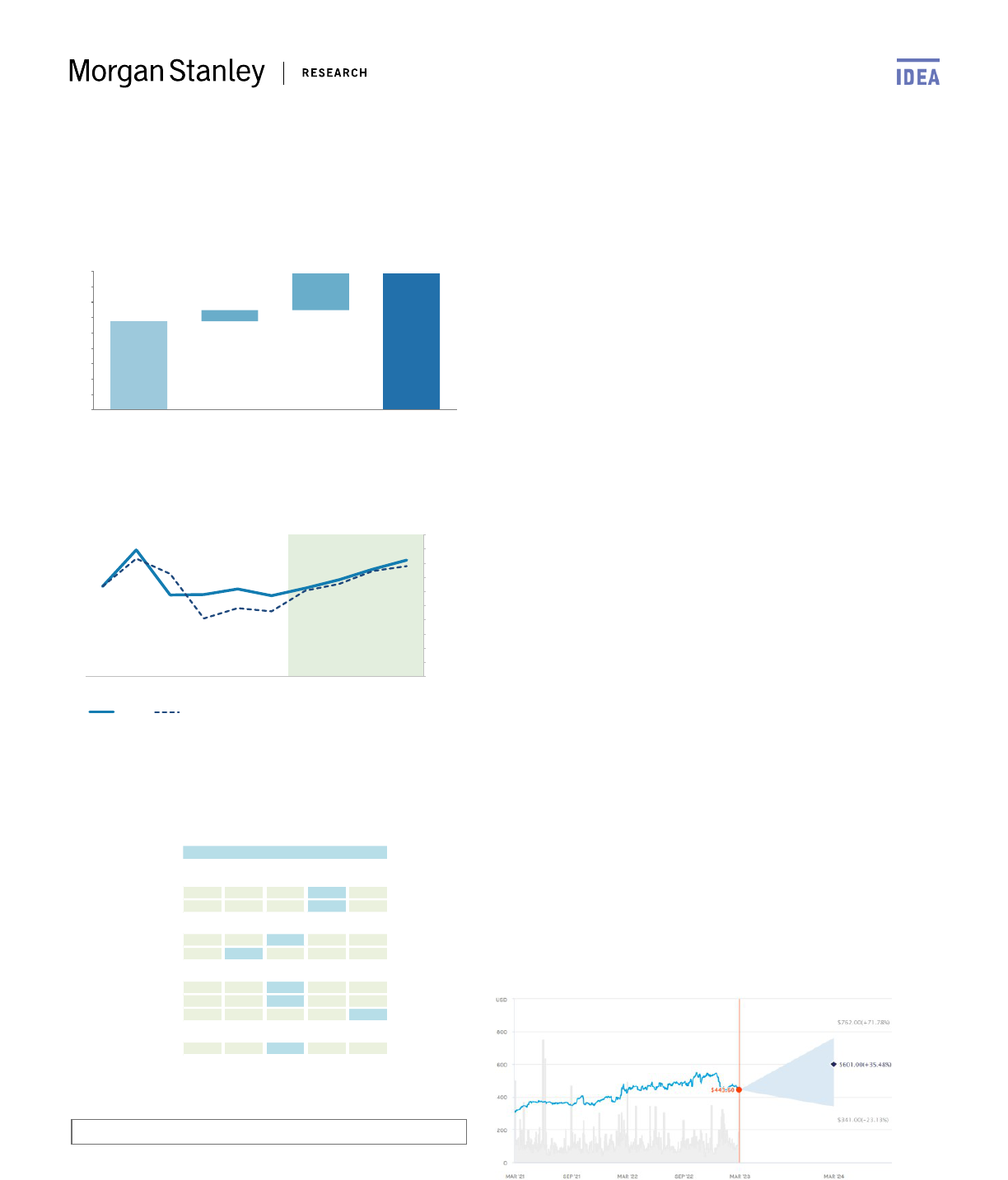
Northrop Grumman (NOC)
Value of Growth Analysis
288
444
+36
+119
0
50
100
150
200
250
300
350
400
450
Current Earnings Growth in Explicit Forecast
Period
Long-Term Growth Current Price
Return on Net Operating Assets (RNOA) Analysis
0%
2%
4%
6%
8%
10%
12%
14%
16%
18%
20%
2017 2018 2019 2020 2021 2022 2023 2024 2025 2026
company sector peer median
Sector Yardsticks
Sector Yardsticks
Northrop Grumman Corp. vs. Sector Peers
Peer
percentile range (vs. sector peers) median
Growth
0 20 40 60 80 100
EPS '23-'25 CAGR
17.3%
13.6%
Sales '23-'25 CAGR
8.7%
7.0%
Returns
RNOA
12.4%
12.1%
EBIT margin
10.6%
12.8%
Valuation
P/E
20.0x
20.0x
EV/EBIT
18.9x
18.2x
P/FCF
34.2x
24.7x
Leverage
Net Debt/EBITDA
1.9x
1.8x
Northrop Grumman Corp.
Note: Sector Yardstick metrics - Returns: 2023e; Valuation: 2023e; Leverage 2023e. (Net Debt/EBITDA
and P/FCF could be NM) Source: Morgan Stanley Research
Defense Industry View: Attractive
Kristine Liwag
A winning portfolio. Northrop Grumman (NOC) went from
Dark Horse of the Prime pack to the long-term Defense
name to own after winning two generational programs –
the B-21 bomber and Sentinel intercontinental ballistic
missile. These two franchises offer decades of earnings
visibility for NOC and will serve as the backbone of the US
nuclear deterrent. The 2018 acquisition of Orbital ATK also
helped NOC round out an end-to-end Space portfolio
(~35% of total revenue) that is unrivaled, in our view, by
peers. With its B-21 and Sentinel wins and continued
Pentagon investment in the Space domain (~20% YoY
growth in FY24 budget request / ~22% trailing 5-year CAGR),
we see NOC’s portfolio particularly well-aligned to current
and emerging Defense Department priorities (for more, see
Generational Investments in Defense). We see Defense in
the early inning of an upcycle fueled by a deteriorating
global security environment and pressing Pentagon
modernization requirements – both of which should provide
strong tailwinds for NOC’s business.
Peer-high growth. NOC’s strong portfolio alignment, in our
view, should drive peer-high growth through 2025 (~7.5%
CAGR 2022-25e). We also expect a ~29% FCF CAGR though
2025 as Section 174 headwinds ease and capex moderates
after an elevated investment period driven by significant
new program wins. NOC plans to return >100% of FCF to
shareholders in 2023 and we expect the management team
– which we view as best-in-class – to continue to run its
shareholder-friendly capital deployment playbook at least
through mid-decade.
Risk Reward: Overweight / Price Target $601
27
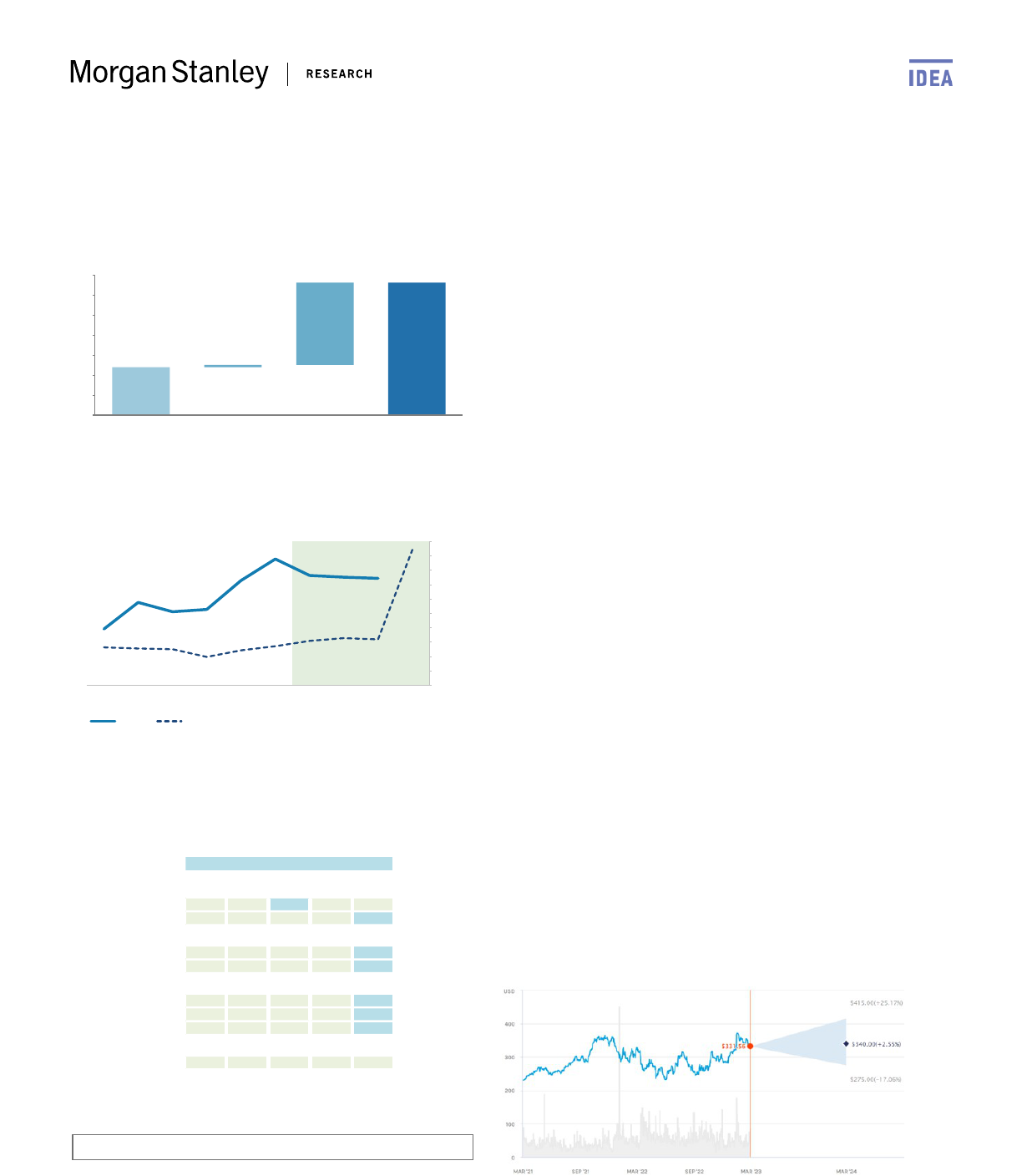
Old Dominion Freight Line (ODFL)
Value of Growth Analysis
120
332
+6
+206
0
50
100
150
200
250
300
350
Current Earnings Growth in Explicit Forecast
Period
Long-Term Growth Current Price
Return on Net Operating Assets (RNOA) Analysis
0%
5%
10%
15%
20%
25%
30%
35%
40%
45%
50%
2017 2018 2019 2020 2021 2022 2023 2024 2025 2026
company sector peer median
Sector Yardsticks
Sector Yardsticks
Old Dominion Freight Line Inc vs. Sector Peers
Peer
percentile range (vs. sector peers) median
Growth
0 20 40 60 80 100
EPS '23-'25 CAGR
9.4%
10.5%
Sales '23-'25 CAGR
6.5%
4.5%
Returns
RNOA
38.1%
15.4%
EBIT margin
29.0%
10.0%
Valuation
P/E
27.2x
14.8x
EV/EBIT
19.8x
12.2x
P/FCF
40.3x
14.6x
Leverage
Net Debt/EBITDA 1.7x
Old Dominion Freight Line Inc
Note: Sector Yardstick metrics - Returns: 2023e; Valuation: 2023e; Leverage 2023e. (Net Debt/EBITDA
and P/FCF could be NM) Source: Morgan Stanley Research
Freight Transportation Industry View: In-Line
Ravi Shanker
We view ODFL as a best-in-class franchise across Freight
Transportation, if not a wider sample set. Very few
companies can match ODFL’s 15+ year track record of
growing revenues at a 10%+ CAGR (4x+ GDP), while
improving margins 1500 bp (with op. margins now topping
30%) to drive EPS growth CAGR of 20%+. The stock has
been one of the best performing in the S&P 500 in that
period (up over 3,600% since 2008), as the company
solidifies its position amongst investors as a “core holding”.
The best house on a rapidly improving block. While the
cyclicality and industry dynamics of Trucking may initially
give some investors pause, we have been structurally
positive on Trucking for a while. A number of structural
catalysts including new regulations in the last 5 years (that
have introduced barriers to entry in the business for the
first time), share gains from other transportation modes
(supply chains getting shorter, faster, and tighter favors
Trucking), industry consolidation as well as long term
favorable structural shifts like nearshoring, electrification,
and autonomous trucking, are driving compounding earnings
growth in the space. As the best house on this block, ODFL
is very well positioned, in our view.
Deeply Entrenched Strengths. ODFL's key strengths include
being in the sweet spot of scale, owning more of their real
estate footprint than peers, investing in growth through the
cycle and exceptional management, that drives ODFL’s best-
in-class track record.
Risk Reward: Overweight / Price Target $340
28
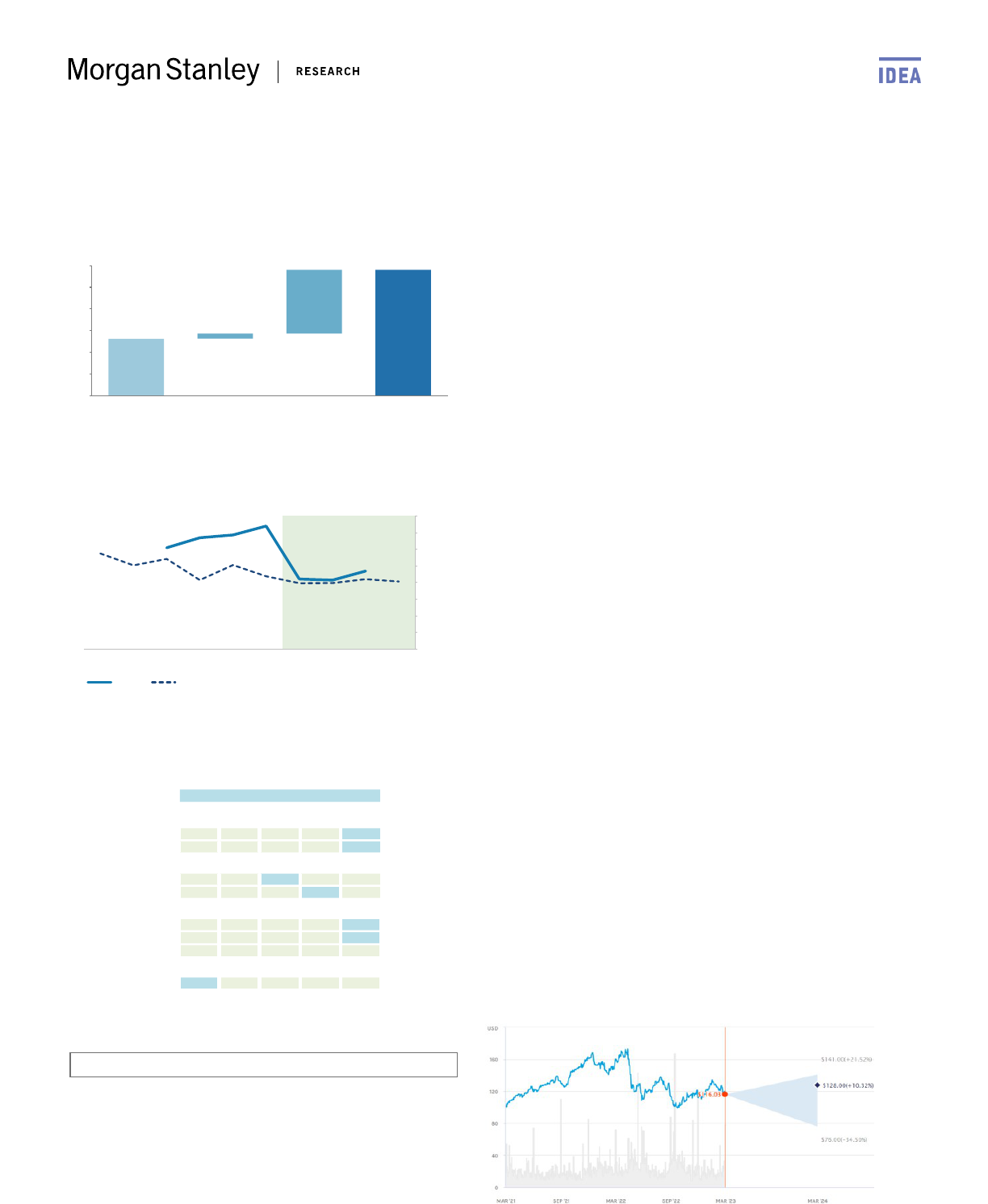
Prologis (PLD)
Value of Growth Analysis
52
116
+5
+59
0
20
40
60
80
100
120
Current Earnings Growth in Explicit Forecast
Period
Long-Term Growth Current Price
Return on Net Operating Assets (RNOA) Analysis
0%
1%
2%
3%
4%
5%
6%
7%
8%
2017 2018 2019 2020 2021 2022 2023 2024 2025 2026
company sector peer median
Sector Yardsticks
Sector Yardsticks
Prologis, Inc. vs. Sector Peers
Peer
percentile range (vs. sector peers)
median
Growth
0 20 40 60 80 100
FFO '23-'25 CAGR
5.6%
2.5%
Sales '23-'25 CAGR
7.6%
2.8%
Returns
RNOA
4.2%
3.9%
EBIT margin
40.1%
33.1%
Valuation
P/FFO
21.2x
11.6x
EV/EBITDA
22.0x
14.7x
P/FCF 12.4x
Leverage
Net Debt/EBITDA
3.8x
5.7x
Prologis, Inc.
Note: Sector Yardstick metrics - Returns: 2023e; Valuation: 2023e; Leverage 2023e. (Net Debt/EBITDA
and P/FCF could be NM) Source: Morgan Stanley Research
Real Estate Investment Trusts Industry View: In-Line
Ronald Kamdem
Low industrial availability rates combined with below-
market rents within the portfolio creates LT visibility in
PLD's internal growth algorithm. Leases within the portfolio
remain ~70% below market rents, driving our expectation
for average internal growth of 8-10% over the next several
years. In addition, PLD's favorable balance sheet (~5x debt
to EBITDA, ~20% leverage ratio) and strategic capital
business provide the company with a sustainable path for
external growth.
Due to high barriers to supply and elevated e-commerce
demand, PLD's markets are at record lows in terms of
available space. The company's markets have experienced
between 15-30% market rent growth since '18, creating a
favorable spread between embedded rents within PLD's
portfolio current market rents (lease terms are ~7 years,
and only 10-15% of leases are rolled to market per year).
This backdrop has led to runway of "built in" same store
growth over the next several years and we expect 8-10%
internal NOI growth through '26.
Favorable supply/demand dynamics should insulate PLD
from a slowing macro backdrop. While we expect the pace
of market rent growth to slow as inventory growth slows
and speculative supply (future deliveries that are not pre-
leased) comes online, our analysis suggests rent growth can
remain positive in the intermediate term, as both slowing
demand and record supply pipelines may not be enough to
push availability rates close to the 8-9% range where
market rent growth historically turned negative (see Exhibit
1 of Dissecting Risks to Fundamentals: Resume PLD at OW;
Top Pick).
Risk Reward: Overweight / Price Target $128
29
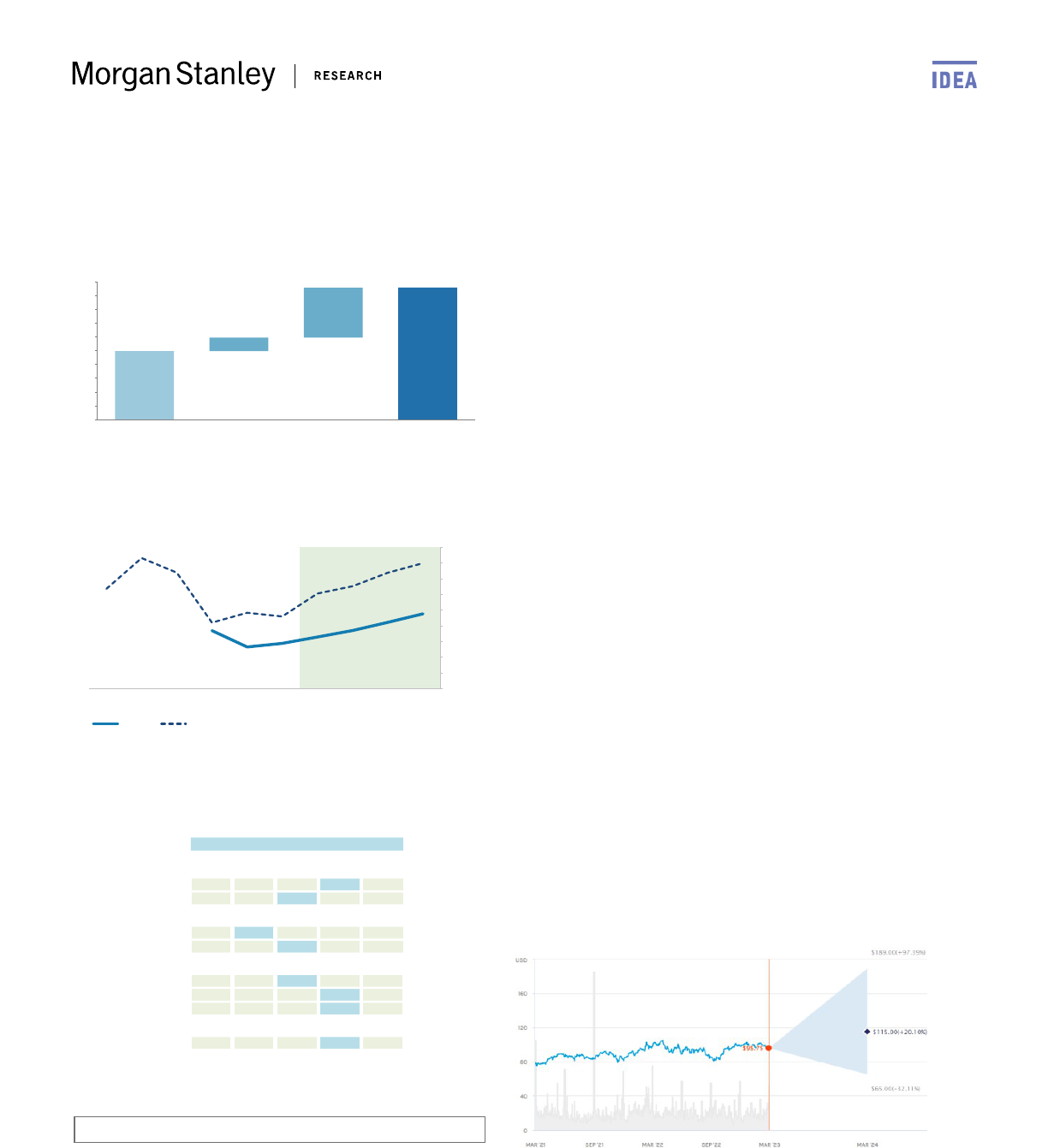
Raytheon Technologies (RTX)
Value of Growth Analysis
50
96
+10
+36
0
10
20
30
40
50
60
70
80
90
100
Current Earnings Growth in Explicit Forecast
Period
Long-Term Growth Current Price
Return on Net Operating Assets (RNOA) Analysis
0%
2%
4%
6%
8%
10%
12%
14%
16%
18%
2017 2018 2019 2020 2021 2022 2023 2024 2025 2026
company sector peer median
Sector Yardsticks
Sector Yardsticks
Raytheon Technologies Corp vs. Sector Peers
Peer
percentile range (vs. sector peers)
median
Growth
0 20 40 60 80 100
EPS '23-'25 CAGR
19.1%
13.1%
Sales '23-'25 CAGR
7.7%
7.4%
Returns
RNOA
6.5%
12.1%
EBIT margin
12.1%
12.5%
Valuation
P/E
19.1x
20.0x
EV/EBIT
19.1x
18.2x
P/FCF
29.1x
22.9x
Leverage
Net Debt/EBITDA
2.3x
1.8x
Raytheon Technologies Corp
Note: Sector Yardstick metrics - Returns: 2023e; Valuation: 2023e; Leverage 2023e. (Net Debt/EBITDA
and P/FCF could be NM) Source: Morgan Stanley Research
Defense Industry View: Attractive
Kristine Liwag
We continue to see RTX as a value play given exposure to
aerospace and defense end markets, along with strong FCF
generation. We see the commercial aero business
benefitting from China re-opening and OEM rate ramps.
China re-opening should help to drive the next leg up for
commercial aftermarket at Collins as Asia/Pacific air traffic
remained at ~57% of pre-Covid levels in December. OEM
rate ramps for the Boeing 737 MAX from ~31/month today
to ~50/month in 2025/2026 and A320neo family from ~45-
50/month today to ~65/month by the end of 2024 will help
drive further upside for commercial aerospace.
RTX’s defense business should benefit from a strong macro
backdrop for defense spending as a heightened geopolitical
climate persists (see more in Generational Investments in
Defense). We see higher defense spending providing a multi-
year growth outlook, though see this growth taking time to
materialize and acknowledge short-term supply chain
disruptions. RTX is positioned well for growing areas of the
Defense Budget as highlighted by the recent FY24 budget
request featuring Space funding request up 20% YoY and
Missiles/Missile funding request up 23% YoY. We also see
RTX benefitting from the Air Force’s decision to upgrade
existing F-35 engines instead of developing a new engine. We
estimate the company will generate $7.9bn in 2023, $7.2bn
in 2024, and $9.4bn in 2025.
Risk Reward: Overweight / Price Target $115
30

Thermo Fisher Scientific (TMO)
Value of Growth Analysis
278
547
+29
+240
0
100
200
300
400
500
600
Current Earnings Growth in Explicit Forecast
Period
Long-Term Growth Current Price
Return on Net Operating Assets (RNOA) Analysis
0%
5%
10%
15%
20%
25%
2017 2018 2019 2020 2021 2022 2023 2024 2025 2026
company sector peer median
Sector Yardsticks
Sector Yardsticks
Thermo Fisher Scientific Inc. vs. Sector Peers
Peer
percentile range (vs. sector peers)
median
Growth
0 20 40 60 80 100
EPS '23-'25 CAGR
13.1%
16.2%
Sales '23-'25 CAGR
8.0%
9.0%
Returns
RNOA
13.6%
11.7%
EBIT margin
23.9%
23.9%
Valuation
P/E
23.1x
21.8x
EV/EBIT
22.3x
21.4x
P/FCF
23.9x
22.5x
Leverage
Net Debt/EBITDA
1.9x
1.4x
Thermo Fisher Scientific Inc.
Note: Sector Yardstick metrics - Returns: 2023e; Valuation: 2023e; Leverage 2023e. (Net Debt/EBITDA
and P/FCF could be NM) Source: Morgan Stanley Research
Life Science Tools & Diagnostics Industry View: In-Line
Tejas Savant
Best-in-class resiliency. We like TMO for the breadth of its
portfolio, diversified customer base and scale - attributes
that we believe will prove advantageous in navigating a
potential recession, in addition to inflationary pressures and
geopolitical uncertainty. TMO’s favorable end market
exposure, PPI business system, and track record of
consistent all-weather execution underpin our confidence in
management’s long-term core organic growth target of 7-
9% with mid-teens EPS growth.
Well positioned to outpace peers and end markets. As a
global life sciences leader, TMO serves ~$165B in
addressable markets (across diagnostics & healthcare,
industrial/applied, academic/government, and pharma &
biotech) that have historically grown in the 4-6% range
annually. We firmly believe in TMO’s ability to outgrow its
peers and end markets driven by a combination of
increasing exposure to high-growth verticals (specifically
biopharma, following the Patheon/PPD acquisitions) and
geographies (including China), as well as a relentless focus
on share gains fueled by the breadth, depth and reach of
their portfolio.
Embedded M&A optionality. The thesis comes with
embedded capital deployment optionality, given
management’s successful track record of consolidation in
the fragmented tools sector and their commitment to M&A
(with plans to deploy $48B in capital from 2023-25, with
65% allocated to acquisitions).
Risk Reward: Overweight / Price Target $670
31

T-Mobile US (TMUS)
Value of Growth Analysis
83
142
+43
+17
0
20
40
60
80
100
120
140
Current Earnings Growth in Explicit Forecast
Period
Long-Term Growth Current Price
Return on Net Operating Assets (RNOA) Analysis
0%
2%
4%
6%
8%
10%
12%
14%
16%
2017 2018 2019 2020 2021 2022 2023 2024 2025 2026
company sector peer median
Sector Yardsticks
Sector Yardsticks
T-Mobile US, Inc. vs. Sector Peers
Peer
percentile range (vs. sector peers)
median
Growth
0 20 40 60 80 100
EPS '23-'25 CAGR
30.6%
4.2%
Sales '23-'25 CAGR
4.1%
1.1%
Returns
RNOA
8.7%
5.9%
EBIT margin
20.4%
17.1%
Valuation
P/E
20.2x
21.2x
EV/EBIT
14.4x
17.5x
P/FCF
13.0x
13.0x
Leverage
Net Debt/EBITDA
2.5x
3.5x
T-Mobile US, Inc.
Note: Sector Yardstick metrics - Returns: 2023e; Valuation: 2023e; Leverage 2023e. (Net Debt/EBITDA
and P/FCF could be NM) Source: Morgan Stanley Research
Telecom Services Industry View: In-Line
Simon Flannery
5G leadership and differentiated growth drivers supporting
share gains and category expansion. T-Mobile's Sprint
merger drove early success in 5G with the company able to
sustain a 1-2 year lead vs peers, while also benefiting from
~25% more low/mid-band spectrum. The company has a
clear growth strategy predicated primarily on share gains in
key, underpenetrated markets: small town/rural, enterprise
and top 100 market network seekers. Additionally, T-Mobile
has led the way on fixed wireless home broadband as a
brand new market opportunity for the company that's
expected to scale to 7-8mn subs by 2025.
Ongoing margin upside on remaining synergy realization
and scale gains. The integration of the Sprint merger will be
complete in 2023 with management recently raising synergy
guidance to $8bn from $7.5bn previously and $6bn realized
in 2022. Ongoing synergy realization and growing scale
should allow the company to expand EBITDA service
margins to the mid-50% range over the long-term vs. 43% in
2022.
Just starting to execute on up to $60bn in buybacks
through 2025. The company has laid out plans to
repurchase up to $60bn in stock through 2025. With
leverage already close to the mid-2x target range, an initial
$14bn program was authorized in late-2022, and we're
expecting a new, larger program to be announced later this
year.
Risk Reward: Overweight / Price Target $175
32
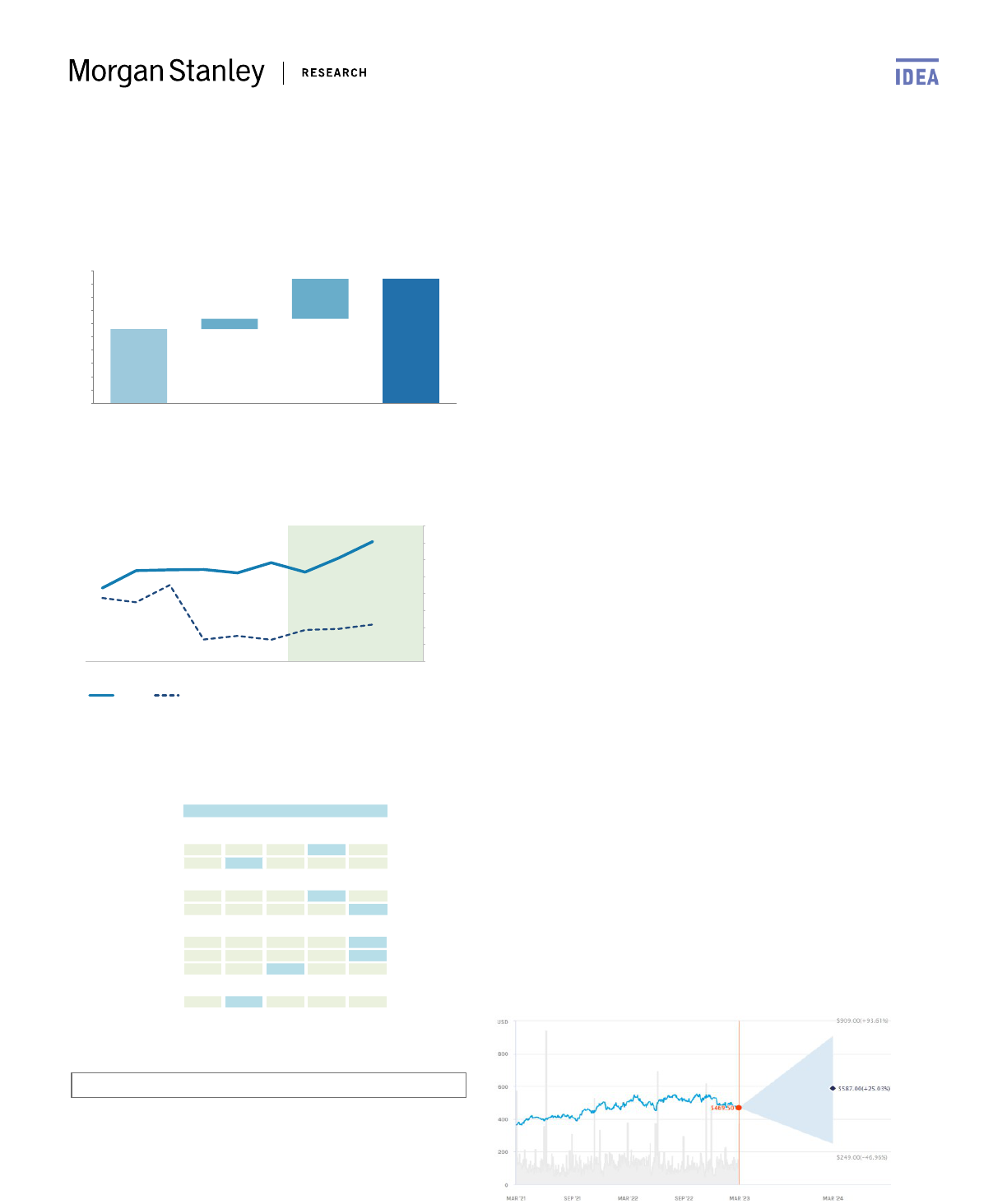
UnitedHealth Group (UNH)
Value of Growth Analysis
280
469
+39
+151
0
50
100
150
200
250
300
350
400
450
500
Current Earnings Growth in Explicit Forecast
Period
Long-Term Growth Current Price
Return on Net Operating Assets (RNOA) Analysis
0%
5%
10%
15%
20%
25%
30%
35%
40%
2017 2018 2019 2020 2021 2022 2023 2024 2025 2026
company sector peer median
Sector Yardsticks
Sector Yardsticks
UnitedHealth Group Inc vs. Sector Peers
Peer
percentile range (vs. sector peers)
median
Growth
0 20 40 60 80 100
EPS '23-'25 CAGR
13.1%
12.9%
Sales '23-'25 CAGR
8.4%
9.8%
Returns
RNOA
26.3%
9.2%
EBIT margin
8.9%
4.6%
Valuation
P/E
18.4x
13.4x
EV/EBIT
13.8x
9.3x
P/FCF
15.5x
13.2x
Leverage
Net Debt/EBITDA
0.5x
1.1x
UnitedHealth Group Inc
Note: Sector Yardstick metrics - Returns: 2023e; Valuation: 2023e; Leverage 2023e. (Net Debt/EBITDA
and P/FCF could be NM) Source: Morgan Stanley Research
Healthcare Facilities & Managed Care Ind. View: In-Line
Erin Wright
Healthcare’s Most Scaled and Diversified Services
Company. In health insurance, scale is king and UNH is the
largest national insurer with top-three position in almost all
insurance end markets. We believe the resiliency of UNH’s
diversified businesses across Health Insurance
(UnitedHealthcare), Health Provider (OptumCare),
Pharmacy Services (OptumRx), and Data Analytics
(OptumInsight) will generate long-term double-digit
earnings growth with high visibility as a best-in-class
vertically integrated MCO in a highly defensive category.
Leader in the Medicare Advantage Segment. With
preeminent Medicare Advantage (MA) market share nearing
~30% and MA growing mid to high-single-digits annually,
UNH should continue to benefit from its superior
competitive positioning, well-poised to drive outsized MA
membership growth and thereby outperformance in 2023
and beyond.
The Unique Optum Opportunity. UNH’s diversified Optum
unit (57% of revenue, 49% of operating profit) sets it apart
from peers. This segment delivers high-quality growth
across inherently less regulated areas of healthcare and is
the conduit that cultivates synergies across its diverse
businesses. More specifically, its OptumCare sub-segment
has expanded its reach into value-based care, while
OptumRx (a top-3 PBM) will benefit from near-term
biosimilar launches, and OptumInsight is a leader in
healthcare technology assets / data analytics, growing
double-digits. We expect it to bolster its offerings over time,
further supplementing growth.
Risk Reward: Overweight / Price Target $587
33
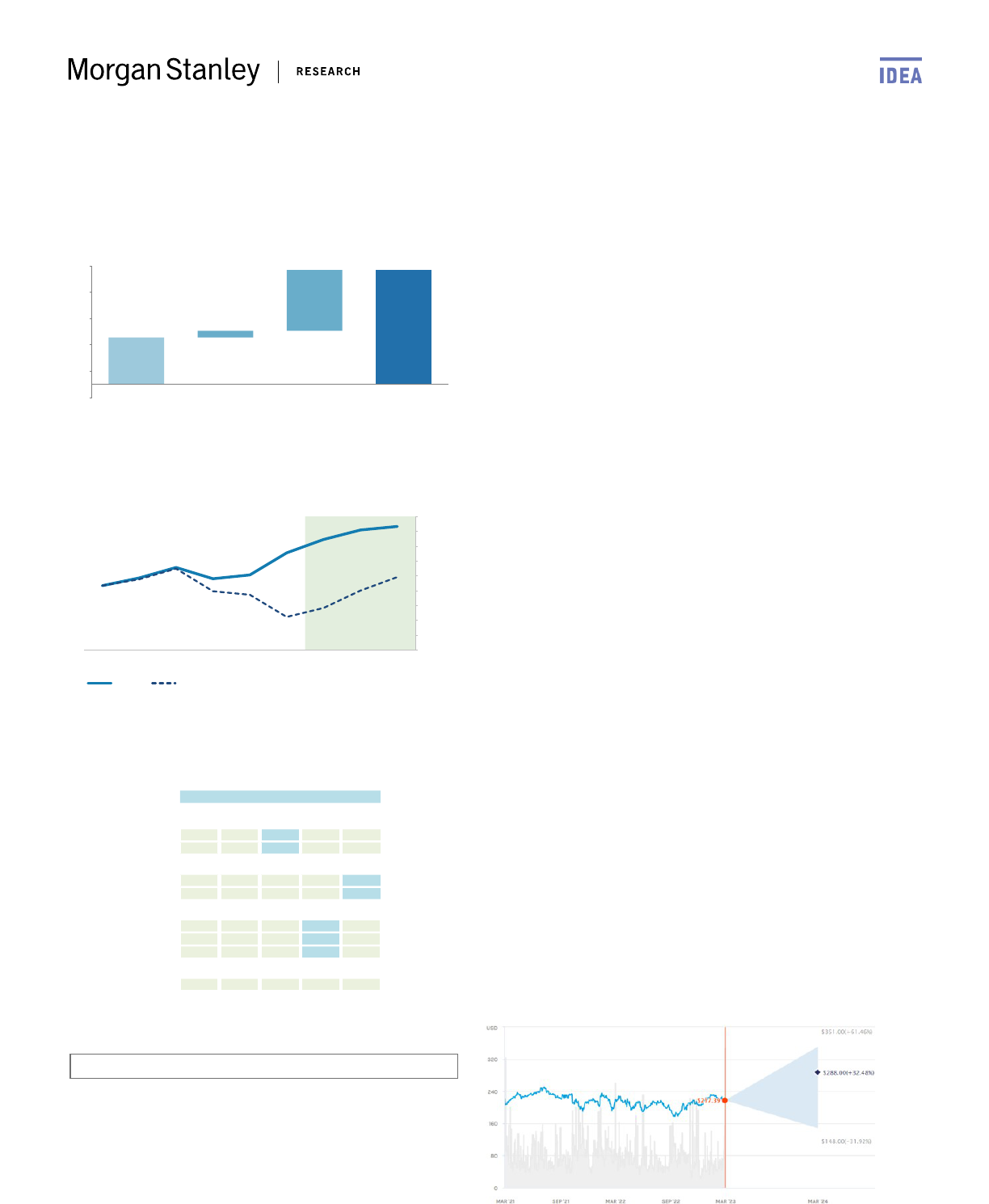
Visa (V)
Value of Growth Analysis
89
217
+13
+115
-25
25
75
125
175
225
Current Earnings Growth in Explicit Forecast
Period
Long-Term Growth Current Price
Return on Net Operating Assets (RNOA) Analysis
0%
5%
10%
15%
20%
25%
30%
35%
40%
45%
2017 2018 2019 2020 2021 2022 2023 2024 2025
company sector peer median
Sector Yardsticks
Sector Yardsticks
Visa Inc. vs. Sector Peers
Peer
percentile range (vs. sector peers)
median
Growth
0 20 40 60 80 100
EPS '23-'25 CAGR
14.4%
14.6%
Sales '23-'25 CAGR
11.9%
11.0%
Returns
RNOA
37.2%
14.1%
EBIT margin
67.9%
19.0%
Valuation
P/E
25.4x
17.0x
EV/EBIT
20.7x
15.9x
P/FCF
26.5x
16.9x
Leverage
Net Debt/EBITDA 1.3x
Visa Inc.
Note: Sector Yardstick metrics - Returns: 2023e; Valuation: 2023e; Leverage 2023e. (Net Debt/EBITDA
and P/FCF could be NM) Source: Morgan Stanley Research
Payments and Processing Industry View: Attractive
James Faucette
Visa runs one of the largest centralized consumer payment
networks globally, processing US$11.6tr in payment volume
in FY22. Its low-cost network, significant operating leverage,
and enhanced risk detection capabilities enable it to price
competitively vs. new players. Visa is presently operating at
scale, while any new market entrants need to balance low
network fees (to remain attractive vs. Visa) with continued
investment in their platforms, high costs to drive user
growth, and limited benefits of scale. This means that Visa is
well-positioned to underprice competitors to retain market
share globally, if needed.
Visa is a key beneficiary of resilient consumer spending
worldwide and consumers' / businesses' ongoing migration
from cash to electronic payments. Trends toward
digitization (mCommerce and eCommerce) over the years
should allow Visa’s growth to outpace overall global PCE
growth, while any rise in inflation should serve as a tailwind
to the business, with ~2/3 of revenue tied to volumes. The
continuation of the cross-border-travel recovery, still not
beyond the pre-Covid trend line, will also benefit Visa given
its higher-than-average yields.
B2B payments represent a large untapped market for Visa,
where innovation has significantly lagged the consumer
payments market with an estimated ~45% of B2B payments
still made via checks. Increasing investment in modernizing
B2B payments opens up a new large TAM for Visa, as it
finds new applications for Visa Direct and its other offerings.
We think the electronification of payments and B2B should
be enough to support double-digit compounding earnings
growth for Visa, driving mid-teens returns in coming years.
Risk Reward: Overweight / Price Target $288
34
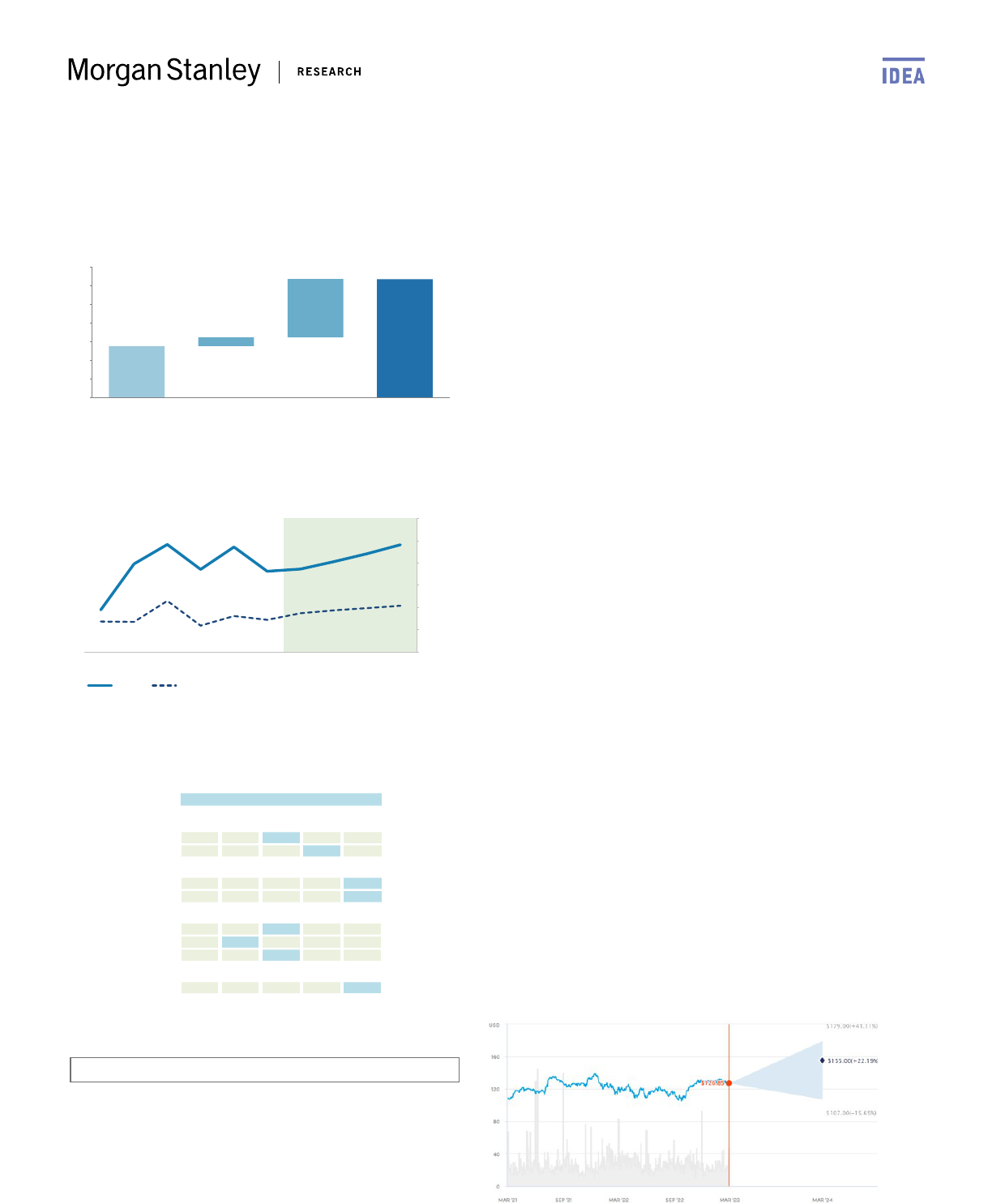
Yum! Brands (YUM)
Value of Growth Analysis
55
127
+9
+62
0
20
40
60
80
100
120
140
Current Earnings Growth in Explicit Forecast
Period
Long-Term Growth Current Price
Return on Net Operating Assets (RNOA) Analysis
0%
20%
40%
60%
80%
100%
120%
2017 2018 2019 2020 2021 2022 2023 2024 2025 2026
company sector peer median
Sector Yardsticks
Sector Yardsticks
Yum! Brands, Inc. vs. Sector Peers
Peer
percentile range (vs. sector peers)
median
Growth
0 20 40 60 80 100
EPS '23-'25 CAGR
15.1%
15.1%
Sales '23-'25 CAGR
8.0%
6.7%
Returns
RNOA
74.4%
34.7%
EBIT margin
32.8%
17.7%
Valuation
P/E
25.2x
25.2x
EV/EBIT
19.9x
20.1x
P/FCF
27.2x
27.2x
Leverage
Net Debt/EBITDA
4.9x
4.4x
Yum! Brands, Inc.
Note: Sector Yardstick metrics - Returns: 2023e; Valuation: 2023e; Leverage 2023e. (Net Debt/EBITDA
and P/FCF could be NM) Source: Morgan Stanley Research
Restaurants Industry View: In-Line
Brian Harbour
A globally diversified, multi-brand fast food franchisor.
YUM's portfolio includes KFC, Taco Bell, Pizza Hut, and the
Habit Burger Grill, with 98% of its 55k+ stores franchised,
across 155+ countries. YUM is one of few globally scaled
and diversified operators we think can sustain close to 6%
store growth and high-single-digit system sales growth over
the next several years, driving low- to mid-teens EPS
growth. YUM's franchised model is among the most asset-
light, cash generative, and offers lower earnings volatility.
Better prospects for sustaining higher unit growth: While
5% global unit growth is the new target vs. 4% prior, YUM is
running ~6% today with solid execution evident over the
past 2 years in a tough environment. 15+ int'l franchisees are
publicly listed, well capitalized, and relatively consolidated,
which underlies this growth and diversifies it beyond mainly
China. Taco Bell Int'l should be an accelerating source of
growth and KFC is fast growing in emerging markets.
Brand and franchisee strength is higher than in prior
downturns: KFC and Pizza Hut US have been shrinking
brands in the US but are on better footing today. Broadly,
brand positioning, menu, and store footprints are in better
shape and digital channels are built out, helping KFC and PH
compete in any economic environment and any country.
Sales drivers include China, digital expansion: China, almost
10% of revenue, was a drag on sales in '22, but should be a
tailwind from here. Much of YUM's newer digital tools are
just at the point of scaling and beginning to drive sales /
franchisee profits. As a multi-brand operator with leading
scale, few companies can invest in these in a similar fashion.
Risk Reward: Overweight / Price Target $155
35

Morgan Stanley is acting as financial advisor to Cogent Communications Holdings, Inc.
(“Cogent") in relation to its definitive agreement to acquire T-Mobile US, Inc.’s Wireline
Business, as announced on September 7, 2022. The proposed acquisition is subject to receipt
of regulatory approvals and other customary closing conditions. Cogent has agreed to pay
fees to Morgan Stanley for its financial services. Please refer to the notes at the end of this
report.
Morgan Stanley is acting as financial advisor to Activision Blizzard Inc. ("Activision") in
relation to its agreement to be acquired by Microsoft Corp., as announced on January 18,
2022. The proposed acquisition is subject to customary closing conditions and completion
of regulatory review. Activision has agreed to pay fees to Morgan Stanley for its services.
Please refer to the notes at the end of this report.
36

Disclosure Section
The information and opinions in Morgan Stanley Research were prepared by Morgan Stanley & Co. LLC, and/or Morgan Stanley C.T.V.M. S.A., and/or Morgan
Stanley Mexico, Casa de Bolsa, S.A. de C.V., and/or Morgan Stanley Canada Limited. As used in this disclosure section, "Morgan Stanley" includes Morgan
Stanley & Co. LLC, Morgan Stanley C.T.V.M. S.A., Morgan Stanley Mexico, Casa de Bolsa, S.A. de C.V., Morgan Stanley Canada Limited and their affiliates
as necessary.
For important disclosures, stock price charts and equity rating histories regarding companies that are the subject of this report, please see the Morgan
Stanley Research Disclosure Website at www.morganstanley.com/researchdisclosures, or contact your investment representative or Morgan Stanley
Research at 1585 Broadway, (Attention: Research Management), New York, NY, 10036 USA.
For valuation methodology and risks associated with any recommendation, rating or price target referenced in this research report, please contact the Client
Support Team as follows: US/Canada +1 800 303-2495; Hong Kong +852 2848-5999; Latin America +1 718 754-5444 (U.S.); London +44 (0)20-7425-8169;
Singapore +65 6834-6860; Sydney +61 (0)2-9770-1505; Tokyo +81 (0)3-6836-9000. Alternatively you may contact your investment representative or Morgan
Stanley Research at 1585 Broadway, (Attention: Research Management), New York, NY 10036 USA.
Analyst Certification
The following analysts hereby certify that their views about the companies and their securities discussed in this report are accurately expressed and that they
have not received and will not receive direct or indirect compensation in exchange for expressing specific recommendations or views in this report: Vincent
Andrews; David Arcaro, CFA; Michael J. Cyprys, CFA, CPA; Diane Ding, Ph.D.; James E Faucette; Simon Flannery; Terence C Flynn, Ph.D.; Stephen W
Grambling; Betsy L. Graseck, CFA; Simeon Gutman, CFA; Brian Harbour, CFA; Toni Kaplan; Kristine T Liwag; Meta A Marshall; Devin McDermott; Dara
Mohsenian, CFA; Brian Nowak, CFA; Andrew B Pauker; Joshua C Pokrzywinski; Drew Ranieri; Tejas Savant; Alex Straton; Benjamin Swinburne, CFA;
Michelle M. Weaver, CFA; Keith Weiss, CFA; Michael J Wilson; Erin Wright.
.
Global Research Conflict Management Policy
Morgan Stanley Research has been published in accordance with our conflict management policy, which is available at
www.morganstanley.com/institutional/research/conflictpolicies. A Portuguese version of the policy can be found at www.morganstanley.com.br
Important Regulatory Disclosures on Subject Companies
The analyst or strategist (or a household member) identified below owns the following securities (or related derivatives): Vincent Andrews - Alphabet Inc.
(common or preferred stock), Blackstone Inc.(common or preferred stock), Cheniere Energy Inc(common or preferred stock), Microsoft(common or preferred
stock), MSCI Inc.(common or preferred stock), Nike Inc.(common or preferred stock), Visa Inc.(common or preferred stock); Diane Ding, Ph.D. - Visa Inc.
(common or preferred stock); James E Faucette - Alphabet Inc.(common or preferred stock), Blackstone Inc.(common or preferred stock), Microsoft(common
or preferred stock), UnitedHealth Group Inc(common or preferred stock); Terence C Flynn, Ph.D. - Costco Wholesale Corp(common or preferred stock), Eaton
Corporation PLC(common or preferred stock), Estee Lauder Companies Inc(common or preferred stock), Exxon Mobil Corporation(common or preferred stock),
JPMorgan Chase & Co(common or preferred stock), MasterCard Inc(common or preferred stock), Microsoft(common or preferred stock), Nike Inc.(common or
preferred stock), Northrop Grumman Corp.(common or preferred stock), Prologis, Inc.(common or preferred stock), T-Mobile US, Inc.(common or preferred
stock), Visa Inc.(common or preferred stock); Betsy L. Graseck, CFA - Alphabet Inc.(common or preferred stock), Exxon Mobil Corporation(common or
preferred stock), MasterCard Inc(common or preferred stock), NextEra Energy Inc(common or preferred stock), Visa Inc.(common or preferred stock); Simeon
Gutman, CFA - Liberty Formula One(common or preferred stock), UnitedHealth Group Inc(common or preferred stock); Brian Harbour, CFA - JPMorgan Chase
& Co(common or preferred stock); Nicholas Lentini, CFA - Nike Inc.(common or preferred stock); Brian Nowak, CFA - Exxon Mobil Corporation(common or
preferred stock); Joshua C Pokrzywinski - Blackstone Inc.(common or preferred stock), Microsoft(common or preferred stock), UnitedHealth Group
Inc(common or preferred stock); Tejas Savant - JPMorgan Chase & Co(common or preferred stock), MasterCard Inc(common or preferred stock), Motorola
Solutions Inc(common or preferred stock), Novo Nordisk A/S(GDR), UnitedHealth Group Inc(common or preferred stock), Yum! Brands, Inc.(common or
preferred stock); Keith Weiss, CFA - Thermo Fisher Scientific Inc.(common or preferred stock).
As of February 28, 2023, Morgan Stanley beneficially owned 1% or more of a class of common equity securities of the following companies covered in Morgan
Stanley Research: Alphabet Inc., American Express Company, Blackstone Inc., Cheniere Energy Inc, Costco Wholesale Corp, Eaton Corporation PLC, Eli
Lilly & Co., Estee Lauder Companies Inc, Exxon Mobil Corporation, Intuitive Surgical Inc., JPMorgan Chase & Co, Linde PLC, MasterCard Inc, Microsoft,
NextEra Energy Inc, Nike Inc., Northrop Grumman Corp., Prologis, Inc., Thermo Fisher Scientific Inc., UnitedHealth Group Inc, Visa Inc., Yum! Brands, Inc..
Within the last 12 months, Morgan Stanley managed or co-managed a public offering (or 144A offering) of securities of American Express Company, Cheniere
Energy Inc, Eaton Corporation PLC, Eli Lilly & Co., JPMorgan Chase & Co, MasterCard Inc, NextEra Energy Inc, Northrop Grumman Corp., Prologis, Inc., T-
Mobile US, Inc., Thermo Fisher Scientific Inc., UnitedHealth Group Inc.
Within the last 12 months, Morgan Stanley has received compensation for investment banking services from Alphabet Inc., American Express Company,
Blackstone Inc., Cheniere Energy Inc, Eaton Corporation PLC, Eli Lilly & Co., Hilton Worldwide Holdings Inc, JPMorgan Chase & Co, MasterCard Inc, NextEra
Energy Inc, Nike Inc., Northrop Grumman Corp., Novo Nordisk A/S, Prologis, Inc., Thermo Fisher Scientific Inc., UnitedHealth Group Inc.
In the next 3 months, Morgan Stanley expects to receive or intends to seek compensation for investment banking services from Alphabet Inc., American
Express Company, Blackstone Inc., Cheniere Energy Inc, Costco Wholesale Corp, Eaton Corporation PLC, Eli Lilly & Co., Estee Lauder Companies Inc,
Exxon Mobil Corporation, Hilton Worldwide Holdings Inc, Intuitive Surgical Inc., JPMorgan Chase & Co, Linde PLC, Lululemon Athletica Inc., MasterCard Inc,
Microsoft, MSCI Inc., NextEra Energy Inc, Nike Inc., Northrop Grumman Corp., Novo Nordisk A/S, Old Dominion Freight Line Inc, Prologis, Inc., T-Mobile US,
Inc., Thermo Fisher Scientific Inc., UnitedHealth Group Inc, Visa Inc., Yum! Brands, Inc..
Within the last 12 months, Morgan Stanley has received compensation for products and services other than investment banking services from Alphabet Inc.,
American Express Company, Blackstone Inc., Cheniere Energy Inc, Eaton Corporation PLC, Eli Lilly & Co., Exxon Mobil Corporation, Hilton Worldwide
Holdings Inc, JPMorgan Chase & Co, MasterCard Inc, Microsoft, Motorola Solutions Inc, MSCI Inc., NextEra Energy Inc, Nike Inc., Northrop Grumman Corp.,
Novo Nordisk A/S, Old Dominion Freight Line Inc, Prologis, Inc., T-Mobile US, Inc., Thermo Fisher Scientific Inc., UnitedHealth Group Inc, Visa Inc., Yum!
Brands, Inc..
Within the last 12 months, Morgan Stanley has provided or is providing investment banking services to, or has an investment banking client relationship with,
the following company: Alphabet Inc., American Express Company, Blackstone Inc., Cheniere Energy Inc, Costco Wholesale Corp, Eaton Corporation PLC,
Eli Lilly & Co., Estee Lauder Companies Inc, Exxon Mobil Corporation, Hilton Worldwide Holdings Inc, Intuitive Surgical Inc., JPMorgan Chase & Co, Linde
PLC, Lululemon Athletica Inc., MasterCard Inc, Microsoft, MSCI Inc., NextEra Energy Inc, Nike Inc., Northrop Grumman Corp., Novo Nordisk A/S, Old
Dominion Freight Line Inc, Prologis, Inc., T-Mobile US, Inc., Thermo Fisher Scientific Inc., UnitedHealth Group Inc, Visa Inc., Yum! Brands, Inc..
Within the last 12 months, Morgan Stanley has either provided or is providing non-investment banking, securities-related services to and/or in the past has
entered into an agreement to provide services or has a client relationship with the following company: Alphabet Inc., American Express Company, Blackstone
Inc., Cheniere Energy Inc, Eaton Corporation PLC, Eli Lilly & Co., Exxon Mobil Corporation, Hilton Worldwide Holdings Inc, JPMorgan Chase & Co, Linde
PLC, MasterCard Inc, Microsoft, Motorola Solutions Inc, MSCI Inc., NextEra Energy Inc, Nike Inc., Northrop Grumman Corp., Novo Nordisk A/S, Old Dominion
Freight Line Inc, Prologis, Inc., T-Mobile US, Inc., Thermo Fisher Scientific Inc., UnitedHealth Group Inc, Visa Inc., Yum! Brands, Inc..
An employee, director or consultant of Morgan Stanley is a director of Alphabet Inc., Estee Lauder Companies Inc. This person is not a research analyst or a
37

member of a research analyst's household.
Morgan Stanley & Co. LLC makes a market in the securities of Alphabet Inc., American Express Company, Blackstone Inc., Cheniere Energy Inc, Costco
Wholesale Corp, Eaton Corporation PLC, Eli Lilly & Co., Estee Lauder Companies Inc, Exxon Mobil Corporation, Hilton Worldwide Holdings Inc, Intuitive
Surgical Inc., JPMorgan Chase & Co, Liberty Formula One, Lululemon Athletica Inc., MasterCard Inc, Microsoft, Motorola Solutions Inc, NextEra Energy Inc,
Nike Inc., Northrop Grumman Corp., Novo Nordisk A/S, Old Dominion Freight Line Inc, Prologis, Inc., T-Mobile US, Inc., Thermo Fisher Scientific Inc.,
UnitedHealth Group Inc, Visa Inc., Yum! Brands, Inc..
The equity research analysts or strategists principally responsible for the preparation of Morgan Stanley Research have received compensation based upon
various factors, including quality of research, investor client feedback, stock picking, competitive factors, firm revenues and overall investment banking
revenues. Equity Research analysts' or strategists' compensation is not linked to investment banking or capital markets transactions performed by Morgan
Stanley or the profitability or revenues of particular trading desks.
Morgan Stanley and its affiliates do business that relates to companies/instruments covered in Morgan Stanley Research, including market making, providing
liquidity, fund management, commercial banking, extension of credit, investment services and investment banking. Morgan Stanley sells to and buys from
customers the securities/instruments of companies covered in Morgan Stanley Research on a principal basis. Morgan Stanley may have a position in the debt
of the Company or instruments discussed in this report. Morgan Stanley trades or may trade as principal in the debt securities (or in related derivatives) that
are the subject of the debt research report.
Certain disclosures listed above are also for compliance with applicable regulations in non-US jurisdictions.
STOCK RATINGS
Morgan Stanley uses a relative rating system using terms such as Overweight, Equal-weight, Not-Rated or Underweight (see definitions below). Morgan
Stanley does not assign ratings of Buy, Hold or Sell to the stocks we cover. Overweight, Equal-weight, Not-Rated and Underweight are not the equivalent of
buy, hold and sell. Investors should carefully read the definitions of all ratings used in Morgan Stanley Research. In addition, since Morgan Stanley Research
contains more complete information concerning the analyst's views, investors should carefully read Morgan Stanley Research, in its entirety, and not infer the
contents from the rating alone. In any case, ratings (or research) should not be used or relied upon as investment advice. An investor's decision to buy or sell a
stock should depend on individual circumstances (such as the investor's existing holdings) and other considerations.
Global Stock Ratings Distribution
(as of February 28, 2023)
The Stock Ratings described below apply to Morgan Stanley's Fundamental Equity Research and do not apply to Debt Research produced by the Firm.
For disclosure purposes only (in accordance with FINRA requirements), we include the category headings of Buy, Hold, and Sell alongside our ratings of
Overweight, Equal-weight, Not-Rated and Underweight. Morgan Stanley does not assign ratings of Buy, Hold or Sell to the stocks we cover. Overweight,
Equal-weight, Not-Rated and Underweight are not the equivalent of buy, hold, and sell but represent recommended relative weightings (see definitions below).
To satisfy regulatory requirements, we correspond Overweight, our most positive stock rating, with a buy recommendation; we correspond Equal-weight and
Not-Rated to hold and Underweight to sell recommendations, respectively.
COVERAGE UNIVERSE INVESTMENT BANKING CLIENTS (IBC) OTHER MATERIAL
INVESTMENT SERVICES
CLIENTS (MISC)
STOCK RATING
CATEGORY
COUNT % OF
TOTAL
COUNT % OF
TOTAL IBC
% OF
RATING
CATEGORY
COUNT % OF
TOTAL
OTHER
MISC
Overweight/Buy 1353 37% 284 43% 21% 593 38%
Equal-weight/Hold 1664 45% 294 45% 18% 732 47%
Not-Rated/Hold 4 0% 0 0% 0% 0 0%
Underweight/Sell 660 18% 80 12% 12% 232 15%
TOTAL 3,681 658 1557
Data include common stock and ADRs currently assigned ratings. Investment Banking Clients are companies from whom Morgan Stanley received investment
banking compensation in the last 12 months. Due to rounding off of decimals, the percentages provided in the "% of total" column may not add up to exactly
100 percent.
Analyst Stock Ratings
Overweight (O). The stock's total return is expected to exceed the average total return of the analyst's industry (or industry team's) coverage universe, on a
risk-adjusted basis, over the next 12-18 months.
Equal-weight (E). The stock's total return is expected to be in line with the average total return of the analyst's industry (or industry team's) coverage universe,
on a risk-adjusted basis, over the next 12-18 months.
Not-Rated (NR). Currently the analyst does not have adequate conviction about the stock's total return relative to the average total return of the analyst's
industry (or industry team's) coverage universe, on a risk-adjusted basis, over the next 12-18 months.
Underweight (U). The stock's total return is expected to be below the average total return of the analyst's industry (or industry team's) coverage universe, on a
risk-adjusted basis, over the next 12-18 months.
Unless otherwise specified, the time frame for price targets included in Morgan Stanley Research is 12 to 18 months.
Analyst Industry Views
Attractive (A): The analyst expects the performance of his or her industry coverage universe over the next 12-18 months to be attractive vs. the relevant broad
market benchmark, as indicated below.
In-Line (I): The analyst expects the performance of his or her industry coverage universe over the next 12-18 months to be in line with the relevant broad market
benchmark, as indicated below.
Cautious (C): The analyst views the performance of his or her industry coverage universe over the next 12-18 months with caution vs. the relevant broad market
benchmark, as indicated below.
Benchmarks for each region are as follows: North America - S&P 500; Latin America - relevant MSCI country index or MSCI Latin America Index; Europe -
MSCI Europe; Japan - TOPIX; Asia - relevant MSCI country index or MSCI sub-regional index or MSCI AC Asia Pacific ex Japan Index.
38

Important Disclosures for Morgan Stanley Smith Barney LLC & E*TRADE Securities LLC Customers
Important disclosures regarding the relationship between the companies that are the subject of Morgan Stanley Research and Morgan Stanley Smith Barney
LLC or Morgan Stanley or any of their affiliates, are available on the Morgan Stanley Wealth Management disclosure website at
www.morganstanley.com/online/researchdisclosures. For Morgan Stanley specific disclosures, you may refer to
www.morganstanley.com/researchdisclosures.
Each Morgan Stanley research report is reviewed and approved on behalf of Morgan Stanley Smith Barney LLC and E*TRADE Securities LLC. This review and
approval is conducted by the same person who reviews the research report on behalf of Morgan Stanley. This could create a conflict of interest.
Other Important Disclosures
Morgan Stanley & Co. International PLC and its affiliates have a significant financial interest in the debt securities of Alphabet Inc., Cheniere Energy Inc,
Costco Wholesale Corp, Eli Lilly & Co., Estee Lauder Companies Inc, Exxon Mobil Corporation, JPMorgan Chase & Co, MasterCard Inc, Microsoft, Motorola
Solutions Inc, MSCI Inc., NextEra Energy Inc, Nike Inc., Northrop Grumman Corp., Novo Nordisk A/S, T-Mobile US, Inc., Thermo Fisher Scientific Inc.,
UnitedHealth Group Inc, Visa Inc., Yum! Brands, Inc..
A member of Research who had or could have had access to the research prior to completion owns securities (or related derivatives) in the Blackstone Inc.,
Microsoft, T-Mobile US, Inc.. This person is not a research analyst or a member of research analyst's household.
Morgan Stanley Research policy is to update research reports as and when the Research Analyst and Research Management deem appropriate, based on
developments with the issuer, the sector, or the market that may have a material impact on the research views or opinions stated therein. In addition, certain
Research publications are intended to be updated on a regular periodic basis (weekly/monthly/quarterly/annual) and will ordinarily be updated with that
frequency, unless the Research Analyst and Research Management determine that a different publication schedule is appropriate based on current conditions.
Morgan Stanley is not acting as a municipal advisor and the opinions or views contained herein are not intended to be, and do not constitute, advice within the
meaning of Section 975 of the Dodd-Frank Wall Street Reform and Consumer Protection Act.
Morgan Stanley produces an equity research product called a "Tactical Idea." Views contained in a "Tactical Idea" on a particular stock may be contrary to the
recommendations or views expressed in research on the same stock. This may be the result of differing time horizons, methodologies, market events, or other
factors. For all research available on a particular stock, please contact your sales representative or go to Matrix at http://www.morganstanley.com/matrix.
Morgan Stanley Research is provided to our clients through our proprietary research portal on Matrix and also distributed electronically by Morgan Stanley to
clients. Certain, but not all, Morgan Stanley Research products are also made available to clients through third-party vendors or redistributed to clients through
alternate electronic means as a convenience. For access to all available Morgan Stanley Research, please contact your sales representative or go to Matrix at
http://www.morganstanley.com/matrix.
Any access and/or use of Morgan Stanley Research is subject to Morgan Stanley's Terms of Use (http://www.morganstanley.com/terms.html). By accessing
and/or using Morgan Stanley Research, you are indicating that you have read and agree to be bound by our Terms of Use
(http://www.morganstanley.com/terms.html). In addition you consent to Morgan Stanley processing your personal data and using cookies in accordance with
our Privacy Policy and our Global Cookies Policy (http://www.morganstanley.com/privacy_pledge.html), including for the purposes of setting your preferences
and to collect readership data so that we can deliver better and more personalized service and products to you. To find out more information about how Morgan
Stanley processes personal data, how we use cookies and how to reject cookies see our Privacy Policy and our Global Cookies Policy
(http://www.morganstanley.com/privacy_pledge.html).
If you do not agree to our Terms of Use and/or if you do not wish to provide your consent to Morgan Stanley processing your personal data or using cookies
please do not access our research.
Morgan Stanley Research does not provide individually tailored investment advice. Morgan Stanley Research has been prepared without regard to the
circumstances and objectives of those who receive it. Morgan Stanley recommends that investors independently evaluate particular investments and
strategies, and encourages investors to seek the advice of a financial adviser. The appropriateness of an investment or strategy will depend on an investor's
circumstances and objectives. The securities, instruments, or strategies discussed in Morgan Stanley Research may not be suitable for all investors, and
certain investors may not be eligible to purchase or participate in some or all of them. Morgan Stanley Research is not an offer to buy or sell or the solicitation
of an offer to buy or sell any security/instrument or to participate in any particular trading strategy. The value of and income from your investments may vary
because of changes in interest rates, foreign exchange rates, default rates, prepayment rates, securities/instruments prices, market indexes, operational or
financial conditions of companies or other factors. There may be time limitations on the exercise of options or other rights in securities/instruments
transactions. Past performance is not necessarily a guide to future performance. Estimates of future performance are based on assumptions that may not be
realized. If provided, and unless otherwise stated, the closing price on the cover page is that of the primary exchange for the subject company's
securities/instruments.
The fixed income research analysts, strategists or economists principally responsible for the preparation of Morgan Stanley Research have received
compensation based upon various factors, including quality, accuracy and value of research, firm profitability or revenues (which include fixed income trading
and capital markets profitability or revenues), client feedback and competitive factors. Fixed Income Research analysts', strategists' or economists'
compensation is not linked to investment banking or capital markets transactions performed by Morgan Stanley or the profitability or revenues of particular
trading desks.
The "Important Regulatory Disclosures on Subject Companies" section in Morgan Stanley Research lists all companies mentioned where Morgan Stanley
owns 1% or more of a class of common equity securities of the companies. For all other companies mentioned in Morgan Stanley Research, Morgan Stanley
may have an investment of less than 1% in securities/instruments or derivatives of securities/instruments of companies and may trade them in ways different
from those discussed in Morgan Stanley Research. Employees of Morgan Stanley not involved in the preparation of Morgan Stanley Research may have
investments in securities/instruments or derivatives of securities/instruments of companies mentioned and may trade them in ways different from those
discussed in Morgan Stanley Research. Derivatives may be issued by Morgan Stanley or associated persons.
With the exception of information regarding Morgan Stanley, Morgan Stanley Research is based on public information. Morgan Stanley makes every effort to
use reliable, comprehensive information, but we make no representation that it is accurate or complete. We have no obligation to tell you when opinions or
information in Morgan Stanley Research change apart from when we intend to discontinue equity research coverage of a subject company. Facts and views
presented in Morgan Stanley Research have not been reviewed by, and may not reflect information known to, professionals in other Morgan Stanley business
areas, including investment banking personnel.
Morgan Stanley Research personnel may participate in company events such as site visits and are generally prohibited from accepting payment by the
company of associated expenses unless pre-approved by authorized members of Research management.
Morgan Stanley may make investment decisions that are inconsistent with the recommendations or views in this report.
To our readers based in Taiwan or trading in Taiwan securities/instruments: Information on securities/instruments that trade in Taiwan is distributed by Morgan
Stanley Taiwan Limited ("MSTL"). Such information is for your reference only. The reader should independently evaluate the investment risks and is solely
responsible for their investment decisions. Morgan Stanley Research may not be distributed to the public media or quoted or used by the public media without
the express written consent of Morgan Stanley. Any non-customer reader within the scope of Article 7-1 of the Taiwan Stock Exchange Recommendation
Regulations accessing and/or receiving Morgan Stanley Research is not permitted to provide Morgan Stanley Research to any third party (including but not
limited to related parties, affiliated companies and any other third parties) or engage in any activities regarding Morgan Stanley Research which may create or
give the appearance of creating a conflict of interest. Information on securities/instruments that do not trade in Taiwan is for informational purposes only and is
not to be construed as a recommendation or a solicitation to trade in such securities/instruments. MSTL may not execute transactions for clients in these
39

securities/instruments.
Morgan Stanley is not incorporated under PRC law and the research in relation to this report is conducted outside the PRC. Morgan Stanley Research does
not constitute an offer to sell or the solicitation of an offer to buy any securities in the PRC. PRC investors shall have the relevant qualifications to invest in
such securities and shall be responsible for obtaining all relevant approvals, licenses, verifications and/or registrations from the relevant governmental
authorities themselves. Neither this report nor any part of it is intended as, or shall constitute, provision of any consultancy or advisory service of securities
investment as defined under PRC law. Such information is provided for your reference only.
Morgan Stanley Research is disseminated in Brazil by Morgan Stanley C.T.V.M. S.A. located at Av. Brigadeiro Faria Lima, 3600, 6th floor, São Paulo - SP,
Brazil; and is regulated by the Comissão de Valores Mobiliários; in Mexico by Morgan Stanley México, Casa de Bolsa, S.A. de C.V which is regulated by
Comision Nacional Bancaria y de Valores. Paseo de los Tamarindos 90, Torre 1, Col. Bosques de las Lomas Floor 29, 05120 Mexico City; in Japan by
Morgan Stanley MUFG Securities Co., Ltd. and, for Commodities related research reports only, Morgan Stanley Capital Group Japan Co., Ltd; in Hong Kong
by Morgan Stanley Asia Limited (which accepts responsibility for its contents) and by Morgan Stanley Bank Asia Limited; in Singapore by Morgan Stanley
Asia (Singapore) Pte. (Registration number 199206298Z) and/or Morgan Stanley Asia (Singapore) Securities Pte Ltd (Registration number 200008434H),
regulated by the Monetary Authority of Singapore (which accepts legal responsibility for its contents and should be contacted with respect to any matters
arising from, or in connection with, Morgan Stanley Research) and by Morgan Stanley Bank Asia Limited, Singapore Branch (Registration number
T14FC0118J); in Australia to "wholesale clients" within the meaning of the Australian Corporations Act by Morgan Stanley Australia Limited A.B.N. 67 003 734
576, holder of Australian financial services license No. 233742, which accepts responsibility for its contents; in Australia to "wholesale clients" and "retail
clients" within the meaning of the Australian Corporations Act by Morgan Stanley Wealth Management Australia Pty Ltd (A.B.N. 19 009 145 555, holder of
Australian financial services license No. 240813, which accepts responsibility for its contents; in Korea by Morgan Stanley & Co International plc, Seoul
Branch; in India by Morgan Stanley India Company Private Limited; in Canada by Morgan Stanley Canada Limited; in Germany and the European Economic
Area where required by Morgan Stanley Europe S.E., authorised and regulated by Bundesanstalt fuer Finanzdienstleistungsaufsicht (BaFin) under the
reference number 149169; in the US by Morgan Stanley & Co. LLC, which accepts responsibility for its contents. Morgan Stanley & Co. International plc,
authorized by the Prudential Regulatory Authority and regulated by the Financial Conduct Authority and the Prudential Regulatory Authority, disseminates in
the UK research that it has prepared, and approves solely for the purposes of section 21 of the Financial Services and Markets Act 2000, research which has
been prepared by any of its affiliates. RMB Morgan Stanley Proprietary Limited is a member of the JSE Limited and A2X (Pty) Ltd. RMB Morgan Stanley
Proprietary Limited is a joint venture owned equally by Morgan Stanley International Holdings Inc. and RMB Investment Advisory (Proprietary) Limited, which is
wholly owned by FirstRand Limited. The information in Morgan Stanley Research is being disseminated by Morgan Stanley Saudi Arabia, regulated by the
Capital Market Authority in the Kingdom of Saudi Arabia , and is directed at Sophisticated investors only.
The information in Morgan Stanley Research is being communicated by Morgan Stanley & Co. International plc (DIFC Branch), regulated by the Dubai
Financial Services Authority (the DFSA), and is directed at Professional Clients only, as defined by the DFSA. The financial products or financial services to
which this research relates will only be made available to a customer who we are satisfied meets the regulatory criteria to be a Professional Client. A
distribution of the different MS Research ratings or recommendations, in percentage terms for Investments in each sector covered, is available upon request
from your sales representative.
The information in Morgan Stanley Research is being communicated by Morgan Stanley & Co. International plc (QFC Branch), regulated by the Qatar
Financial Centre Regulatory Authority (the QFCRA), and is directed at business customers and market counterparties only and is not intended for Retail
Customers as defined by the QFCRA.
As required by the Capital Markets Board of Turkey, investment information, comments and recommendations stated here, are not within the scope of
investment advisory activity. Investment advisory service is provided exclusively to persons based on their risk and income preferences by the authorized firms.
Comments and recommendations stated here are general in nature. These opinions may not fit to your financial status, risk and return preferences. For this
reason, to make an investment decision by relying solely to this information stated here may not bring about outcomes that fit your expectations.
The following companies do business in countries which are generally subject to comprehensive sanctions programs administered or enforced by the U.S.
Department of the Treasury's Office of Foreign Assets Control ("OFAC") and by other countries and multi-national bodies: MasterCard Inc.
The trademarks and service marks contained in Morgan Stanley Research are the property of their respective owners. Third-party data providers make no
warranties or representations relating to the accuracy, completeness, or timeliness of the data they provide and shall not have liability for any damages relating
to such data. The Global Industry Classification Standard (GICS) was developed by and is the exclusive property of MSCI and S&P.
Morgan Stanley Research, or any portion thereof may not be reprinted, sold or redistributed without the written consent of Morgan Stanley.
Indicators and trackers referenced in Morgan Stanley Research may not be used as, or treated as, a benchmark under Regulation EU 2016/1011, or any other
similar framework.
The issuers and/or fixed income products recommended or discussed in certain fixed income research reports may not be continuously followed. Accordingly,
investors should regard those fixed income research reports as providing stand-alone analysis and should not expect continuing analysis or additional reports
relating to such issuers and/or individual fixed income products.
Morgan Stanley may hold, from time to time, material financial and commercial interests regarding the company subject to the Research report.
© 2023 Morgan Stanley
40
